February 29, 2012
Simon Boccanegra, LA
The production, like the fall’s Eugene Onegin, was not only a first for the company, but happily, starring the company’s director, Plácido Domingo, an even greater artistic success; proving that baritones can be thrilling too.
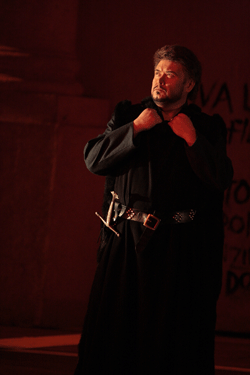 Vitalij Kowaljow as Fiesco
Vitalij Kowaljow as Fiesco
Verdi wrote Simon Boccanegra in 1857. Its libretto is based on a play by Antonio Garcia Guttiérrez, which in turn was based on the life of the Genoese plebeian, who was elected first Doge of Genoa in 1339. Verdi’s opera was not well received. However, nearly twenty-five years later the composer revised its music and used a new libretto created by Arrigo Boito. Boito, a writer and genius of another cut, had already composed Mefistofeles, his only opera. Subsequently he wrote the librettos for Verdi’s last and greatest works, Otello and Falstaff.
Simon Boccanegra’s story involves complicated personal and political intrigues. Like Verdi’s other political operas, Macbeth, for example, it is a dark work whose plot is not driven by romantic love. Five of its six major roles are for male voices. Two duets between bass and baritone are extraordinarily powerful. Like Macbeth, even the revised Simon Boccanegra has never achieved the popularity of other Verdi operas. However, it’s a favorite of mine. Its darkness comes not merely from the essentially male cast, its nasty intrigues, or its minimal romance. Musical darkness pervades the entire work from its key signatures, to its melodic lines, to its orchestration. Heartbreak and sorrow permeate the soul of Simon Boccanegra. And Verdi knew that soul intimately. Like Boccanegra, Verdi had lost a wife and daughters almost on the eve of his ascent to power and fame.
Simon Boccanegra begins with a prologue in which the major characters are introduced. Boccanegra is a young corsair, who is inveigled to accept the newly created post of Doge of Genoa by his manipulative power hungry friend, Paolo. We meet Fiesco, the father of Maria, the young woman Boccanegra loves, who has borne his daughter out of wedlock. Fiesco will forgive Boccanegra for this sin, if the corsair can produce that child. But he cannot. He tells Fiesco that little girl has disappeared. Moments later (and we are still in the prologue) just as Boccanegra discovers that Maria is dead, a joyous crowd arrives to declare him the newly elected Doge.
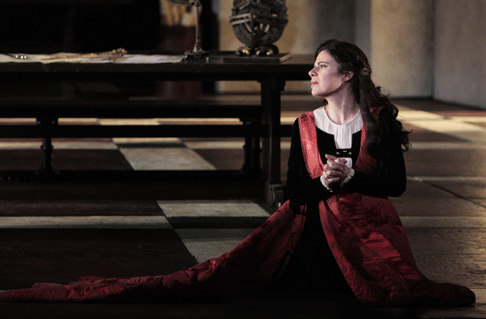 Ana María Martínez as Amelia
Ana María Martínez as Amelia
The first act begins 25 years later. Now Boccanegra and his daughter, Amelia discover each other. Unhappily, Amelia is in love with a tenor named Adorno. who along with Fiesco and Paolo, each for his own reasons, have united as sworn enemies of Boccanegra. The dramatic highlight of Simon Boccanegra is the magnificent Council Chamber scene with its thundering confrontation between Boccanegra and Paolo. Later, Paolo poisons the Doge. Nevertheless, the opera concludes with just punishment and reconciliation. Paolo is executed. Boccanegra tells Fiesco that Amelia is his granddaughter, and in an extraordinarily moving duet, the two old men, Boccanegra and Fiesco are reconciled. Amelia and Adorno marry. Adorno becomes the new Doge of Genoa. And the dying Boccanegra will find his Maria in heaven. If you can get to the pre-opera talk, Maestro Conlon does a marvelous job of unraveling this sleeve of tsouris, and with music, no less!
The darkness of its preceding scenes make our introduction to Amelia, with its brief moment of joy and high notes the only truly bright moment of the work. Interestingly in Amelia’s first aria of love and longing,”Come in quest’ora bruna” sung as she awaits Adorno, Verdi harks back to the rolling oom pah pah bass of his earlier operas. James Conlon warned his audience that they would cry at the recognition scene and sure enough, I did. But I don’t at every performance of this opera. As I said, sometimes everything seems to go right. And this scene certainly did that Sunday afternoon.
The very strong cast of male singers led by Domingo made this possible. The knock on the state of 71-year old singer’s Boccanegra: that his voice is not deep enough for the role, and raspy besides, may be true, but for the performance I saw, all that was irrelevant. With a dark wig and slimming costume, he strode and sang vigorously as the young Boccanegra. As the gray haired Doge, he was a commanding presence. Domingo has always been an excellent actor, and is unsurpassed in the subtleties his voice whether as tenor or baritone, can express in dramatic roles. The Ukrainian bass Vitalij Kowaljow, who sang Fiesco was a joy to hear if like me you thrill to clear, legato bass singing and long held last low notes. Baritone Paolo Gavanelli and bass Robert Pomakov were equally compelling. Stefano Secco, making his LA debut as Adorno, has a bright tenor voice and happily, his Italian could be understood. Anne María Martínez, a Grammy winner for an album she recorded with Domingo, has a rich lyric voice and produced a genuine trill. Kudos for the chorus, which has a large role in the opera. Maestro James Conlon, who confessed a particular affection for this opera, kept a limpid performance rolling at a brisk tempo.
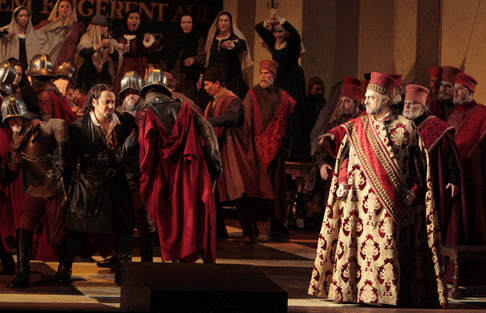 Plácido Domingo (right) as Simon Boccanegra, with Stefano Secco (left) as Gabriele Adorno
Plácido Domingo (right) as Simon Boccanegra, with Stefano Secco (left) as Gabriele Adorno
Well, maybe there were two things that weren’t so right: the lighting and the sets created originally by lighting designer Duane Schuler and Michael Yeargan, respectively, for Covent Garden. They seem to have taken the “darkness” of the opera too literally. Both the prologue and final scene were entirely too dim and shadowed. During the prologue it was sometimes difficult to know who was singing. And I found the depth of the sets troubling. Both the prologue, which takes place in a public square and the Council chamber scene, which employ large choruses, were set on comparatively shallow sets, whereas the intimate scenes: the love scene, the recognition scene and Boccanegra’s death were performed with open depths behind them.
But these are quibbles. A great opera, whether joyous or sorrowful, is foremost about music that enters one’s heart and moves it. And Verdi’s Simon Boccanegra does just that.
Estelle Gilson
image=http://www.operatoday.com/sbc5086.gif image_description=Plácido Domingo as Simon Boccanegra [Photo by Robert Millard courtesy of Los Angeles Opera] product=yes product_title=Giuseppe Verdi: Simon Boccanegra product_by=Simon Boccanegra: Plácido Domingo; Amelia: Ana María Martínez; Jacopo Fiesco: Vitalij Kowaljow; Gabriele Adorno: Stefano Secco; Paolo Albiani: Paolo Gavanelli; Pietro: Roberto Pomakov. Conductor: James Conlon. Director: Elijah Moshinsky. Set Designer: Michael Yeargan. Costume Designer: Peter J. Hall. Lighting Designer: Duane Schuler. product_id=Above: Plácido Domingo as Simon BoccanegraPhotos by Robert Millard courtesy of Los Angeles Opera
Barcelona Restores Cuts
By Frank Cadenhead [Opera Today, 29 February 2012]
Barcelona’s opera, the Gran Teatre del Liceu , has reversed course and restored cuts in the current season made earlier this month. Earlier this month, In response to government cuts in subsidies, the director general Joan Francesco Marco announced closures of the house between March 20 and April 10 and between June 5 and July 8.
Gran Teatre del Liceu Reverses Course
Earlier this month, In response to government cuts in subsidies, the director general Joan Francesco Marco announced closures of the house between March 20 and April 10 and between June 5 and July 8.
The closures were widely criticized in the local press and the staff planned a strike during the run of Puccini’s La bohème which opens this Friday. The labor unions have made some compromises, however, and the budget gap of €3.7 million seems to have been largely closed with these new agreements. Staff reductions and other measures to meet the reduced subsidies are still under review.
The double-bill of Zemlinsky’s operas, The Dwarf and A Florentine Tragedy and the run of Debussy’s Pelléas et Mélisande will be performed as scheduled.
Frank Cadenhead
image=http://www.operatoday.com/Liceu_logo.gif image_description=Gran Teatre del Liceu logo product=yes product_title=Gran Teatre del Liceu Reverses Course product_by=By Frank CadenheadFebruary 28, 2012
Rusalka, Royal Opera
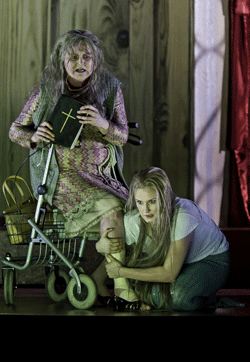 Agnes Zwierko as Ježibaba and Camilla Nylund as Rusalka
Agnes Zwierko as Ježibaba and Camilla Nylund as Rusalka
That is not to say that any production meeting with hostility qualifies as interesting; some, of course, are simply not very good, or worse. Yet, it seems that only the most vapid, unchallenging — and yes, I realise that the word ‘challenging’ is a red rag to self-appointed ‘traditionalist’ bulls — of productions will garner approval from the ranks of the petite bourgeoisie. The boorish behaviour of those who booed this Rusalka equates more or less precisely to the sort of antics they would condemn if they occurred on the street — the work of ‘hoodlums’, the ‘lower classes’, the ‘uneducated’, ‘rioters’, ‘immigrants’, et al. — yet somehow unwillingness or inability to think, the fascistic refusal to consider an alternative point of view, the threat of mob violence, becomes perfectly acceptable when one has paid the asking price for what they consider to be their rightful ‘entertainment’. They would no more bother to understand, to explore, to question, Rusalka were it depicted in the most ‘traditional’ of fashions, of course, but they explode at the mere suggestion that a work and a performance might ask something of them. For, as John Stuart Mill famously noted, ‘Although it is not true that all conservatives are stupid people, it is true that most stupid people are conservative.’ Wagner’s ‘emotionalisation of the intellect’ — ‘emotionalisation’, not abdication! — remains as foreign a country to them as it did to the Jockey Club thugs who prevented Tannhäuser from being performed in Paris; at least one might claim that the latter were having to deal with challenging ‘new music’, Zukunftsmuik, even. Here they were faced with an opera by Dvořák, first performed in 1901, in a staging that would barely raise an eyebrow in most German house or festivals. (The production, by Jossi Wieler and Sergio Morabito, hails initially from the Salzburg Festival.) It would be interesting to know how many of those booing had selfishly, uncomprehendingly disrupted a recent Marriage of Figaro in the same house by erupting into laughter at the very moment Count Almaviva sought forgiveness from the Countess. (There was also, bizarrely, to be heard at the opening of the third act a shouted call from a member of the audience for a ‘free’ Quebec.)
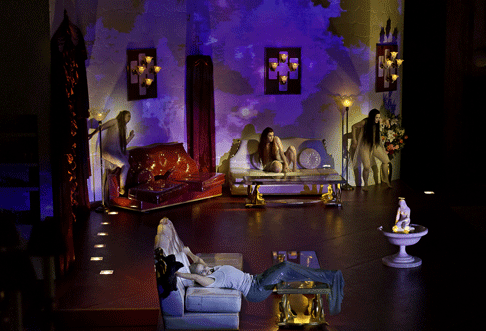 Scene from Rusalka
Scene from Rusalka
What, then, was it that incurred the wrath of the Tunbridge Wells beau monde? I can only assume that it was for the most part Barbara Ehnes’s sets, since the stage direction (presumably a good part of it from revival director, Samantha Seymour) was more often that not quite in harmony with the urgings and suggestions of Dvořák’s score. (The hostile rarely if ever listen to the music; at best, they follow the surtitles and bridle at deviations from what they imagine the stage directions might have been.) Even modern dress is mixed with a sense of the magical, the environment of Ježibaba the witch a case in point. There is even a cat, played both in giant form by Claire Talbot, and in real form, by — a cat, ‘Girlie’. What is real, and what is not? Collision between spirit and human worlds is compellingly brought to life, the devils and demons of a heathen past, including Slavonic river spirits (rusalki) come to tempt, to question, to lay bare the delusions of moralistic, bigoted modernity. Just as modern ‘love’ and marriage’ quickly boil down to money and power, so Vodník the water goblin finds his tawdry place of temptation whilst issuing his moralistic warnings. (Did the audience see itself reflected in the mirror? Perhaps, though I doubt that it even bothered to think that far.) Our ideas of Nature having been hopelessly compromised by what we have become, we ‘naturally’ see the world of rusalki from within the comforts of our hypocritical bordello. Who is exploiting whom, and who is ‘impure’? The souls of women who have committed suicide and of stillborn children — there are various accounts of who the rusalki actually are — or those who shun them in life and in death? Wieler and Morabito do not offer agitprop; rather they allow us to ask these questions of the work, and of ourselves. But equally importantly, they permit a sense of wonder to suffuse what remains very much a fairy tale, realism coexisting with, being corrected by, something older, more mysterious, more dangerous, and perhaps ultimately liberating. Chris Kondek’s video designs, not unlike the hydroelectric dam of Patrice Chéreau’s ‘Centenary’ Ring, both suggest Nature and through their necessary technological apparatus remind us of our distance from any supposed ‘Golden Age’, just as the opening scene will inevitably suggest to us Alberich, the Rhinemaidens, and the power of the erotic. (Wagner used the term liebesgelüste.)
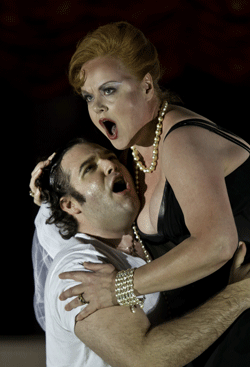 Bryan Hymel as Prince and Petra Lang as Foreign Princess
Bryan Hymel as Prince and Petra Lang as Foreign Princess
Musical performances were equally strong, in many respects signalling a triumph for Covent Garden. First and foremost should be mentioned Yannick Nézet-Séguin, making his Royal Opera debut. The orchestra played for him as if for an old friend, offering a luscious, long-breathed Romanticism that made it sound a match — as, on its best days, it is — for any orchestra in the world. Magic was certainly to be heard: the sound of Dvořák’s harps again took me back to Das Rheingold — and to Bernard Haitink’s tenure at the house. Ominous fate was brought into being with similar conviction and communicative skill. Above all, Nézet-Séguin conveyed both a necessary sense of direction and a love for the score’s particular glories. If there are times when Dvořák might benefit from a little more, at least, of Janáček’s extraordinary dramatic concision, it would take a harder heart than mine to eschew the luxuriance on offer both in score and performance. Crucially, staging and performance interacted so that the contrast between worlds on stage intensified that in the pit, and vice versa.
Camilla Nylund shone in the title role. At times, especially during the first act, one might have wondered whether her voice would prove to have the necessary heft, but it did, and Nylund proved herself an accomplished actress into the bargain. Bryan Hymel may not be the most exciting of singers; the voice is not especially variegated. However, he proved dependable, and often a great deal more, the final duet as moving as one could reasonably expect. Alan Held was everything a Vodník should be: baleful, threatening, sincere, and yet perhaps not quite. The Spirit of the Lake may well have his own agenda — and certainly did here. Agnes Zwierko played the witch Ježibaba with wit, menace, and a fine sense of hypocrisy that brought the closed environments of Janáček’s dramas to mind. The four Jette Parker Young Artists participating, nymphs Anna Devin, Madeleine Perard, and Justina Gringyte, and Huntsman Daniel Grice all acquitted themselves with glowing colours. Indeed, Grice’s solo, enveloped by miraculous Freischütz-like horns from the orchestra, movingly evoked a world of lost or never-existent woodland innocence. Last but not least, Petra Lang’s Foreign Princess emerged, like Wagner’s Ortrud, as in some respects the most truthful, as well as the most devious, character of all. Splendidly sung and acted, Lang’s was a performance truly to savour. But then, this was a performance as a whole that was far more than the sum of its parts, a triumphant return to form for Covent Garden with its first ever staging of the work.
Mark Berry
image=http://www.operatoday.com/Rusalka_ROH_2012_01.gif image_description=Camilla Nylund as Rusalka [Photo by Clive Barda/ROH] product=yes product_title=Antonín Dvořák: Rusalka product_by=Rusalka: Camilla Nylund; Foreign Princess: Petra Lang; Prince: Bryan Hymel; Ježibaba: Agnes Zwierko; Vodník: Alan Held; Huntsman: Daniel Grice; Gamekeeper: Gyula Orendt; Kitchen Boy: Ilse Eerens; Wood Nymphs: Anna Devin, Justina Gringyte, Madeleine Pierard; Mourek: Claire Talbot. Directors: Jossi Wieler, Sergio Morabito; Revival Director: Samantha Seymour; Set Designs: Barbara Ehnes; Costumes: Anja Rabes; Lighting: Olaf Freese; Video Designs: Chris Kondek; Choreography: Altea Garrido. Royal Opera Chorus (chorus master: Renato Balsadonna); Orchestra of the Royal Opera House/ Yannick Nézet-Seguin (conductor). Royal Opera House, Covent Garden, London, Monday 27 February 2012. product_id=Above: Camilla Nylund as RusalkaPhotos by Clive Barda/ROH
Beatrice and Benedict at the Wales Millennium Centre
Throughout his career Berlioz had a rather distinctive way with the form of a piece, so it is perhaps inevitable that an opéra comique written by him would not be straightforward. Beatrice and Benedict is his final dramatic work, a piece that is small scale partly because Berlioz’s health would not allow him to write anything bigger and partly because that was what was suitable for a summer entertainment at the spa of Baden-Baden. Stagings of the piece are relatively rare so it was with great pleasure that I anticipated WNO’s performance of the opera, doubly so as it was to be a revival of Elijah Moshinsky’s 1994 production, beautifully designed by Michael Yeargan (sets) and Dona Granata (costumes).
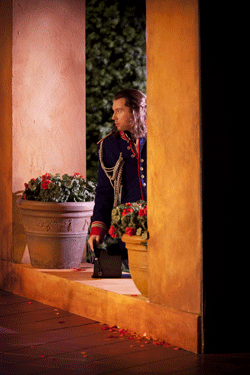 Robin Tritschler as Benedict
Robin Tritschler as Benedict
The work was performed in English with spoken dialogue adapted from Shakespeare’s play by Elijah Moshinsky and revival director Robin Tebbutt. Now the British, as a rule, are not very good at opéra comique, something awful seems to happen when the works cross the channel — Offenbach turns into G & S and anything more serious gets just plain embarrassing. Recent performances of the opera in London have tended to be concerts, in which the dialogue was either spoken by actors or replaced by a spoken narration, neither solution very satisfactory. With Beatrice and Benedict the problem is worse because people insist on trying to turn the piece back into a musical version of Much Ado About Nothing rather than sticking with a French opéra comique. In Cardiff we had dialogue cut to the bone, but spoken in a language which veered awkwardly between direct quotation from Shakespeare and more modern idiom.
I had heard wonderful reports of the original 1994 production Elijah Moshinsky production, but somehow the magic does not seems to have survived. The set looked lovely, ravishing in fact, with Paul Woodfield now in charge of Howard Harrison’s original lighting plot. But the set was designed for the far smaller stage of the New Theatre in Cardiff. And its rigidly architectural form meant that not only did the set look narrow, but sight lines were not ideal; it is a shame that somehow it could not have been opened up somewhat. The setting was 19th century Sicily, with the ladies in big crinoline dresses and an architectural loggia doing admirable service for all scenes in the opera.
Musically we got off to a good start with a sparkling account of the overture under Michael Hofstetter. The spoken dialogue got off to a bad start with Michael Clifton-Thompson’s Leonato having to deliver his lines with his back to the audience.
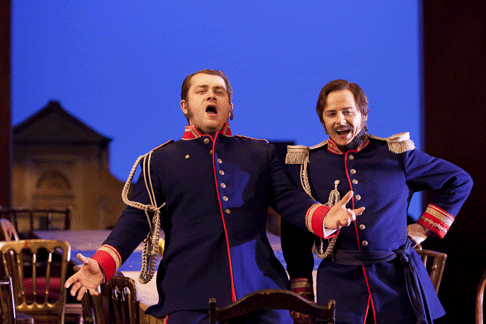 Gary Griffiths as Claudio and Piotr Lempa as Don Pedro
Gary Griffiths as Claudio and Piotr Lempa as Don Pedro
Sarah Fulgoni’s Beatrice looked lovely and she spoke her dialogue quite aptly. But there was something of a mis-match between her nice, well-modulated speaking voice and the incredibly richly upholstered tones of her mezzo-soprano voice. Here was a Beatrice who, though intelligent and musical, simply failed to sound like the sharp-witted Beatrice that we expect. There were moments of great beauty, particularly in Beatrice’s long solo in Act 2 when she comes to accept that she loves Benedict, but the as a whole the character failed to take off. Perhaps, this is partly because there was simply too little spark between Fulgoni and Robin Tritschler’s Benedict.
If Fulgoni’s voice seemed overly rich for her role, Tritschler’s lyric tenor seemed in danger of being too light for Benedict. Under pressure his voice seemed to turn a trifle too reedy and you wondered whether this was ideal repertoire for him. He encompassed Benedict’s solos melodiously and was and entirely willing and capable actor. But the essential spark was not there, his relationship with Beatrice just didn’t crackle with energy the way it should.
Both Fulgoni and Tritschler were entirely capable, but unfortunately Donald Maxwell as Somarone gave us an object lesson in how to take control of the stage whether speaking or singing. Somarone the learned music master can be a rather tedious character and Maxwell did rather over do things by including topical references into his speeches. But as a demonstration of how to capture the attention of an audience, he could not be faulted.
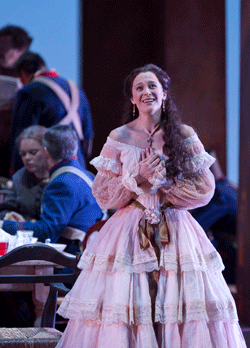 Laura Mitchell as Hero
Laura Mitchell as Hero
Laura Mitchell and Gary Griffiths played Hero and Claudio. Unfortunately in the opera Claudio is reduced to a cipher and as there is no one to impede their love, Hero has only to be delightfully in love. This Mitchell did beautifully, looking and sounding ravishing. She and Anna Burford as Ursula brought Act 1 to a ravishing close with their duet; one of the moments when music, drama and visuals came together in a moment of perfection which gave a hint at the pleasure the production must have given when new.
The role of Don Pedro is musically very small, but the character is quite a player in the spoken dialogue; Piotr Lempa, the only non-native English speaker in the cast, coped brilliantly nevertheless.
Under Michael Hofstetter the orchestra gave a sympathetic account of Berlioz’s score. Hofstetter’s biography in the programme book described him as a baroque specialist though he seems to have been venturing into wider water recently, with productions including Tristan und Isolde, and conducted Beatrice and Benedict at Houston Grand Opera in 2008.
This was one of the evenings in the theatre which does not quite catch fire, though nothing really goes wrong either. As Beatrice and Benedict is revived so rarely, I did so want it to be so much more; that said there were many incidental beauties along the way.
Robert Hugill
Click here for a photo gallery of this production.
image=http://www.operatoday.com/BB_WNO_14.gif image_description=Sara Fulgoni as Beatrice [Photo by Johan Persson courtesy of Welsh National Opera] product=yes product_title=Hector Berlioz: Beatrice and Benedict product_by=Beatrice: Sara Fulgoni; Benedict: Robin Tritschler; Don Pedro: Piotr Lempa; Leonato: Michael Clifton-Thompson; Hero: Laura Mitchell; Claudio: Gary Griffiths; Ursula: Anna Burford; Somarone: Donald Maxwell; Messenger: Stephen Wells. Housekeeper: Helen Greenaway. Orchestra and Chorus of Welsh National Opera. Conductor: Michael Hofstetter. Director: Elijah Moshinsky. Revival Director: Robin Tebbutt. Designer: Michael Yeargan. Costume Designer: Dona Granata. Lighting Designer: Howard Harrison. Lighting realised by: Paul Woodfield. Welsh National Opera, Wales Millenium Centre, 26th February 2012. product_id=Above: Sara Fulgoni as BeatricePhotos by Johan Persson courtesy of Welsh National Opera
February 27, 2012
The Opera House that Almost Wasn’t — Le Palais Garnier in Paris
Non-aficionados of the opera are familiar with the 1,900 plus-seat landmark theater. Tourists are in awe by its fine example of Beaux-Arts. The Palais Garnier is a prime stop on numerous sightseeing tours.
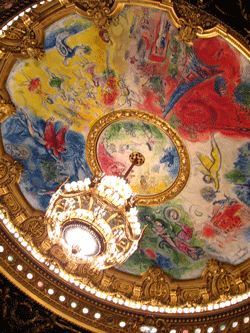 Chandelier at the Palais Garnier [Photo by Minor Keys]
Chandelier at the Palais Garnier [Photo by Minor Keys]
Even those who never visited the “City of Light” are acquainted with the Palais Garnier through Gaston Leroux’s Phantom of the Opera, written in 1910.
Leroux was a frequent visitor and explored the backstage areas and inner sanctions. One tragedy aided in his literary work, and Leroux took poetic license in his novel, when a portion of a chandelier fell and killed one of the opera patrons.
The Palais Garnier has gone through several name changes since its opening. Many simply refer to it as the Paris Opéra.
The Palais Garnier’s history began as part of the great improvement projects instrumented by Napoleon III and Baron Georges-Eugène Haussmann. Napoleon III formulated a competition in search of an architect to design the structure to rival any of the existing opera houses in Italy.
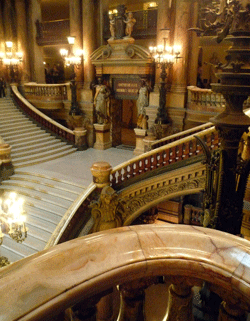 The Grand Stair [Photo by Steven Zucker]
The Grand Stair [Photo by Steven Zucker]
Charles Garnier, a relatively unknown with limited on-hands experience, was awarded the project in 1860. Construction was disrupted by various incidences, including the back up of water from the aquifer, lack of funding, the Franco-Prussian War and the demise of Napoleon III’s Empire.
The incomplete structure was used in part as a storage warehouse for food supplies. Residents wanted it to be demolished since it represented a fallen empire.
Garnier persevered and continued by utilizing new techniques to architecture design. He disliked metal but knew he needed to use these materials in the building’s construction. However, he carefully concealed the metal from view. For cost saving measures, he used the innovative “gilding effect” to replace traditional gold leaves.
When finally launched 15 years later, Fromental Halévy’s La Juive was the inaugural production on January 5th, 1875 . Audiences noted all the ornamental detailing, including sculptures the renowned composers ablaze in bronze and paintings illustrating musical symbols. Equally compelling, the Grand Staircase, which leads into the multi-level theater, is a show-stopping feature measured by its marble of various hues.
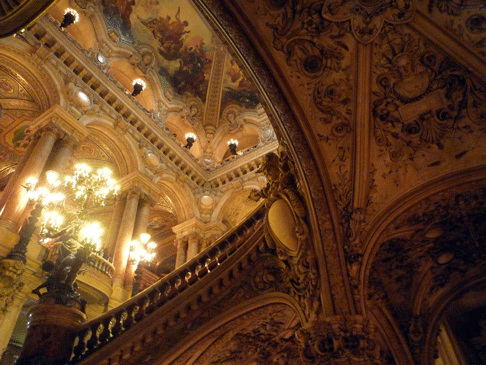 The Grand Stair from Below [Photo by Steven Zucker]
The Grand Stair from Below [Photo by Steven Zucker]
At the entrance, immense mirrors allow patrons to become a part of the building’s interior décor. The vast and richly decorated foyers set the audience’s stage with pleasing scenes to stroll through during intermission.
The fortitude of creativity Charles Garnier shown in his design of the Palais Garnier served as a prototype for other worldwide structures. Examples include The Juliusz Slowacki Theatre in Krakow, Theatro Municipal do Rio de Janeiro, The Jefferson Building in Washington D.C., and National Opera House of Ukraine in Kiev.
Charles Garnier’s ultimate determination was to make the Palais Garnier a palace. Unquestionably he succeeded in his goal.
Veronica Shine
Planning a Visit:
The Palais Garnier is located on 281 Rue Saint-Denis in the district known as the Place de l’Opéra in the 9th arrondissement.
If driving, there is parking at Place Vendôme.
The venue is best reached via Paris’s fine public transportation.
By Métro: Board line nos. 3, 7, 8 to station Opéra
By RER: The regional “A” train closest station is Auber
By Bus: Ride any bus numbered 20, 21, 22, 27, 29, 42, 52, 53, 66, 6 8, 81, 95 directly to the Palais Garnier
The schedule for performances and events are at the Opéra national de Paris’ web site, which also provides a virtual tour of Palais Garnier. Additional nformation on performances and tours is available at the Palais Garnier’s box office, which is open Monday to Saturday from 10:30am to 6:30pm.
Find accommodations near the Palais Garnier at Parishotels.net or search for something with more elbow room with a holiday apartment at holidayapartments.net.
image=http://www.operatoday.com/Palais_Garnier.gif image_description=Facade of Le Palais Garnier product=yes= product_title=The Opera House that Almost Wasn’t — Le Palais Garnier in Paris product_by=By Veronica Shine product_id=Above: Facade of Le Palais GarnierMahler: Symphony No. 9
The nature of the work itself requires the sophisticated engineering found with this release, which allows the subtleties to be heard clearly throughout, from the thing, soft textures at the opening of the first movement to the raucous tutti passages in the Rondo-Burleske. Along with the finesse implicit in the dynamic levels, the ambiance conveys the concerts which are the basis of this release, with the tension and dynamism of the performances. This is an interpretation which contributes to the existing discography of the Ninth Symphony because of the details that Gergiev brings to his reading of this important work from the early twentieth century.
As far as timings are concerned, the proportions match convention, with the first movement, 27:02; the second, 15:10; the third, 12:35; and the Finale, 24:24. The entire work is available on a single disc, packaged nicely with concise liner notes by Stephen Johnson. As useful as the essay is, the performance begs the question of Gergiev’s perspectives on this score. His interpretation of the first movement makes the structure palpable, without sacrificing expression. In this recording the opening measures are nicely detached, an approach that allows the motive to stand out when it recurs. At the same time, the clarity of the string textures is reproduced clearly in this recording, such that the middle voices emerge with ease. The brass are similarly articulate in this movement. The horns are prominent where required, and fit well into the timbres Mahler scored so precisely.
Gergiev’s tempos are spacious, with his pacing supporting both the thematic content and structure. The details are present without slavish adherence to the letter of the score. Gergiev offers an aggressive interpretation of this consummate work of Mahler’s symphonic oeuvre. In balancing the rich romantic sounds of the first movement with the chamber-music-like sonorities it also contains, Gergiev creates a dynamic in which the timbre is as expressive an element of the thematic material. The Coda of the first movement is eloquent in the way the music dissolves into the sonorities with which the structure concludes.
Tempo is critical for the second movement, where Gergiev’s master of the piece is apparent from the start. If Mahler is the master of transition, as one commentator once stated, Gergiev has mastered this aspect of the second movement in allowing the various sections of the piece flow together naturally. Nothing is out of place here, but presented as logically as it is performed with expression. In this performance the middle section is memorably impetuous, such that it sets up the reprise of the opening material effectively.
With the Rondo-Burleske, Gergiev offers an energetic reading of the score. The irony that Mahler composed in this piece is apparent in the style he used in this performance. Beyond the mastery of transitions, Gergiev offers a sense of continuity that allows the ideas to flow convincingly between the individual phrases to create well-articulated passages that bring to musical narrative to an exciting, if breathless conclusion.
Yet in bringing the Ninth to its conclusion, the final movement has the breadth it deserves. While never allowing the movement to languish, Gergiev’s interpretation is particularly moving. As with the first movement, the Finale dissolves into the individual sounds that Mahler used in the concluding section. The interpretation is profound, not maudlin, with the gravity of the Finale balancing the sonata form of the first movement in a recording that elicits repeated hearings. This is a fine performance, which enhances the contributions Gergiev has already made to the Mahler discography with his other releases on LSO Live.
Jim Zychowicz
image=http://www.operatoday.com/LSO_0668.gif image_description=LSO Live 668 product=yes product_title=Gustav Mahler: Symphony No. 9 product_by=London Symphony Orchestra. Valery Gergiev, conductor. product_id=LSO Live 668 [SACD] price=$16.99 product_url=http://www.arkivmusic.com/classical/Drilldown?name_id1=7537&name_role1=1&comp_id=1807&genre=66&bcorder=195&name_id=56888&name_role=3John Adams — Death of Klinghoffer, London
Press reports suggested mass protests against John Adams’s The Death of Klinghoffer at the ENO. But there was just one polite demonstrator, who’d left by the end of the evening. Perhaps he saw the show. The subject is emotive, and important, but Adams’s treatment is not incendiary. It’s the nature of his music. Repetitive, ruminative cadences, which suggest contemplation rather than imposed narrative. Perhaps it’s the very anti-drama in this music that provokes response.
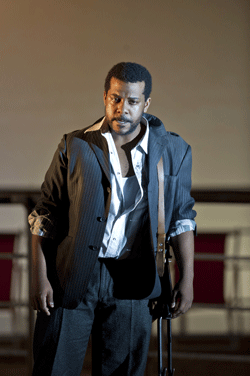 Sidney Outlaw as Rambo
Sidney Outlaw as Rambo
Adams's abstracted cadences evoke blurred boundaries: endless waves on the sea, the whirr of a ship’s engine, the slow ticking away of time. Unfortunately, this music also evokes tedium. Facts about the hijack of the Achille Lauro are projected onto the stage to keep us alert, but the music is saying something else altogether. Furthermore, Adams sets text counter-intuitively, so syntax is distorted in favour of unsettling stresses in places that would not occur in speech. Because our brains don’t process language in this way, meaning is sacrificed. It’s not good when you have to concentrate on sub-titles to figure out what’s being sung. Alice Goodman’s libretto has been criticized for being opaque, but it closely reflects Adams’s musical technique. Images are blurred and shift shape. In the opening Chorus, it’s deliberately unclear who the protagonist is. Is she a young woman in love or an old woman awaiting death? Or both? It’s immaterial. She’s a composite of millions who have been exiled throughout history. When music and text are both this oblique, the thrust of the drama is lost. Perhaps Adams wants us to savour each moment in detail, as we savour life itself, knowing it won’t last, but the cumulative effect of the First Act is soporific.
Things pick up in the Second Act, when Adams frees himself from earnest pseudo-documentary. Up to this point the action has mainly been in choruses. Now we have individuals with whom we can identify. Some of the words they sing come from transcripts made at the time, others are imaginative creations. It doesn’t matter. In these arias there’s dramatic reality. Leon Klinghoffer is presented as a likeable hero, and at last the opera has human focus. Alan Opie sings Klinghoffer so he comes over as a strong, reasonable man of authority, establishing a moral compass. The Aria of the Falling Body anchors Adams’s wavering oscillations with emotional truth.
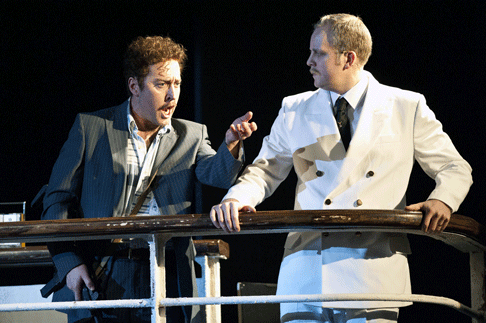 Christopher Magiera as the Captain and Richard Burkhard as Mamoud
Christopher Magiera as the Captain and Richard Burkhard as Mamoud
Michaela Martens' arias as Marilyn Klinghoffer are tours de force, the last adding bite. The Captain (Christopher Magiera) handled the situation with cool headed professionalism. offering his own life to save his passengers, but Adams and Goodman don’t dilute the focus from Klinghoffer to make the Captain a hero. Mrs Klinghoffer, in her grief, can’t understand why her husband was killed without her knowing. It’s a thoughtful detail to include in the opera since in these situations no-one knows everything all the time. Fine vignettes too from Lucy Schaufer (The Swiss Grandmother), Clare Presland (The Palestinian Mother) and Kate Miller Heidke (The British Dancing Girl), so clueless that she doesn’t comprehend the enormity of what’s happening. In a much needed twist of humour, Adams adds snatches of pop music around the part.
Baldur Brönimann conducted the orchestra so details surfaced tellingly from the amorphous textures. He’s a specialist in modern repertoire and understands how the genre operates. This music is not an undifferentiated mass.
The staging, however, was much less sensitive. Directed by Tom Morris with designs by Tom Pye, it tried to give shape to Adams’s oblique non-forms by over emphasizing the literal, perhaps to create the sensationalism Adams and Goodman avoid. The dance sequences are awful, completely at odds with the story. This is not a game. It is more than just a struggle over a country, it’s part of the eternal struggle between haves and have-nots. In this production, the Palestinians raise their fists in the classic gesture of the oppressed. For a moment it looks like a Nazi salute. What the hijackers did was evil, but it does not follow that the poor should not act, whoever they might be. The scenes where Finn Ross’s video projections fill the stage are far more effective, and being semi-abstract, are more faithful to Adams’s idiom.
The Death of Klinghoffer has its longueurs but it’s an important statement. Twenty five years after the Achille Lauro hijacking, terrorism is, if anything, more widespread and more savage than ever before. Twin Towers, the school in Beslan, the cinema in Moscow, and Utøya. Is there something to be learned from The Death of Klinghoffer? Many thanks to the ENO for giving us a chance to hear for ourselves.
Anne Ozorio
image=http://www.operatoday.com/Klinghoffer_ENO_01.gif image_description=Alan Opie as Klinghoffer and Michaela Martens as Marilyn Klinghoffer [Photo © Richard Hubert Smith courtesy of English National Opera] product=yes product_title=John Adams: The Death of Klinghoffer product_by=Klinghoffer: Alan Opie; Captain: Christopher Magiera; Marilyn Klinghoffer: Michaela Martens; Molqi: Edwin Vega; Rambo: Sidney Outlaw; Mamoud: Richard Burkhard; Austrian Woman: Kathryn Harries; First Officer: James Cleverton; Swiss Grandmother: Lucy Schaufer; Palestinian Woman: Clare Presland; British Dancing Girl: Kate Miller-Heidke. Chorus of the English National Opera. Chorus Master: Francine Merry. Orchestra of the English National Opera. Conductor: Baldur Brönimann. Director: Tom Morris. Designs: Tom Pye. Video Projections: Finn Ross. Costumes: Laura Hopkins. Lighting: Jean Kalman. Choreographer: Arthur Pita. English National Opera. The Coliseum. London, 25th February 2012. product_id=Above: Alan Opie as Klinghoffer and Michaela Martens as Marilyn KlinghofferPhotos © Richard Hubert Smith courtesy of English National Opera
“Figures from the Antique”, Wigmore Hall
One mild criticism levelled at Bostridge in the past has been that his repertoire range is rather limited, but this recital series is convincingly dispelling that censure; here, an intriguing assemblage of chamber cantatas proved that he is as comfortable, and accomplished, in styles as disparate as baroque seria and French mélodie.
Bostridge was partnered by the Austrian soprano, Angelika Kirchschlager, and, opening the recital with Handel’s O numi eterni, she immediately established her striking dramatic presence, launching with unrestrained emotional force into an anguished account of the rape and suicide of Lucrezia. La Lucrezia is a truly ‘operatic’ work. Except for the admixture of recitative and aria, it has very little resemblance to the standard Baroque cantata; rather it is a complex scena in a multifaceted and unique form. Such complexity is integral to the development of Lucrezia’s agonising responses: pain, fury, doubt, resignation and revenge. Kirchschlager maximised the transitions — often unpredictable and unsettling — from recitative to aria, powerfully revealing the volatility and extremity of Lucrezia’s emotional states. Histrionic outbursts characterised by abrupt, jarring shifts of register were juxtaposed with calmer episodes where a reflective ‘cello accompaniment (sensitively played by Jonathan Manson of the English Concert) intimated the underlying sadness beneath the outpourings of aggressive vengeance. With a wild energy, Kirchschlager absolutely inhabited Lucrezia’s destabilised, damaged psyche. Yet, while not lacking in dramatic impact, her projection of the text was less impressive; and, it was a pity that her performance was so bound to the score throughout.
In contrast, Bostridge’s rendering of Alessandro Scarlatti’s Io son Neron, l’imperator del mondo was most definitely ‘off the book’. Bostridge’s unmannered delivery — and the intermingling of flamboyant posturing and imperious flourishes with traces of ironic insinuation — revealed a dramatic and emotional range far beyond the internalised, tormented modes with which he established his reputation. In the first aria, in which a supercilious Nero challenges even the gods, Bostridge demonstrated both vocal strength and flexibility as he arrogantly declared, “I want Jove to tremble before the magnificence of my presence”. With fitting irony, the rejections of the notion of compassion in the second aria draw forth the tenor’s most beautiful, seductive tone. The recitatives conveyed the tempestuousness of the deluded, unbalanced emperor, demonstrating his extreme cruelty and his delight in the suffering and slaughter he causes. The last aria 'Veder chi pena' is set as a tarantella, a southern Italian folk dance, and Bostridge enjoyed the paradox that this light-hearted form is in fact the ultimate demonstration of Nero's malignity as he sings: "To watch those that suffer and sigh is my heart's desire, evil since birth.”
The ‘modern’ half of the recital began with Eric Satie's little known “La Mort de Socrate”, a quiet, reflective account of the great Greek philosopher’s final moments before he is poisoned. Impressively performing the ceaselessly unfolding declamation from memory, Bostridge demonstrated his profound musical intelligence, appreciating both the understated manner and charm of the early twentieth-century French idiom and the underlying sincerity and affectivity of the sentiments expressed. With poise and elegance he related the French text — fragments from Plato’s Dialogues translated by Victor Cousin — his even tone and graceful delivery unaffectedly revealing its simple poignancy. Bostridge’s reading was sympathetically supported by some accomplished playing by the Aurora Orchestra, conducted by Nicholas Collon, who drew sharply defined textures from his ensemble.
Kirchschlager closed the recital with an impassioned performance of Benjamin Britten’s late masterwork, Phaedra, a ‘dramatic cantata’ written for Janet Baker. In contrast to the tragic nobility with which Baker reportedly imbued the role, Kirchschlager went for an unrelenting, full-throttle approach; and while she undoubtedly conveyed the neuroses and instability of Theseus’s unfaithful wife, by emphasising Phaedra’s sexuality and fickleness she neglected the quieter, internalised guilt and remorse that Britten’s music suggests. Certainly, in the ‘Presto to Hippolytus’ Britten sets explicitly sexual imagery from Robert Lowell’s translation of Racine: “Look, this monster ravenous/ For her execution, will not flinch,/ I want your sword’s spasmodic final inch.” And here Kirchschlager’s dazzling timbre together with striking rhythmic incisiveness from the instrumentalists of the Aurora Orchestra powerfully conveyed her adulterous lust and intimated her insanity.
But, Britten’s music is never frantic; the heights of Phaedra’s obsession are depicted by a chilling passage for stratospheric strings accompanied by untuned percussive strikes which suggest a pulsing, diminishing heartbeat, both serenely beautiful and poignantly prophetic of her imminent death. In the final ‘Adagio to Theseus’, Phaedra shows calm acceptance of her fate — “A cold composure I have never know/ Gives me a moment’s pause.” — her resignation underpinned by the orchestra’s gradual modulation towards C Major harmony and ‘resolution’. Superb instrumental playing — cellist Oliver Coates deserves especial mention — brought some emotional variety to the performance, to counter Kirchschlager’s remarkable but unremitting frenzy.
Claire Seymour
Programme:
Handel: O numi eterni (La Lucrezia) HWV145
Corelli: La Follia for violin and string ensemble
Scarlatti: Io son Neron, l’imperator del mondo
Satie: “The Death of Socrates” from Socrate
Britten: Phaedra Op.93
image=http://www.operatoday.com/socrates.gif image_description=The Death of Socrates by Jacques-Louis David product=yes product_title=“Figures from the Antique” product_by=Angelika Kirchschlager, mezzo-soprano; Ian Bostridge, tenor. Aurora Orchestra. Nicholas Collon, conductor. The English Concert. Laurence Cummings, director and, harpsichord. Nadja Zwiener, solo violin. Wigmore Hall, London, Monday, 20th February 2012. product_id=Above: The Death of Socrates by Jacques-Louis DavidFebruary 26, 2012
Bryan Hymel, Rusalka’s Prince
“It’s a role that’s been good to me,” he says. He made his European debut in the role at Wexford Festival Opera in 2007. After an extended period working in Europe, it brought him back to the United States where he performed it with the Boston Lyric Opera three seasons ago. Now he’s singing the Prince again at the Royal Opera House. This is high profile, since it is the first ever full staging of the opera. Previously, it was heard only in concert performance.
This Royal Opera House Rusalka will be conducted by Yannick Nézet-Séguin, making his long-awaited debut at Covent Garden. Hymel is thrilled. “Yannick is a singer himself, he grew up in the choral tradition and was chorus master in Montréal before he made his name conducting. He’s just as at home with singers as he is with the orchestra”. Some conductors leave acting to the director,. “But Yannick understands. For him, the music is so important that he doesn’t want anything to get in the way of it.” In this production, the Foreign Prince is characterized as childish and nervous, which is valid. “But Yannick said to me, don’t let it get into your body. You know you can sing it, so you owe it to yourself to sing it well”. Hymel beams. “Few conductors have that spark of inspiration. I love it that he stands up for you as a singer, and is on the side of the music”.
This production is directed by Jossi Wieler and Sergio Morabito, and premiered in Salzburg. “Modern productions can be fine”, says Hymel, “but this one is very physical. It’s not easy on the body, It’s tricky to sing lying on your back, and there’s a lot of rolling about. You get beat up and knocked around, but you still have to sing beautifully”.
“Rusalka is a very dark story. Dvořák really wanted to delve the depths and shadowy aspects. Lots of low brass and ominous music that probe beyond a fairy tale”. Rusalki are water spirits, exquisitely alluring. but not wholesome. “Rusalka’s own music is so sweet that you can’t help falling in love with her. Here she has a little fish tail.” Hymel smiles and “acts” Rusalka’s movements, “So sweet and innocent. But Rusalki in general? Stay away!”
What drew Hymel to The Foreign Prince? “The music, of course. Wexford was my opportunity to get to know it well. I’d sung German and Russian, but singing in Czech was a bit intimidating. No Czech coach in Philadelphia, where I was studying then, and the coach I located in New York was flying all round the world. So I found a score with the text partly transliterated and listened to the Ben Heppner recording, while getting my mouth round those diacritics. Now Czech comes easily to Hymel, who also sings Janáček.
The Prince’s music is really very beautiful. In this production, the Prince gets a chance to be a romantic hero at the end of the First Act, but after that characterwise, things go downhill. He gets frustrated which you can understand because Rusalka cannot speak or communicate, but the way he drops her is cruel. Yet he’s not that childish, and in the end he takes responsibility for his previous impatience. He asks for that last kiss knowing that it will kill him. There won’t be any Happily Ever After. Psychologically, it’s very deep”.
Hymel has an affinity for lyrical roles like Enée in Berlioz Les Troyennes, which he sang with The Nederlandse Opera in Amsterdam. “Enée sits a half, even a full step higher than the Foreign Prince. It’s deceptive because it goes from A natural and A flat, and then in the last scene, after you’ve been singing your voice out, there’s a high C, not an easy C because of where it lies, and was written for a specific type of voice we don’t often hear these days”
Gounod Faust is another favorite.”The range is fantastic. Last summer I sang ten performances at the Santa Fe Opera conducted by Frederic Chaslin and directed by Stephen Lawless. The part is high, but with weight and you have to sing Faust as an old man and then young again with wonderful lines in the arias and duets.” Hymel is singing Faust again in Baltimore in April.
Don José in Bizet’s Carmen holds several special memories. When Hymel sang it at the Royal Opera House in 2010, he met the Greek soprano Irini Kyriakidou, a colleague of Aris Agiris, the Escamillo. They married and make a lovely couple. She’s recently made her Royal Opera House debut as Zerlina. Then, last year in Munich, when Hymel was singing in Nabucco, Jonas Kaufmann cancelled Don José at the last moment and Hymel stepped in. “It was fun but daunting. I heard the Intendant go in front of the curtain and make the announcement that Jonas would not be there. The audience started shouting and there I was, thinking, Oh gosh, this is Jonas’s home town and I have to face that crowd! But they were appreciative, and I was relieved”.
“I think there could be a renaissance in French grand opera, just like there was a renaissance in Rossini ten years or so ago, when it had been basically Il Barbiere de Seviglia.When singers like Juan Diego Flores and Lawrence Brownlee who can sing them properly, we can hear why the operas were good in the first place. There are all these wonderful operas like Benevenuto Cellini and Les Huguenots. What a great time it must have been them, with composers writing for so many different voice types. Nowadays, we’re “Italian heavy” as Hymel puts it, but there’s so much more to the tenor range,
“They say that between age 30 and 35 the voice is in transition”, says Hymel, who is 32, “And I can really feel it filling out in a good way. It’s not like when you’re 13 and it drops overnight It’s a gradual process. The more music I do, the more it stretches me. I had to sing La Traviata in Houston when the Alfredo pulled out. After the Prince and Faust, “Libiamo, Libiamo” was different. But it’s good. It’s like when you go to the gym, you don’t do the same exercise all the time because your body needs to adapt. Ultimately, that’s what makes you stronger”. Rusalka runs for six performances at the Royal Opera House from 27th February. Please see the Royal Opera House website for more.
Anne Ozorio
image=http://www.operatoday.com/Bryan_Hymel.gif image_description=Brian Hymel product=yes product_title=Brian Hymel, Rusalka’s Foreign Prince product_by=By Anne Ozorio product_id=Above: Brian HymelFebruary 24, 2012
Moby-Dick, San Diego
Its libretto is taut and clear, its music accessible and appealing, and its visual effects spectacular and breathtaking. If you can get to see this production, do not miss it.
Moby-Dick, first performed by the Dallas Opera company in 2010, was jointly commissioned by Dallas, San Francisco, San Diego and Calgary Operas and the State Opera of South Australia. Calgary and South Australia have already seen it. The San Diego production marks its West Coast premier. San Francisco will see it this fall.
Melville was an author obsessed with telling what he considered the whole truth about everything. “Taking a book off the brain is akin to the ticklish and dangerous business of taking an old painting off a panel — you have to scrape off the whole brain in order to get at it with due safety,” he wrote while at work on Moby-Dick. Its main characters’ histories and emotional stories, its metaphorical, symbolic meanings were buried deep in over seven hundred pages of side tales and expository material. Heggie and librettist Gene Scheer miraculously reduced this leviathan work to two dramatic acts. Working with director and dramaturg Leonard Foglia and a visual production team, they shaped the material into an opera in which words, music and extraordinary visual effects flow together seamlessly.
The ingenious sets and projections begin during the overture and take us from the starry heaven to the deck of the Pequod just as the curtain rises. As the story rolls on we see the crew climbing the rigging, the ship jibing, a boy flailing in hostile seas, harpooners leaping in and falling out of small boats. Amazingly there is singing going on all the time.
Sheer’s libretto effectively captures the essence of human longings and love through poetic language and occasional patterns of rhyme. He centered the plot in two struggles as seen through two sets of relationships. The core of Moby-Dick is the moral and ethical struggle between the mad Captain Ahab ruthlessly pursing the white whale, and Starbuck, his principled first mate, who tries vainly to become the unhearing Ahab’s voice of conscience. We learn the yearning of the fearful young seaman called Greenhorn, who knows little of life and less about sailing, through his interaction with Queequeg, the self-contained aborigine harpooner, who befriends him. Then there is the cabin boy, Pip, loved by all, who sings, dances, plays his tambourine, and goes mad. The large crew provides an impressive male chorus.
Conductor Joseph Mechavich, replacing San Diego’s principal conductor, Karen Keltner, who became ill just before rehearsals were to begin, led an assured performance. Mechavich had conducted the work in Calgary. Tenor Jay Hunter Morris who had sung Captain Ahab in Australia was literally dropped into costume overnight after a run of Siegfrieds at the Met, when Ben Heppner left after the first performance. Stomping around on his peg leg, Morris handled the role’s high tessitura effortlessly. His second act duet with the excellent Morgan Smith, a veteran Starbuck, new to San Diego, was memorable. Jonathan Boyd, new to both San Diego and the role, was a sweet voiced Greenhorn, perfectly paired with the Queegueg of bass Jonathan Lemalu, another Moby Dick veteran, debuting in San Diego. The duet in which the two, high in the rigging, dream of a peaceful future on Queegueg’s island, is almost a love song. Soprano Talise Trevigne’s rich soprano, coupled with her agility and charm made one feel for the unfortunate Pip.
Jake Heggie is a composer known for his songs as well as operas. He not only writes movingly for the voice, but commands a rich and colorful orchestral palette, and has an enormous lyric gift. Extraordinarily for a newly heard work, a friend and I left the opera house singing snatches of its oft repeating orchestral themes. Is this good or bad? Will this score with its movie-music edge and oft repeated theme, survive? I have no doubt that the opera’s prelude and sea music will someday become a Moby-Dick suite, much like Sea Interludes taken from Britten’s Peter Grimes. There is much in this work both literally and musically of Britten’s Billy Budd (also based on a Melville novel). Musical references to Puccini, Bernstein, even Copland and Philip Glass have all been noted in Heggie’s score. But it is Heggie’s score alone that will determine the place of Moby Dick in the operatic repertoire.
I’d like to think that Moby-Dick will long be a part of the American operatic scene. But I worry how it will fare if and when less expensive productions cannot do justice to the visual aspects of the production. Will the music and story hold up?
The first act of the opera is spell binding as the visuals and story lines unfold before us. The second act, while visually brilliant, and offering two lyrical duets, is somewhat static, as we await the predictable conclusion. The Pequod is destroyed, the crew is lost at sea. We are astounded by the speed and brilliance of the scene, by the powerful rhythms and clashing dissonances of the sea, but we are not deeply moved. We have witnessed a huge tragedy, good people have died, but there is no single character aboard the Pequod whose fate moves us to tears; no Peter Grimes, Billy Budd, nor even the murderous barge captain, Michele in Il Tabarro.
Make no mistake, this was a thrilling evening of opera, greeted enthusiastically by a grateful audience. I left the theater feeling that American composers, writers and visual artists will keep opera alive throughout this still new century. .
Kudos to the San Diego opera company for having brought this work to its stage. Though not privy to the company’s internal workings, I know that aside from raising $2,398,956 required for artists, crews, sets, and everything else, its General and Artistic Director Ian Campbell and staff had to replace his conductor once and his star tenor, twice. So I’m grateful that Mr. Campbell too seems to have been a bit obsessed with finding Moby-Dick.
Estelle Gilson
image=http://www.operatoday.com/Photografeo-035large-file.gif image_description=Jay Hunter Morris as Captain Ahab [Photo by Photografeo courtesy of San Diego Opera] product=yes product_title=Jake Heggie: Moby-Dick product_by=Queegueg:Jonathan Lemalu; Greenhorn:Johnathan Boyd; Starbuck:Morgan Smith; Pip:Talise Ttrevigne; Captain Ahab:Jay Hunter Morris; Conductor: Joseph Mechavich; Director and Dramaturg:Leonard Foglia; Librettist:Gene Scheer; Scenic Designer:Robert Brill; Costume Designer: Jane Greenwood; Lighting Designer:Donald Holder; Projection Designer:Elaine J. McCarthy. product_id=Above: Jay Hunter Morris as Captain Ahab [Photo by Photografeo courtesy of San Diego Opera]Fleming in Strauss’s Capriccio
None come to mind. But Richard Strauss twice stopped the progress of heavily scored recitative in his own operas to bring on caricatures of Italian opera singers for light-hearted relief. In Der Rosenkavalier the Marschallin is entertained in her boudoir by the “Italian singer,” a tenor who belts out what, ironically, is probably the best known aria from any Strauss opera, “Di rigori armato.” Then in Capriccio, Die Grafin, as elegant and aristocratic as her operatic predecessor, also finds such amusement, this time with the “Italian Singers,” a tenor and a soprano whose music mocks the “high note” obsession of Italian opera. It’s almost as if Strauss might have wondered if audiences might grow restless in the middle of an intermission-less two and a half hours of a barely dramatic debate over whether music or literature is the highest art. The buffo treatment afforded the Italian Singers might make such audiences recoil from wishing they could slip out of a Capriccio performance for some time with Il Trovatore.
Capriccio is a late work of Strauss, and as with the Vier Letzte Lieder and Metamorphosen, the score’s greatest music, in the final scene, is duskily lit with the glowing colors of a dying sunset. In the preceding two hours, Strauss weaves parodies of 18th century music along with his own craftsman-like ability to keep the musical motor running without ever seeming to arrive anywhere. The characters have no history or interior life to propel the action, such as it is. A musician, Flamand, and a poet, Olivier, compete for the patronage and romantic attention of Die Grafin. La Roche, a theater director, is putting on an entertainment for her, which will feature a self-infatuated actress (Clarion) as well as the two Italian Singers. As the theatrical endeavor proceeds, a rhetorical argument takes the place of any narrative drive — is it music or literature that is man’s highest artistic achievement? In her long closing soliloquy, Die Grafin evades a final answer, but the dominance of Strauss’s score seems to complete the response for her.
Capriccio will never be a mainstay of the operatic repertory, but it is the most frequently performed of any of the operas from the latter stage of Strauss’s career. It offers a great leading role for a soprano, who gets to be the focus of attention for most of the evening and who, at its close, has the stage to herself. In this Metropolitan Live HD performance from April 2011, Renée Fleming meets every vocal requirement of the role; not unexpectedly, as her credentials in Strauss have long been validated. What she can’t quite do is to suggest the depths of intelligence or sensuality that the other characters claim to see in Die Grafin. Peter Rose, a notable Baron Ochs, makes the most of his big scene as La Roche. Sarah Connolly gives the outrageous Clarion a good try, without quite seeming comfortable in the role. Joseph Kaiser as Flamand and Russell Braun as Olivier can’t escape the bland confines of their under-characterized roles. Barry Banks and Olga Makarina are very funny as the Italian Singers and also notably un-Italian.
Conducting Capriccio must be a treat, with its small ensembles built into the framework of larger orchestral set-pieces. Andrew Davis leads the Metropolitan Opera forces in a detailed, buffed performance. The John Cox production harmlessly updates the action, which is hardly historically relevant to begin with. Robert Perdziola’s costumes and Mauro Pagano’s sets complement the elegance and handsomeness of the work.
As strong as this performance is, anyone who loves this opera must also seek out a San Francisco Opera performance with Kiri te Kanawa and Tatiana Troyanos, both of whom simply outclass their talented peers in the more recent production.
Chris Mullins
image=http://www.operatoday.com/Decca_0743454_DVD.gif image_description=Richard Strauss: Capriccio product=yes product_title=Richard Strauss: Capriccio product_by=Die Gräfin: Renée Fleming; Flamand: Joseph Kaiser; Olivier: Russell Braun; La Roche: Peter Rose; Clairon: Sarah Connolly. The Metropolitan Opera Orchestra. Conductor: Andrew Davis. product_id=Decca 0440 074 3454 3 DH [2DVDs] price=$37.99 product_url=http://www.arkivmusic.com/classical/album.jsp?album_id=654100&album_group=2
Michael Spyres — A Fool for Love
As he launched into the first cut, “Ah! mes amis” (Daughter of the Regiment) I found his sweet tone reminiscent of Javier Camarena, the poised musical line similar to Lawrence Brownlee’s, and the panache comparable to Juan Diego Florez. Not a bad triple threat combination there! And a very ballsy selection to start with since bel canto poster boy JDF not only had a very recent blockbuster success with Daughter in every major house and on DVD, but we also still have over-sized memories of the legendary Pav in the part.
Spyres seems to have a bit more heft going on than his immediate contemporaries, and while he squarely nails the requisite high C’s he doesn’t quite manage the varied colors and sassy ‘tude at the top that others bring to the part. Still, while his core voice may not exactly ‘live’ up there, he zings out the money notes with accuracy and skill. As he progresses directly to “Here I stand” (The Rake’s Progress), we immediately hear a more weighted quality, slightly rounder, discernibly fuller. If richness at the very top eludes him by a hair, he makes as much musical sense of the piece as anyone I have heard, keeping the angular dips and leaps admriably connected and focussed. The penultimate held note (“Ride”) is thrilling, gleaming, substantial. Moreover, Mr. Spyres has impeccable diction, and a dash of wit as he speaks “I wish I had money” as the tag.
As the tenor then segues into “Cessa di piu resistere” (The Barber of Seville), I am beginning to get the idea that he is looking to show his full aresenal, with sharp contrasts between the selections. Here, Michael utilizes a light-voiced approach for the most part, and scales back considerably to negotiate the fiendishly tricky, awkward, melismatic writing. His take-no-prisoners approach to Rossini and Donizetti, while commendable, makes him pull back on the very top notes, keeping everything very focused so that color and variety are somewhat slighted. In the stretto section where things get rhytmically heated, some of the fireworks are fudged ever so slightly. Spyres did astonish with a few very solid descents to the depths of his range and he has an unusually responsive lower middle.
The pendulum swings back to more full-bodied singing with “Una furtive lagrima” (L’elisir d’amore), in which he once again rounds the tone, lets it turn over, and brings it more into the speaking mask. He makes this aria anything but an old chestnut, lavishing it with creamy lines in which everything is solidly hooked up. This was excpetional vocalism, incorporating a masterful melding of the registers. For the first time, the voice seemed to have significant presence and power, so it made me curious just how much size he can convey in the house. With “Il Mio Tesoro” (Don Giovanni), Mr. Spyres seems to be affecting a “Mozart” style which came off a little bloodless compared to his other, more theatrically realized set pieces. There was absoltuely nothing wrong with it but he seemed a bit removed for the first time, when lo, he rallied for a solidly realized finish. I wish he could inform the first nine tenths of that piece with his final personalized commitment.
As for “Je crois entendre encore” (The Pearl Fishers) and “Pourquoi me reveiller” (Werther), based on this recorded evidence, Michale Spyres seems born to sing these French roles. He commands a well-controlled ‘messa di voce’ and an understanding of ‘voix mixte’ that are suavely deployed and exceptionally pleasing. In both, Spyres keeps the forward motion going with intensity and introspection. In the Werther he starts off with a slightly darkened tone and sober coloring that serve him quite well. By now I am seriously beginning to think his strong suit is not the florid singing (which seems more a party piece, just cuz he can do it). Both French pieces draw forth all his best instincts and elicit his most sonorous vocal approach. It would be a real pleasures to hear him in either of these roles.
Speaking of party pieces, I am not sure I have ever encountered the Italian Tenor’s solo from Der Rosenkavalier (“Di rigori armato il seno”) on a recital disc although plenty of star tenors have taken their turn at it on stage (fond memories here of Pavarotti at the Met during the “Luciano” season). Mr. Spyres sings it with a surging sense of line and an easy squillo that could be a preview of his own star turn in this role some day. I wondered what anyone could bring to “Che gelida manina” (La Boheme) that was fresh? How about simply an absolutely fresh new voice that is possessed of a solid technique. He convinces me even more with this aria that such roles are his eventual forte. He knows what he is singing and conveys it with directness, not as easy as it sounds. Michael unearths absolute truthfulness in the uncomplicated poet’s exposition.
Inviting another comparison with Florez, “La Donna e mobile” (Rigoletto) is a piece that JDF does most usually only in recital and it does push the brilliant Peruvian’s outer limits. But no such limitation exists for Spyres who delivers all the goods with bravado. Many a lyric tenor has come to grief over Edgardo (Lucia di Lammermoor) in general and “Fra poco a me ricovero” in particular. Spyres suggests a decent amount of gravitas and summons up a burnished tone for the long recit intro, then he doles out good but rather generic vocal lines in the wide-ranging aria. I wonder if he might discover the same wonderful variety that he brought to the recit and carry it forward into the aria?
“Kuda, kuda” (Lenksy’s aria, Eugene Onegin) is similarly characterized by a gorgeous tone but seems to lack a specifitiy evident elsewhere. He may speak Russian like a native for all I know but he finds less individualized drama in the text on this piece, which is well coached but not just yet his own. (When it is vocalized this well, and is so well-intended, am I just carping?) The reliable Moscow Chamber Orchestra really shines here under Constantine Orbelian’s efficient and supportive baton. The final selection “E la solita storia” (L’Arlesiana - Cilea) also really showcases Spyres interpretive gifts. The haunting, well-calculated musical build wedded to a splendid display of well accented parlando segued easily into beautiful arching lines.
This young tenor really knows where the music and the story are going, with each tale having a beginning, middle and end. He appears to be a conscientious and intelligent interpreter, coloring and tailoring his instrument and technique to make each genre as stylistically pure as possible. While he does tend to slightly cover or brighten top notes as needed for the varying demands, his is a reliable, freely-produced, imminently enjoyable timbre.
As for the structuring of the program, in the liner notes Michael makes a case for the sequence of the arias, selected to document a man’s life journey from first love to love lost. I do appreciate the thought that went into the content and the ordering of the pieces, but this is not after all Frauenliebe und -leben which is composed specifically with such a journey in mind. Rather it is more jukebox concertizing no better or worse than the shoe-horned songs of Mamma Mia! and the like. There is such a change in demeanor, such a departure of styles from one selection to the next that it just doesn’t communicate that this is one man on one journey. Admiring the scholarship, I demur that it does not play out to its intended effect. And really, with such diverse and wondrously effective singing on display, who cares?
As if a “Bonus” were needed, an encore of Dein ist mein ganzes Herz caps the disc, complete with dreamy, oozing, honeyed lines that drip Viennese enchantment, and featuring the very best climactic top notes of the compilation, ringing, forward and free.
Michael Spyres is on the fast track to being ‘the’ versatile, in-demand, go-to tenor in several different fachs. He promises much and, as evidenced by this debut solo effort, is already delivering handsomely on that potential.
James Sohre
image=http://www.operatoday.com/Delos-DE-3414-2.gif image_description=A Fool for Love product=yes product_title=A Fool for Love product_by=Michael Spyres, tenor. Moscow Chamber Orchestra. Conductor: Constantine Orbelian. product_id=Delos DE 3414 [CD] price=$17.99 product_url=http://www.arkivmusic.com/classical/Drilldown?name_id1=202951&name_role1=2&bcorder=2&label_id=1073La clemenza di Tito — Barbican
After writing three great Italian operas which advanced the genre immensely, Mozart turned his attention elsewhere. In his final year he wrote two last operas, which not only contrast with each other but with the three Da Ponte operas which precede them. His singspiel Die Zauberflöte has long been accepted on operatic stages, but La clemenza di Tito has only relatively recently come to acceptance as being stage-worthy.
Somehow, Mozart’s reverting to an opera seria libretto based on Metastasio seemed a step backwards; compared to the three Da Ponte operas, La clemenza di Tito can seem static and actionless. It is in fact an opera which requires the right performers, and at the Barbican on Wednesday 22nd February, the Deutscher Kammerphiharmonie Bremen, under conductor Louis Langrée presented the opera in concert, with a cast who seemed to understand Mozart’s late, austere masterpiece, and vividly brought it to life.
Of course, the piece isn’t strictly an opera seria; the libretto was re-written for Mozart by Caterino Mazzola the Dresden court librettist. Mazzola reduced the number of acts to two and introduced trios, duets and ensembles, giving a greater role to the chorus and creating the Act 1 choral finale. (In fact there is a Gluck setting of the original libretto and I have long thought that it would be illuminating to hear the two side by side in concert.) But Mozart kept a number of opera seria elements in his setting, notably the use of long, highly serious arias; this of course was helped by the fact that one of the arias was a pre-existing concert aria which Mozart included, thus facilitating the speeding writing of the piece. He also relished the way the drama turns slowly, that we get to examine the major characters in detail, emotion by emotion, Affekt by Affekt.
The subtlety which Mozart and Mazzola brought to the piece is demonstrated by their Act 1 trio for Vitellia, Publio and Annio, inserted at the point where Tito has decided to make Vitellia his bride. This could easily have been an aria for Vitellia as she agonises over the fact that it is too late to call back Sesto from his plot; instead Mozart and Mazzola counterpoint this with Publio and Annio’s reactions, naturally they assume that Vitellia is imply overcome by the enormity of the honour of being made Caesar’s wife.
The concert performance at the Barbican was the third stop in a four city tour (Dortmund, Bremen, London, Paris) so that the performance was well bedded in. Though scores were used by the singers, some seemed to ignore them entirely and others were hardly bound to them. In fact this was a highly dramatic presentation. Chief amongst this was the Tito of Michael Schade. Schade used the recitatives in a vivid way, sometimes distorting the line for emphasis. His Tito was no compliant dummy, but a highly emotional and at times over-wrought man; in fact Schade was one of the most extrovert Tito’s I have ever seen, a highly involved and strongly projected performance. This was combined with some very fine Mozart singing, with a clear sense of line combined with dramatic thrust. This made Tito much more of a major player in the drama, rather than a passive ruler to whom things happened as has often been the case with other tenors in this role. Though I have to say that sometimes I thought that Schade went it little too far, with over emphatic dramatics which a good director would surely have taken in hand (there was no director credited in the programme).
Alice Coote’s Sesto was no less dramatic, but all the more compelling for being a far less histrionic performance. Coote’s Sesto was firmly rooted in the music, in the long statuesque arias which Mozart wrote for the character. The great showpiece “Parto, parto” was superbly done, finely accompanied by the solo bassett clarinet from the orchestra. But Sesto’s big accompagnato at the opening of Act 2 also showed a great artist at work, combining musical values with profound drama. Coote is highly experienced in baroque opera seria and so you felt that her performance in this, the last opera seria, was inflected by Mozart’s reflection of the past. Coote’s Sesto reflected both Mozart’s other writing for mezzo-soprano, but also earlier Handelian roles.
She was ably partnered by the Vitellia of Malin Hartelius. Vitellia is a curious role; written for a soprano, it includes the aria, “Non piu di fiori”, which may originally have been concert aria for a distinctly lower voice. This gives the part quite a wide range and its tessitura is such that mezzo-sopranos such as Janet Baker and Della Jones have played with role and on stage it can often be performed by a dramatic soprano (Julia Varady has recorded the role). Malin Hartelius has a rather lighter voice than these; her CV includes recent highlights such as Fiordiligi, Leila (Le Pecheurs de Perles) and her first Marschallin. She played Vitellia as more overtly sexy and rather less the scheming bitch; Hartelius brought a sexual charge to a lot of Vitellia’s music, here was a woman who lived in a man’s world by trading on her female wiles and charms. The relative lightness of Hartelius’s voice meant that we got a nice flexibility in the vocal line, which was a great treat. (Here was a Vitellia more closely related to Fiordiligi than is sometimes the case). She approached the top of her voice with caution, but nothing was announced regarding indisposition. In “Non piu di fiori” she approached the low notes bravely, making the effort seem part and parcel of a fine performance; again the obliggato was played finely by the orchestra’s clarinettist, this time on a bassett horn, thus giving the aria its distinctive tint.
Coote and Hartelius developed a strongly co-dependent relationship which was all too believable and became the strong engine of the drama around which the other roles circulated. Luckily the cast formed a strong ensemble, so that Coote and Hartelius did not overbalance the drama.
Christina Daletska displayed a lighter, brighter voice than Coote, so that her Annio was clearly related to Cherubino, though a Cherubino now grown up and willing to challenge authority. Daletska gave a seriously fine account of Annio’s aria “Tu fosti tradito” when he stands up to Tito after the discovery of Sesto’s involvement in the plot against Tito.
Rosa Feola was an entirely admirable Servilia, giving a performance that combined charm with a certain interesting dramatic edge. She left you wishing that Mozart had written more for this character.
Brindley Sherratt was Publio, the commander of the Praetorian Guards; a role entirely without aria, but one which has an important part to play in the drama and in the ensembles. Sherratt discharged his duty entirely admirably and convincingly, bringing a nicely dramatic firmness of line to the role.
Of course, one major aspect of any performance ofLa clemenza di Tito is the recitative. There’s a lot of it and it’s not all by Mozart; one of his pupils wrote it under his supervision. The cast gave us quite a full version, accompanied by Raphael Alpermann’s lively fortepiano. The result was fleet and dramatic, keeping the action moving and making us aware that it really was drama.
The Deutscher Kammerchor provided the choral moments with nicely turned phrases. They were not on stage all the time, so their entrances and exits were a little distracting, but once present their singing was of a high order.
Conductor Louis Langrée drew a fluent and at times speedy account of the music from the Deustche Kammerphilharmonie Bremen. But Langrée’s concern for lively expressiveness seemed at times to be at the expense of cohesiveness of ensemble. Still, he got a vivid and involving performance from everyone and above all made us believe in La clemenza di Tito as drama, rather than a museum curiosity.
Robert Hugill
Click here for the programme of this production.
image=http://www.operatoday.com/Canaletto_Arch_Titus.gif image_description=The Arch of Titus by Canaletto product=yes product_title=W. A. Mozart: La clemenza di Titlo product_by=Tito: Michael Schade; Sesto: Alice Coote; Servilia: Rosa Feola; Vitellia: Malin Hartelius; Annio: Christina Daletska; Publio: Brindley Sherratt. Deutsche Kammerphilharmonie Bremen. Deutscher Kammerchor. Conductor: Louis Langrée. Barbican Hall, London, 22nd February 2012. product_id=Above: The Arch of Titus by CanalettoAmsterdam’s Invisible, Risible Kitezh
Then we burst into delighted applause in appreciation for the evocative beauty of the realistic woodland, the artistically placed tall dry foliage, the massively elaborate tree trunks, the scattering of withered late fall flowers, the raked stage with cozy cabin up the ‘hill’, the eerie mists rising from the ground’s dampness. Three wooden ladders are placed up that hill evoking Golgotha. Mysterious. Provocative. Apt. Seldom has a piece begun so favorably and offered such promise of a legendary evening. And all this before the downbeat.
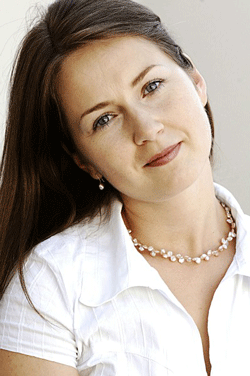 Svetlana Ignatovich [Photo: Theater Dortmund]
Svetlana Ignatovich [Photo: Theater Dortmund]
When conductor Marc Albrecht immediately weighed in, it was clear from the outset that the Netherlands Philharmonic Orchestra would be on fine form the entire night, the strings rippling then soaring, the winds burbling then chirping, the horns playing rhapsodically then introspectively, the trumpets by turns jaunty and mellow, the large battery of percussive effects making significant contributions throughout the evening.
Rimsky-Korsakov is a master of orchestral effects after all, and along with the many exposed solos and textured ensembles come substantial challenges, not only having to master spare scoring of great delicacy, but to also communicate edgy, angular dramatic writing, and to evolve at will into downright euphoria. But this inspired band missed nary a trick. I shall long remember their spunky rendition of the tumultuous battle interlude with the winds fairly crackling with brilliance; as well as the long stretches of the last act when lush strings oozed like melted butter with the harp adding characterful accents, and the solo violin taking us on buoyant flights of trilling fancy. Albrecht knows this group of musicians, knows the house, and clearly looooooves him some R-K. The Maestro managed to unleash a surging and ebbing journey of well-defined musical moments that melded perfectly into one mighty, arching whole. Bravo, Mr. Albrecht.
We were perhaps even more fortunate with our heroine Fevronia, who carries the show. Russian Svetlana Ignatovich was simply ravishing in the title role (the maiden, not the city!). Ms. Ignatovich was recently honored by ‘Opernwelt’ as Best Young Singer and it is easy to hear why. For she is possessed of an ample, silvery-yet-warm, effortlessly produced soprano that encompasses every facet of the demanding vocal writing (and the requirements are many). At curtain rise we find her basking in the bucolic surroundings, and her voice takes on a comfortably resigned, conversational quality that ‘speaks’ well in the lower parlando passages. As her love interest blooms, her maidenly timbre acquires more luster, more pulsing heat, and she builds the excitement with exceptionally well-calibrated forays above the staff. Everything is marvelously connected, placement is consistent, the sense of the phrasing, the dramatic intent, the physicality (did I mention she is very pretty indeed?) are all splendid.
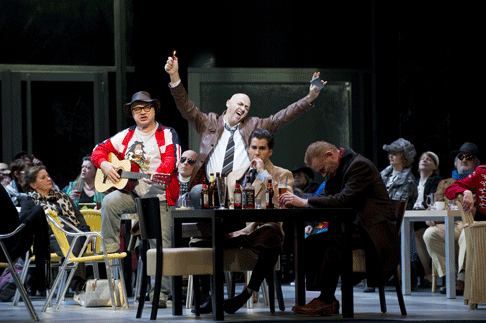 Gennady Bezzubenkov as Goeslispeler, John Daszak as Grisjka Koeterma, Morschi Franz and Peter Arink as the noblemen and Koor van De Nederlandse Opera
Gennady Bezzubenkov as Goeslispeler, John Daszak as Grisjka Koeterma, Morschi Franz and Peter Arink as the noblemen and Koor van De Nederlandse Opera
As Ferovnia’s happiness gets detoured and her fate more despairing, Svetlana summons reserves of (just a bit of) steel to zing phrases out over the demonstrative orchestra in a dazzling display of dynamic and interpretive range. In the final act, the composer has one more major hurdle for his heroine, a lengthy final solo stretch (Immolation crossed with Capriccio) that encapsulates everything in her arsenal into one final Mother of All Scena’s (that’s probably ‘Sceni’ but who cares?). If any convincing were needed that Svetlana Ignatovich is the real deal, the new diva in town, heiress apparent to many a lirico-spinto part, she won us over in that final marathon display of exemplary vocalism. Her curtain call deservedly won her a giddy, uproarious, celebratory affirmation.
Now before I go on, if you do not know the bare bones plot for this piece (as I did not), I bring you…
Kitezh for Dummies: The maiden Ferovnia lives in a dense forest, self-exiled for some sorta New Age reasons. During a hunt, Price Vsevolod stumbles into the scene. He is son to the ruler of Kitezh (think: Oz). They fall in love and he proposes to her. Subsequently, in a suburb of Kitezh a carnival-like party is going on to celebrate the arrival of the bride (think: Mardi Gras). However, two clinically disgruntled citizens (think: Tea Party) persuade the local curmudgeon Grishka to diss the bride who has now arrived accompanied by the Prince’s best man, Fyodor. All is terminated by an attack of blood-hungry Tatars (think: Big Mac Attack but noisier), and the invaders take Grishka and Ferovnia as hostages. The latter prays that Great Kitezh be made invisible so the invaders cannot conquer it. Guess what? It vanishes! (Hope your belief was duly suspended?) Meanwhile in Oz, er, Kitezh, ruler Yuri prays for his people as he appoints his son commander-in-chief, sacrificing Vsevelod to battle the Tatars. At this the V-Man proves singularly unskilled, ending up quite dead quite soon. The hoodwinked Tatars, who can’t see the city in front of their faces, disperse in frustration. Grushnik goes crazy and Ferovnia is visited by two helpful birds (think: Abigail van Buren and Ann Landers) who advise her that a) she will die, and b) become eternally happy. And, there you have it.
That may not help explain what I write about next, but, well, can it hurt?
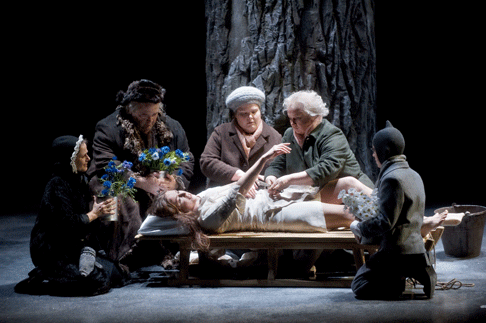 Svetlana Ignatovich as Fevronja, Jennifer Check as Sirin and Margarita Nekrasova as Alkonost
Svetlana Ignatovich as Fevronja, Jennifer Check as Sirin and Margarita Nekrasova as Alkonost
Having already done himself the big favor of designing an eye-popping set, in his other role as director, Dmitri Tcherniakov devised a first act that was a marvel of informative invention. He seemed to view the ambiguous piece as a ritual, with the natural goodness of the selfless maiden making her a spiritual leader of sorts. In the clearing at stage center there was a table variously used as a work space, dinner table, and even suggesting an altar. Here, Ferovnia tends to the everyday needs of a “family” (extras) that inhabits the cabin, nurturing and feeding them, dressing wounds, and performing menial chores. The action was chockful of meaningful stage business and incorporated fluid blocking that thoughtfully filled out the sketchy story. When the Prince observed her detailed displays of kindness and devotion, it was this powerful imagery that won his heart in what would have otherwise been an implausibly short turn- around time. Tenor Maxim Aksenov not only cut a fine figure as Prince Vsevelod, but sang with real distinction. His rich, slightly darkened instrument fell easily on the ear, and his work in the upper regions, although slightly covered, was secure, pliant, and persuasive. Moreover, Mr. Aksenov and Ms. Ignatovich wove their way through their duets with insightful musicality and good vocal contrast.
Bass-Baritone Alexay Markov was another jewel of a performance. His is a polished, gleaming, virile, responsive bass-baritone of major importance. From his first notes at the end of One we sat up and took notice. But it was his extended scene at the opening of Act Three, after he is blinded in battle, that was to prove one of the musical highpoints of the evening. As Mr. Markov lurched and stumbled through and among the crowd, he sang with such an unearthly despair, unbridled passion, and burnished tone that he seemed to also spur the chorus and orchestra on to their finest, fieriest work of the night. His was arguably the opera’s most totally engaged performance, musically, theatrically, he just ‘lived it.’ By the end of the remarkable first act then, we had heard three superlative soloists and an orchestra firing on all cylinders; seen one of the loveliest realistic sets in recent memory; experienced highly detailed character interaction; and basked in a mysterious aura that was only furthered near act’s end by having the three ‘family members’ slowly mount the ladders, stretch their arms out, and sway gently, suggesting what? The Crucifixion? Birds? Wheat? There was also the moody, expert lighting design by Gleb Filshtinsky. Masterfully calculated washes, isolated areas, back-lighting, and specials, like the cabin being lit from within. And when that single overhead cabin bulb was all that was left, in the waning bars it grew brighter and brighter and brighter until…blackout.
I was now courting the idea this could turn out to be one of the best things I had seen in years. I mean, with this abundant talent on display, what could go wrong? The answer was, unfortunately, Act Two. And then Act Three.
The ‘festival’ open space (or fair ground, or boulevard) that was expected for the pre-nuptial revelry of the citizenry turned out to be a cafe in the inner court of an East Bloc monolithic office skyscraper quad. The chorus was seated, nay trapped at their tables through much of the act. Hubert Francis rose from their midst and declaimed his lines as the Bear Handler with great assurance and pleasing tone but he had no bear to handle, nor any real characterization at all. Who was this guy? Similarly, Gennady Bezzubenkov who poured out some fine, apocryphal bass phrases as the Gusli Player, held a contemporary acoustic guitar and didn’t even attempt to fake playing it. He looked a wee bit like Peter in search of Paul and Mary. The costumes (Elena Zaytseva and Dmitrti Tcherniakov) were indeed all over the place: jeans, tees, cheap men’s suits, chinos, day wear, fading hippies, school attire, sun dresses. Did WalMart have a clearance sale?
Bad guys Bedyay and Burunday are quite indistinguishable (shades of Fafner and Fasolt!) although Nikita Storojev and Vladimir Ognovenko worked hard to differentiate them. Both brought their considerable experience to bear and displayed seasoned bass voices, although both were slow to warm up, finally coming into their own in their clash in Act Three. It was not their fault their villainy was drawn in crayon with sneering and mugging so broad it made Snidely Whiplash seem a model of restraint. As the undermining Grushnik, I had to admire John Daszak’s pluck and absolute immersion in the unpleasant character. However, both artist and director badly needed a filter, for the bloke went beyond merely ‘annoying’ to become a truly hateful figure combining the worst excesses of Alberich, Hannibal Lecter, and Newt Gingrich. Think I’m kidding? He was the only real ‘moving target’ in this crowd-as-living-tableau and he never stopped being obnoxious. Having desecrated a crucifix by oh, scratching his back with it, swinging it around in a plastic bag (that he then pulls over someone’s head) and holding it as a phallus and ‘masturbating;’ Grushnik goes on to flip the finger, crawl under tables and polish shoes, stage a hideous mock seizure, spit on one patron, pour a drink on another, lie flat on his back petulantly in the middle of various tables, and too much more to mention. First of all, someone in this ‘hip’ crowd would have called the Kitezh Kops and had him hauled off. Second, does anyone else see the problem with a) the blurred focus of the scene which is not just about him; b) the complete incompatibility of this nonsense with the score emanating from the pit, and c) making Grushnik so totally repulsive that there is nowhere for him to go dramatically?
I did appreciate Mr. Daszak jumping in with both feet, but I’m afraid his was a Herculean effort for little good effect. His straight forward tenor had a bit of an edge to it, and he used it with great skill if not always great care as a few over-acted phrases lost pitch or a sense of line. My initial impression was that John was perhaps a very fine character tenor but his extensive credits read otherwise. I will reserve full judgment of his gifts for another time when he is not so immersed in creating a vocal creature of such unrelenting malintent. While the director’s use of Grushnik was the most damaging choice in Act Two, it was not helped by the sloppy crowd motion when the Tatarᾀ?s invaded through doors that opened in the upstage colonnade. At least I think the Tatars invaded. They are certainly supposed to. But it was hard to tell what was happening, or even who the marauders were until after some passage of time when several Men-in-Black jumped on the tables after the crowd had been noisily machine-gunned down. A feeble sputtering strobe light up right, a super running manically through the littered corpses spraying a fire extinguisher in the air, and an afterthought of some seriously flaming debris falling upstage were too little too late in making the massacre visually viable. The capture of Grushnik and Ferovnia got lost in the mish-mash. As the curtain fell, the notably subdued applause seemed to mean: “What the hell happened?”
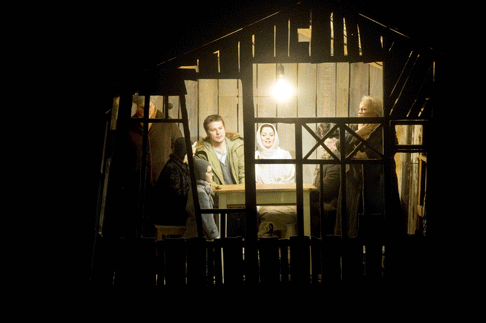 Maxim Aksenov as Prins Vsevolod Joerjevitsj and Svetlana Ignatovich as Fevronja
Maxim Aksenov as Prins Vsevolod Joerjevitsj and Svetlana Ignatovich as Fevronja
Act Three’s City of Great Kitezh is set in a makeshift field hospital, set up in a faded dance hall-cum-auditorium such as can be found in the back of selected Wisconsin taverns. Of course. That is what Kitezh would be like. Side bar: In the press kit, Mr. Tcherniakov’s “portrait” says that he “eschews all superficiality…(he) likes to travel to the place where the opera is situated in order to soak up the local color.” I guess Dmitri has been to a drunken Wisconsin Wedding Dance? Or am I being “superficial”? Back to Act Three’s peeling wallpaper…
After the afore-mentioned thrilling opening with baritone and ensemble, Vladimir Vaneev put his focused bass in the service of some heartfelt, plaintive singing as the ruler Prince Yuri Vsevolodovich. The moment he appointed his son to lead the war was heart-breaking and memorable. As the Page, Mayram Sokolova was rather dressed as a mother who welcomed her young son back from the fray. Her clear mezzo was pleasant, but somewhat impersonally utilized and her portrayal was marred by wild gesticulations. Costumes here were sort of, well, Amish(?) at first but then as the men prepare for war they take off their shirts (always a risky visual with an opera chorus) and the women dress them in white Cossack shirts, then later themselves don white babushkas. The men having left, the ladies tore velcro’d curtains off the three stage right windows and observed the battle quite placidly in silhouette as they drank wine.
The Tatars burst into the room intent on finding Kitezh which was now “invisible,” although the only suggestion of this was that the women’s chorus went upstage and silently sat on the “stage” for the rest of the act. Among the more bizarre costume choices (seemingly inspired by L.L. Bean), were the inclusion of two Santa Clauses. Yes, Virginia. The rampage is accompanied by a non-stop flickering neon light, up stage right again. (A hidden meaning? You tell me.) The “chaos” was almost comical in its excesses. A pent-up, juiced-up chorister leapt around so hysterically he seemed straight out of Cool in West Side Story. (“Easy, Action…”) Slaps and punches were so wide of their marks as to suggest an ersatz purse fight (and this from a director who eschews all superficiality). To give the devil his due, as motivation for Burunday to kill Badyay, Tcherniakov has the latter force Ferovnia to perform (carefully masked) oral sex on him, filling the avenger with murderous disgust. Refreshing clarity and honesty in the muddle.
And then…I felt like I had been to Lourdes…for a Miracle occurred and it was Act Four.
We were once more in a raked, black playing space with five massive towering trees reaching into the flies. The lighting effects came full circle and there were once again tightly focused, beautifully wrought specials. After malevolent-to-the-end Grushnik drags, hits and kicks Ferovnia well in excess of your average Apache Dance, he mercifully leaves her (and us) alone, and that is when magic, true Magic begins to happen. First and foremost from here to the end Svetlana never falters, offering flawless, emotionally tinged vocalizing that could make angels weep. Her gleaming instrument somehow becomes even richer, unstinting in her generous, ravishing phrasing. But the staging too grew in strength, not only recalling the splendors of the first act, but developing them even further.
As Ferovnia makes life’s ultimate transition, first the cabin is once again revealed, then a “rescue party” comes in pulling a long sled with a pillow on it. The two helpful birds (well-served by Jennifer Check’s direct, laser-like soprano and Margarita Nekrasova’s ripe, baritonal contralto) assist the maiden in going to sleep on the sled, now serving as a bier that they pull “home” to the cabin. When they arrive the black backdrop irises open revealing a golden-orange cyc and, as in the conclusion of the film Places in the Heart, the loved ones from the past including the Prince, Ruler, and Page join her in Paradise. Those final ensembles with those principles and those birds were irresistibly sung. Truth to tell, Nicolai wrote about twenty minutes more music than was needed. Just when you feel “that was it, how beautiful” another violin phrase transitions into a retread of music we have heard before. That said, Mr. Tcherniakov who was nothing but excessive for half of the evening, found no new invention to fill out that last repetitious segment, content to allow his principles remain around their improvised picnic dinner and simply sing marvelously. There was one final good effect as the blacks stole back in sealing the playing space while Ferovnia drifted down right and assumed a sort of fetal position in a tightly focused spot, recalling a similar moment at the opera’s start.
At evening’s close then, I was profoundly grateful to the always top flight Netherlands Opera for allowing us the opportunity to experience this seldom heard piece. I was in awe of so much of the musical execution especially Svetlana Ignatovich who was a revelation. And I came to believe that while director Dmitri Tcherniakov may more rather enjoy being a Euro Bad Boy, it is when he is being a Good Boy that his genuine talent emerges. When he is Good, he is very fine indeed. I would urge him to maintain the splendor of the first and last acts, and be far more truthful and discerning with the middle. Dmitri is already onto something ‘good’ here. With some serious refinement, it could be ‘great.’
James Sohre
image=http://www.operatoday.com/Kitesch_DNO_01.gif image_description=Svetlana Ignatovich as Fevronja [Photo by Monika Rittershaus courtesy of De Nederlandse Opera] product=yes product_title=Nikolaj Rimski-Korsakov: The Legend of the Invisible City of Kitezh and the Maiden Fevroniya product_by=Prince Yuri Vsevolodovich: Vladimir Vaneev; Prince Vsevelod Yuryevich: Maxim Aksenov; Fevronia: Svetlana Ignatovich; Grishka Kuterma: John Daszak; Fyodor Poyarok: Alexay Markov; Page: Mayram Sokolova; Gusli Player: Gennady Bezzubenkov; Bear Handler: Hubert Francis; Bedyay: Nikita Storojev; Burunday: Vladimir Ognovenko; Sirin: Jennifer Check; Alkonost: Margarita Nekrasova; Lead Singer: Iurii Samoilov; Conductor: Marc Albrecht; Director/Set Designer: Dmitri Tcherniakov; Costume Designer: Elena Zaytseva & Dmitrti Tcherniakov; Lighting Design: Gleb Filshtinsky; Chorus Master: Martin Wright; Extra Chorus (Tatars) Master: Boudewijn Jansen. product_id=Above: Svetlana Ignatovich as FevronjaUnless otherwise indicated, photos by Monika Rittershaus courtesy of De Nederlandse Opera
February 21, 2012
Victoires de la Musique Classique 2012
Manoury, also on the faculty at the University of California, San Diego, was influenced by Pierre Boulez and Karlheinz Stockhausen and is one of France’s most respected composers.
The opera’s world premiere, on September 24 at the Opera National du Rhin in Strasbourg, was well received by the audience and critics. It is a story of an old derelict who lives on the streets of modern day Strasbourg and calls himself Gutenberg. Could he be the same Johannes Gutenberg whose invention of movable type changed the world more than 500 years earlier in this very same town?
This writer was also there that evening and can report that the opera is based on late 20th Century composition techniques but always includes emotion, elegance and momentum. A young people’s chorus, with kids listening, talking or texting with their phones, was only one of the musical highlights. With flashbacks, it told the story of Gutenberg and his struggles in life. The opera was at once engaging as storytelling and powerful as music. Staged sparsely and effectively by Yoshi Oida and conducted by Daniel Klajner it was an evening of splendid vocal accomplishment. Bass Nicolas Cavallier sang the title role with Eve-Maud Hubeaux as his new friend and the fine coloratura of Mélanie Boisvert as the provocative “Hostess” of an internet cafe. Click here for a report (in French) on television channel Arte gives samples of the opera.
The Victoires de la Musique Classique, an awards show similar to the Classical Grammy Awards, features Renée Fleming as honored guest and spotlighted such singers as soprano Natalie Dessay, countertenor Philippe Jaroussky, soprano Nathalie Manfrino, contralto Nathalie Stutzmann, soprano Julia Lezhneva along with other classical artists. It is available for internet viewing this week here.
Frank Cadenhead
image=http://www.operatoday.com/victoires-classique-2012.gif image_description= product=yes product_title=Victoires de la Musique Classique 2012 product_by=By Frank CadenheadNatalie Dessay to go on sabbatical
The production was roundly trashed by the critics.
On her 2015 agenda, she says in an interview in the newspaper Le Figaro, will be to learn Russian, study yoga and maybe study the art of clowns. She will sing a scheduled “I Puritani” where she will work with her friend, the director Laurent Pelly. At the age of 46, she finds nothing to interest her now in the opera repertory but expressed her continuing passion for musical theater. The opera world might get a pass after her year off.
“Objectively, it’s not opera which bothers me, but certain behavior which I can no longer stand: the lack of artistic integrity, the singers who don’t come to rehearsals and the directors in the hall who tolerate that” she complains.
Her recording of the early songs of Debussy is soon to be released and she is looking forward to finally doing Laurent Pelly’s staging of Donizetti’s “Daughter of the Regiment” in Paris as well as the scheduled “Tales of Hoffman” in Barcelona and San Francisco. There will also be Handel’s “Julius Caesar” in a production by David McVicar at the Metropolitan Opera.
Click here for the complete interview (in French).
Frank Cadenhead
image=http://www.operatoday.com/Dessay.gif image_description=Natalie Dessay product=yes product_title=Natalie Dessay to go on sabbatical product_by=By Frank CadenheadFebruary 20, 2012
The Veronica Dunne International Singing Competition: Showcase Concert
The next competition will occur in January 2013, and this varied recital featured the three main prize winners from 2010, demonstrating their talents in a range of contrasting idioms and genres.
Established by Dr Veronica Dunne, Ireland’s ‘Grande Dame’ of singing, the Competition is designed to give young Irish singers the opportunity to complete on an international platform; it is, however, open to other nationals who are studying in the UK, and in this recital the Irish tenor Dean Power (3rd prize in 2010) was partnered by two South African sopranos, Pumeza Matshikiza and Sarah-Jane Brandon (1st and 2nd prize respectively).
We began with lieder: five songs from Schumann’s Myrthen Op.25, which the composer presented to his wife, Clara, as a wedding present. There was certainly much passion in the opening ‘Widmung’ (‘Dedication’), performed by Pumeza Matshikiza with ardent intensity; hers is a distinctive timbre, slightly burnished of tone and richly textured. Matshikiza certainly made an immediate impact on the audience; but, I found her undoubtedly striking voice slightly insistent, even overwhelming, in the intimate venue, and would have welcomed a little more dynamic ‘light and shade’. ‘Du bist wie eine Blume’ (‘You are like a flower’) was more poised, but again sensuous passion threatened to outweigh the innocence of the image of the beloved, ‘like a flower/ So sweet and fair and pure’.
A more delicate charm was conjured by Sarah-Jane Brandon in ‘Der Nussbaum’ (‘The walnut tree’); a gentle pianissimo conveyed the whispering of the blossoms and a well-judged rubato suggested the tentative expectancy of the young maiden dreamily listening to rustling tree, yearning and hoping for love. Brandon sustained and projected the melody in ‘Lied der Suleika’ (‘Suleika’s song’), although both songs would have benefited from a few more consonants.
Although a little stiff of manner, Dean Power showed much sensitivity to the text in ‘Die Lotusblume’ (‘The lotus flower’), tenderly shaping the closing image as “sie freundlich/ Ihr frommes Blumengesicht” (“she gladly unveils/ Her innocent flower-like face”). And, there was thoughtful phrasing from both singers in Power’s duet with Matshikiza, ‘In der Nacht’ (‘In the night’).
An operatic sequence followed, beginning with a magisterial ‘Come Scoglio’ from Brandon, demonstrating even tone throughout her range, a particular animation in the upper register, and an ability to negotiate the awkward leaps with sureness. We stayed with Così for Power’s rendering of ‘Tradito, schernito’: the recitative was intelligently delivered and again Power revealed a good sense of melodic line, but his tone is rather unyielding, at times sounding somewhat strained and taut. This was more of a problem in ‘Ecco ridento in cielo’ (from Rossini’s Il Barbiere di Siviglia) which lacked an Italianate gleam and was rather rushed. Matshikiza was an impassioned, rapt Mimi in ‘Si. Mi chiamano Mimi’, and although her intonation was not always secure, her rich forte clearly won the audience’s heart. Most impressive of the operatic selection was Brandon’s tightly controlled Willow Song, ‘Piangea cantando’ (from Verdi’s Otello), in which the soprano demonstrated evenness of tone and used a range of vocal colours to convey the drama and emotion of the scene.
With a change of pianist — Dearbhla Collins now taking over from the first-half accompanist, Mairéad Hurley — Brandon began the second half of the recital with Richard Strauss’s Four Songs Op.27. These offered her much opportunity to exploit her warm, full tone; the recurring refrain of ‘Ruhe, mein Seele!’ (‘Calm, My Heart!’) built to a satisfying climax, while ‘Morgen!’ (‘Morning!’) was more rapturously serene. Matshikiza followed with three songs by Debussy; her vibrant lyricism was perfectly suited to ‘Nuit d’étoiles’ (‘Starry night’), and in ‘Beau Soir’ (‘Beautiful evening’) the soprano’s intimate composure conveyed the mood of dreamy serenity.
Having been awarded the Dermot Troy prize for Best Irish Singer in 2010, it was left to Power introduce a distinctly Irish flavour into the proceedings, with performances of three twentieth-century songs, beginning with Bernadette Marmion’s ‘When you are old’. Power was more relaxed here, and in Philip Martin’s ‘Be still as you are beautiful’; his characterful performance of ‘The Fiddler of Dooney’ by Hamilton Harty revealed Power to be at ease with the simple folk style, and capable of communicating the energy and vitality of the idiom.
The romantic lyricism and easy melodic charm of three songs by Roger Quilter brought the evening to a satisfying close.
Claire Seymour
Click here for a photo gallery of the participants.
image=http://www.operatoday.com/Veronica_Dunne.jpeg image_description=Veronica Dunne product=yes product_title=The Veronica Dunne International Singing Competition: Showcase Concert product_by=Pumeza Matshikiza, soprano; Sarah-Jane Brandon, soprano; Dean Power, tenor; Dearbhla Collins, piano; Mairéad Hurley, piano. Wigmore Hall, London, Saturday 18th February 2012. product_id=Above: Veronica DunneBerlioz’s Roméo et Juliette — Opera with few words
Extracts from the piece are heard often enough, but hearing the whole work shows Berlioz’s intentions more clearly. This Roméo et Juliette is an orchestra-drama, where the story unfolds in the vivid musical tableaux the music evokes. Voices are only part of the orchestral palette, used solo or tutti when needed. to develop orchestral colour. This is a hybrid form, a semi-opera with arias and no “roles”. Just as Mendelssohn wrote Lieder ohne Worte, Berlioz wrote semi-operas without words. (Click here for a review of Dan Albright’s Berlioz’s Semi-Operas.)
This Roméo et Juliette was conceived to be heard on stage, for much of its impact is visual and theatrical. Hence the large orchestra and unusual instruments, and the massed choirs on this occasion dressed in jewel-hued shirts to highlight effect.
Although much is made of the works roots in Beethoven’s Ninth Symphony, perhaps it might be even more prescient to hear this Roméo et Juliette as part of a platform of new ideas about music drama that were growing in the 1840’s and 50’s. We think of Wagner and Verdi when we think of opera history, obliterating the altogether different approaches with which Mendelssohn and Robert Schumann were experimenting. That I think is the real significance of this piece. It’s an outgrowth from oratorio, but even more radically it is orchestra-theatre, very different from opera convention in its time.
Indeed, its connection to stage play is paramount. Berlioz became obsessed by Harriet Smithson when he watched her perform Shakespeare in Paris. The picture above is a contemporary print showing Smithson and Charles Kemble in Romeo and Juliet. In an age before close ups and amplification, theatre practice could have to have been more stylized than we’re used to now. Perhaps Berlioz, a music and theatre critic, intuited that good orchestral writing had the potential to express feelings in greater complexity than most actors were capable of. Berlioz’s flamboyance often seems to stem from a need to do bigger and flashier than anyone else. This extravagant emotionalism may have been what drew Wagner to Berlioz. How different it is from the elegance of Mozart and the charm of Donizetti! Sadly, just as Romeo and Juliet were doomed, Berlioz and Harriet were not happy together.
The Orchestra of the Age of Enlightenment must have enjoyed themselves, for each instrume4nt is a player in this piece. Berlioz was fascinated with instrumentation, and wrote the seminal treatise on orchestration cherished by Strauss and Mahler, and still useful now. Berlioz included the saxophone, then newly invented, long before the instrument became associated with jazz. Part of the fun in Roméo et Juliette is the way Berlioz highlights small details. An ophicleide (also a “new” instrument then) lurks among the trombone, darting out for a surprise attack in the opening “Tumulte” which depicts Montague/Capulet struggle. The ophicleide is “nastier” than a tuba, a flick knife as opposed to a scimitar. Berlioz is writing brutish street fight, expressing much more than words might do.
Many other witty effects like the percussionist standing stage front, so you can’t miss him, beating two metal bells. An allusion to the bells of the procession or to the Mass in general? In the “Queen Mab” sequence (the scherzo in part II), the magical fairy is evoked by delicate flutes and piccolo. Mendelssohn wrote his Overture to A Midsummer Night’s Dream in 1826, and discussed it with Berlioz when they were in Rome four years later. Similar luminous delicacy, more refinement here than in the rest of Berlioz’s sprawling, freewheeling adventure.
Although Patricia Bardon’s French was unintelligible (she was substituting at short notice), it wasn’t as much of a problem than it might have been. Juliette only sings for a short time, but her musical signature (plangent harps) lingers throughout the piece. She’s in a tomb, but not dead, as the music reminds us. John Mark Ainsley sang the tenor part, but Berlioz placed much more emphasis on Père Laurence, who gets the biggest “part” in this piece when he sings the recitative and aria that implore the Montagus and Capulets to make peace. The bass Orlin Anastassov was a powerful presence, using hiss voice to quell the tumult. The part evidently appealed to Berlioz, or it binds together all the orchestration, solo and tutti, vocal and instrumental. It’s also grand theatre.
Anne Ozorio
image=http://www.operatoday.com/Charles_Kemble_and_Harriet_.gif image_description=Charles Kemble (1775-1854) and Harriet Smithson (1800-1854) as Romeo and Juliet. Lithograph by François-Antoine Conscience(1795-1840). [Source: Wikipedia] product=yes product_title=Hector Berlioz: Roméo et Juliette product_by=Patrica Bardon; John Mark Ainsley; Orlin Anatassove. Schola Cantorum Oxford. BBC Symphony Chorus. Orchestra of the Age of Enlightenment. Conductor: Sir Mark Elder. Royal Festival Hall, London, 18th February 2012. product_id=Above: Charles Kemble (1775-1854) and Harriet Smithson (1800-1854) as Romeo and Juliet. Lithograph by François-Antoine Conscience(1795-1840). [Source: Wikipedia]La Traviata, NYCO
Apparently, what began as a joint venture between the Metropolitan Opera and the New York Philharmonic turned into a triple endeavor when the well-known conductor Julius Rudel, then the head of New York City Opera, decided to join the group, bringing City Opera from City Center to its new location in what was then the New York State Theater.
This greatly perturbed Bing, and his fears had a sound basis in elementary economics. After all, he reasoned, if two opera companies that are quite literally adjacent to each other are performing La Traviata, one for twenty dollars a ticket and the other for ten dollars a ticket, it’s fair to guess that the company selling ten dollar tickets would get better box office receipts.
That’s not exactly what happened. It is a sad fact of the history of “the people’s opera” that the company has perennially suffered from faulty management, both where financial and artistic matters are concerned. What’s more, City Opera management has spent decades trying to produce a product with the caliber of the Metropolitan Opera while lacking the Met’s monetary resources. Unfortunately, the company’s general directors in the post-Sills era have not been possessed of the fundraising talents that were almost innate in America’s operatic darling.
As far as the company’s artistic actions are concerned, City Opera has fared none the better. It should be no surprise if this statement brings names like Susan Baker, George Steel, and Gerard Mortier to mind. Susan Baker, a former Goldman Sachs executive, was elected to the post of Chief of the Board of Directors in 2004. While she might have had the financial sense, according to an article in Opera News by Fred Cohn, she managed to successfully involve herself in the company’s artistic procedures without much knowledge of how the artistic decisions of an opera company are made. Her largest faux pas in recent history was to entice Gerard Mortier, who was at the time finishing his tenure with the Paris Opéra, to come to New York after his contract in Paris ended in 2009 to head the company on Paul Kellogg’s retirement.
Gerard Mortier is one of the opera world’s major movers and shakers. He is a tireless promoter of modern works and edgy interpretations. Unfortunately, by the time Susan Baker contacted him, he was too used to working in Europe where arts organizations receive government subsidy. At this point, NYCO was already suffering from the deleterious effects of performing opera in the New York State Theater, a theater that was more suited to the New York City Ballet, which shared operations with NYCO. Instead of encouraging the company to look for a new theater, Mortier insisted that they renovate their own. This led to a multi-million dollar renovation, spearheaded by David H. Koch, for whom the theater is now named.
Unfortunately, due to the renovations, the company lost an entire season, except for one performance of Samuel Barber’s Antony and Cleopatra at Carnegie Hall. In this light, it is obvious to see why Mr. Mortier, who was planning among other things a staging of Olivier Messiaen’s St Francis of Assisi at the Park Avenue Armory, quickly resigned his post. In the scramble to find a new general director, the company contracted George Steel, someone whose only prior experience in the opera world was a fourteen-week stint as General Director of Dallas Opera. To be fair, he had previously turned Columbia University’s Miller Theater into a household name in the contemporary classical music scene. However, as both Mr. Steel and New York’s opera-going public soon found out, NYCO is or at least aspires to be an opera company, something that is far beyond the desires and monetary means of the Miller Theater.
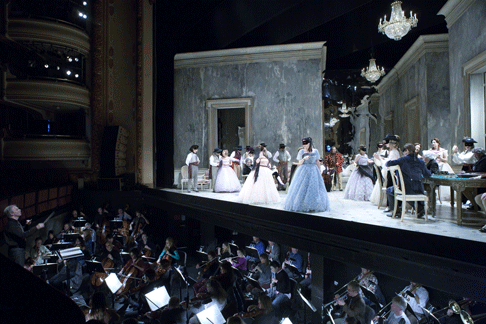 Scene from La traviata
Scene from La traviata
Also, as the company’s last season will attest, while it is important to present works of contemporary fare, such as Leonard Bernstein’s A Quiet Place, it is important to do so in a way that does not alienate the majority of the public, who at least at this point are interested in standard fare. Looking back on last season, it seems as if Donizetti’s The Elixir of Love is the only standard rep opera the company performed. Therefore, despite last season’s critical success, the company suffered a major blow at the box office.
This is why the company’s new production of La Traviata, directed by Jonathan Miller, is so important. Due to financially induced labor disputes, as well as the firing of many important personnel, such as the company’s Music Director George Manahan, NYCO, whose glorious past includes performers like Sills, Domingo, Ramey, as well as operas such as Moses und Aron, Die Soldaten, Giulio Cesare, and Donizetti’s Three Queens trilogy, now finds itself facing the need to prove itself as viable in New York’s — to say nothing of America’s — cultural landscape.
As a fervent believer in City Opera, I would be lying if I said I didn’t want them to succeed when La Traviata, the first of a four opera traveling season to take place in various locations in New York City, opened last week at the Brooklyn Academy of Music. This season, which also includes Telemann’s Orpheus, Mozart’s Così fan tutte, and the new opera Prima Donna by singer-songwriter Rufus Wainwright, demonstrates the opera company’s versatility. Unfortunately, as the previous sentence stipulates, that characteristic exists only in theory. It pains me to write that this rendition of Verdi’s great masterwork was one of the most tepid I have ever experienced.
As the soprano and tenor leads, Laquita Mitchell and David Pomeroy gave tentative performances at best. Pomeroy, in his debut appearance, had a better facility with bel canto technique, yet both Mr. Pomeroy and Ms. Mitchell lacked proper interpretation of text. There are moments in Verdi’s drawing room thriller that in the right hands crackle with dramatic tension. By and large, there wasn’t any tension in this performance at all. Furthermore, Pomeroy seems vocally to be closer to a tenore leggero, making him more appropriate for the hero of a Rossinian comedy, as opposed to the tenore di grazia that’s exemplified by such divos as Carlo Bergonzi or Jonas Kaufmann. As the performance progressed, Mitchell demonstrated greater ability with bel canto techniques. Unfortunately, at that point, the lack of dramatic verve was unfixable. The important thing to understand about Traviata is that although it is a bel canto opera, and therefore predicated on the use of such bel canto devices as appogiaturas and ornamentation, such techniques are used less for displays of vocal virtuosity and more for dramatic intensification. Furthermore, Traviata’s libretto can be divided into several key moments. Each moment is dramatically dependent on those that come before. Therefore, although Ms. Mitchell could be thrilling, such as in the final ensemble during Flora’s party scene, at that point, it seemed somewhat irrelevant.
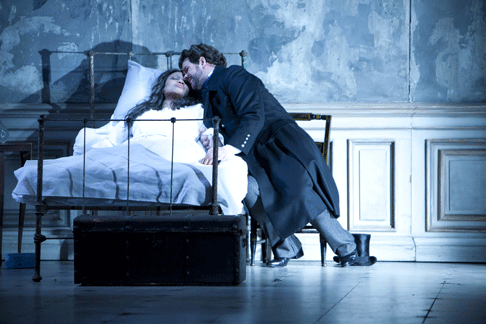 Laquita Mitchell as Violetta and David Pomeroy as Alfredo
Laquita Mitchell as Violetta and David Pomeroy as Alfredo
As Alfredo’s evil father, who comes between the two lovers, Stephen Powell, a veteran of NYCO, was exquisite as Giorgio Germont. His voice was reminiscent of the great early twentieth century baritone Titta Ruffo. Powell was equally worthy of Ruffo’s nickname, “Il leone” (The lion). He demonstrated excellent bel canto technique, making his Germont at once both evil and frighteningly parental.
In the pit, Steven White was at his best in moments of high-powered orchestral work (I never realized that the score of Traviata was populated with that many drumrolls). However, despite his facility with strong pacing, there were moments where his performance was lacking in just that quality. Such was the case when Alfredo returned in the second scene of Act III to his dying beloved. The lovers’ frantic embrace, which usually makes the subsequent waltz “Parigi O Cara” even more heart-wrenching, was somewhat lackluster. Ironically, his rendition of the overture, which contains the same waltz tune, was delightful for its almost imperceptible hint of tension.
If the performers lacked attention to text, Jonathan Miller’s production is faulty for extreme attention to text. Trained as a physician, his desire was to portray Traviata in the most literal light possible, which included a take on Violetta’s tuberculosis that was brimming with as much verisimilitude as possible. The problem here is that while it is true consumptives don’t waltz or run around, neither do they sing with what should be flawless coloratura technique. Miller’s production fails to understand that people who go to the opera realize that it is not an accurate depiction of life.
The point of seeing consumptives dying while singing legato lines is not to see an accurate presentation of someone dying from consumption. Instead, it is to experience what the consumptive is feeling, something that consumptives in reality do not have the capacity to fully express at such a time in their lives. Instead, Miller wanted his Violetta to spend the majority of her time lying on sofas and settees. While a waltzing or even standing Violetta might be medically unbelievable, at least it allows for dramatic veracity. During the confrontation, which occurs at Flora’s party, the moment where Alfredo throws the money he has won through gambling at Violetta’s feet lost dramatic veracity because she was unable to react to it with as much strength as the music allows her.
Lastly, Miller’s production, which is spare and grey, only seemed ingenious during Violetta’s death scene. Ultra-realistic productions such as Franco Zeffirelli’s 1999 Met Traviata may have its critics for its unabashed grandiosity. True, seeing a soprano belt out “Sempre Libera” while being dwarfed by a gigantic chandelier is comical; however, the same quality allows the audience to experience the exorbitant conspicuous consumption of high society in 1830s Paris. It is this conspicuous consumption that underlines the hypocrisy of the society and forms a major part of the central conflict. While Miller’s production thankfully has normal-sized chandeliers, its sets were decrepit and grey, which made it hard to believe that Parisian high society would dare to be seen in such a place.
Before the opera began, I noticed an energetic young girl and her family take their seats next to me. Her excitement at the occasion was palpable. She even brought her own pair of legitimate opera glasses, not the glorified sports binoculars that are more common nowadays. As the performance progressed, she busily whispered about it to her father. It was a joy to see such an excited young opera lover. Seeing her at what was potentially her first opera reminded me of the early operas I attended. For me, the fun of reminiscing about those occasions comes from discovering the important people and productions that I saw without realizing it at the time. Taking her to City Opera was a smart move on the part of her parents, as the company has a glorious legacy. However, City Opera still needs to prove that it can hold claim to such a legacy. Let’s hope it does so by the time she is old enough to appreciate it.
Greg Moomjy
image=http://www.operatoday.com/Traviata_NYCO_01.gif image_description=Laquita Mitchell as Violetta and David Pomeroy as Alfredo [Photo by Pavel Antonov courtesy of New York City Opera] product=yes product_title=Giuseppe Verdi: La traviata product_by=Violetta: Laquita Mitchell; Flora Bervoix: Karin Mushegain; Alfredo: David Pomeroy; Giorgio Germont: Stephen Powell; Gaston de Letorieres: Jeffrey Halili; Marquis d’Obigny: Krassen Karagiozov; Doctor Grenvil: Kenneth Overton; Baron Douphol: John Maynard; Annina: Jennifer Tiller. Conductor: Steven White. Production: Jonathan Miller. Stage Director and Choreographer: Elena Araoz. Set and Costume Designer: Isabella Bywater. Lighting Designer: Robert Wierzel. product_id=Above: Laquita Mitchell as Violetta and David Pomeroy as AlfredoPhotos by Pavel Antonov courtesy of New York City Opera
Erwin Schrott’s Don Giovanni, ROH
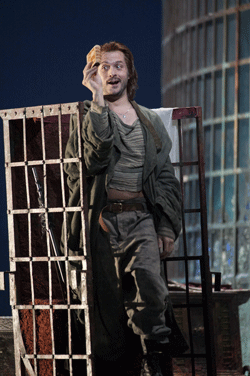 Alex Esposito as Leporello
Alex Esposito as Leporello
Schrott exudes charisma, which gives him an advantage not every singer can muster, for Don Giovanni is a larger-than-life personality who needs to be expressed in the grand manner. It’s pointless to nitpick a portrayal as passionate as this. Schrott creates Don Giovanni in all his malevolent glory — virile, confident, arrogant. bursting with animal sexuality, yet manages to hint at the manic obsession that drives the character. Schrott hints at these fears in brief, quieter moments, and slips back into macho mode with increased vehemence. Stunning. To match the well-toned voice he also has a well-toned body. At last, director Francesca Zambello’s bizarre idea that Don Giovanni should dine semi-naked with the Commendatore makes a little sense. You’re hypnotized by Schrott’s biceps and pecs, and forget, for a moment, how silly it is that he should be costumed like this for a banquet that he knows will be the biggest confrontation in his life.
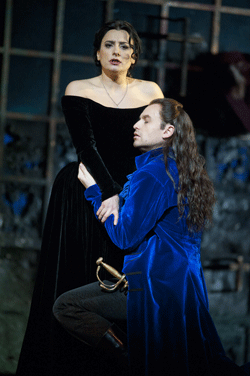 Carmella Remigio as Donna Anna and Pavol Breslik as Don Ottavio
Carmella Remigio as Donna Anna and Pavol Breslik as Don Ottavio
Schrott is brilliant but even he has to work within the limitations of Zambello’s brainless staging and untypically leaden playing from the Royal Opera House Orchestra, conducted by Constantinos Carydis. Also the more reason in this production to appreciate the efforts of the singers, who rise above what they have to deal with. Leporello, for example, should give Don Giovanni a run for his money. He’s a servant, but not entirely subservient. He’s also to some extent culpable for Don Giovanni’s crimes. But in Zambello’s production, he’s portrayed as a buffoon, even more peasant-like than Masetto’s peasant friends. Why would a sophisticate like Don Giovanni hire someone this bucolic? Nobody could possibly be fooled by this servant in his master’s clothes. So the production plays against anything Alex Esposito might make of the role. He sang in the 2008 version of this production, and has done the part many times, so he should have been aware how the production takes the bite out of whatever Mozart and da Ponte may have meant it to be.
Ruxandra Donose is a fiery Latin Donna Elvira, with a spirited edge When Donna Elvira sets out to confront Don Giovanni, she wears what looks like a dirty dress, hem ruched up over her calves in a way no aristocratic lady would dare to be seen. It’s probably not the way to play power games with Don Giovanni, master of intrigue, but Donna Elvira is no strategist. Donose’s “Mi tradi” takes on a wild air, expressing Donna Elvira’s emotional trauma. Donose has a very strong background in French repertoire, so imbibes its values of intelligence and clarity. This enhances her feel for the fundamental elegance of Mozart’s style, even in an opera which should be as dangerous as Don Giovanni.
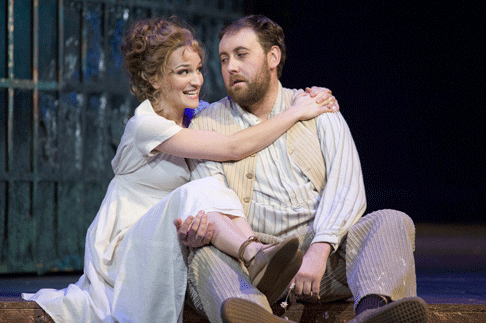 Kate Lindsey as Zerlina and Matthew Rose as Masetto
Kate Lindsey as Zerlina and Matthew Rose as Masetto
Carmela Remigio was making her Royal Opera House debut as Donna Anna, though she’s taken the part of Donna Elvira many times (Please read this interview in which she speaks about the challenges). She specializes in 18th century opera, so brings a late baroque sensibility to what she does. She’s far closer to the spirit of Mozart than this maudlin production deserves. She sings with tight focus, suggesting Donna Anna’s tension, struggling with feelings she can’t articulate. Her sexuality is aroused, but she’s trapped by what society expects of her.
Fortunately, Pavol Breslik’s Don Ottavio is sensitively portrayed and sung with more authority than the role usually gets. Donna Anna might luck out, after all. Breslik’s tender “O mio tresoro” was interrupted by the loudest snort I’ve ever heard from any audience. I don’t condemn coughing as it’s involuntary, but it’s not funny to choose to blow one’s nose with such violence at this point. It sounded like a boo, and was not at all fair on the singer.
Throughout this opera, Mozart plays with the idea of identity switchers, expressed through the balance of voice types. Kate Lindsey’s Zerlina was pert and bright, almost strident, but a good foil for Matthew Rose’s deep, authoritative Masetto. Inspired casting! (Click here for an interview of Kate Lindsey.) Rose’s Masetto is big in every way, not simply because he’s so tall : this is a resonant voice, one can imagine him taking on Don Giovanni, at a stretch, and certainly the Commendatore. As for the Commendatore he was hardly present at all. Instead, a huge golden object kept swaying in the background, eventually revealing itself as a giant hand, its finger pointing at Don Giovanni. One of the truly horrific moments in the whole repertoire, reduced to something out of Monty Python, worse still prettified and shiny. Whatever Reinhard Hagen might have done with his role, he was completely upstaged, for no obvious dramatic or logical reason whatsoever.
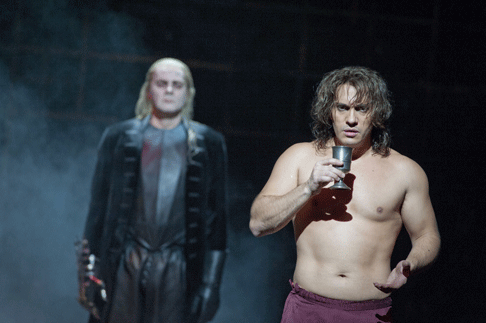 Reinhard Hagen as Commendatore and Erwin Schrott as Don Giovanni
Reinhard Hagen as Commendatore and Erwin Schrott as Don Giovanni
Judging from the audience reaction, this Don Giovanni should be a great hit, though not necessarily for the best artistic reasons. Many burst out laughing at the subtitles, as if to prove they got the joke. Yet if they really know the opera, they’d know it’s not a comedy. Its wit is savage irony, for the story is essentially tragic. Don Giovanni’s sex addiction is a sign of weakness, a symptom of the corruption of a power structure held together by exploitation. In this world of peasants and aristocrats, everyone gets screwed. Instead, Zambello’s production ignores these fundamentals, and plays up irrelevancies like the Madonna, crucifixes and the random objects Masetto’s friends carry for no clear purpose. This trivializes the drama by introducing an inordinate amount of stage noise, further encouraging new audiences to think of Don Giovanni as merry slapstick. This is Regie-opera at its worst, but because it’s scenic, those who don’t like directors will be fooled. So thank goodness for the singers in this cast, who have salvaged what they can, and used their experience and instincts to present a wonderful evening of song. For the singers, and for Erwin Schrott, this production should not be missed. (It runs to 29th February)
Anne Ozorio
image=http://www.operatoday.com/DON-GIOVANNI-10155_0435.gif image_description=Erwin Schrott as Don Giovanni [Photo © ROH 2012 / Mike Hoban] product=yes product_title=W. A. Mozart: Don Giovanni product_by=Leporello: Alex Esposito; Donna Anna: Carmela Remigio; Don Giovanni: Erwin Schrott; The Commendatore: Reinhard Hagen; Don Ottavio: Pavol Breslik; Donna Elvira: Ruxandra Donose; Zerlina: Kate Lindsey; Masetto: Matthew Rose. Conductor: Constantinos Carydis. Director: Francesca Zambello. Revival Director: Bárbara Lluch. Designs: Maria Björnson. Lighting: Paul Pyant. Fight arranger: Natalie Dakin. Original choreography: Stephen Mear. Revival choreographer: Duncan Macfarland. Royal Opera House, London, 16th February 2012. product_id=Above: Erwin Schrott as Don GiovanniPhotos © ROH 2012 / Mike Hoban
February 17, 2012
Don Pasquale on ARTE Live Web
By Frank Cadenhead [Opera Today, 17 February 2012]
February 17, 2012. Critics. Can you get along without us? It is possible to reflect on this when the production of Donizetti’s Don Pasquale is shown on television tonight. Critics always show up on the first night but how different will the third performance be on the Europe-wide channel Arte “live” (well, with a few hours delay at 10:10 p.m. CET) from Paris’ Théâtre des Champs Elysées?
Don Pasquale at the Théâtre des Champs Elysées
Critics always show up on the first night but how different will the third performance be on the Europe-wide channel Arte “live” (well, with a few hours delay at 10:10 p.m. CET) from Paris’ Théâtre des Champs Elysées? After tomorrow it will be available on their internet site, ARTE Live Web, and can be streamed to computers around the world for the next six months or so.
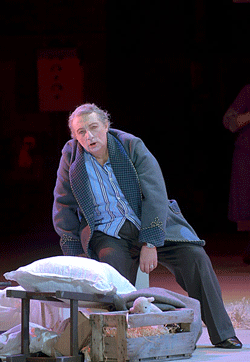
Will you like the staging? For our jaded eyes, having old Don Pasquale hawking cut-rate lighting fixtures out of the back of an old Citroën truck did not please. With our extensive opera-going history — part of the job — we have seen this kind of “update” so often before it seems a bit of a cliché. You might like the refreshing change from the beige, overstuffed furnishings he is normally surrounded with in traditional productions. Now a hardscrabble salesman, he still retains his sense of privilege by having the costumes for this production the work of Christian Lacroix and his suit, seen from the eyes of 1950’s Italy, has him sartorially splendid. The other major plus is that he is sung by the veteran Allessandro Corbelli and it would be hard to imagine another baritone today that could so effectively inhabit these clothes and so richly portray this delicious role.
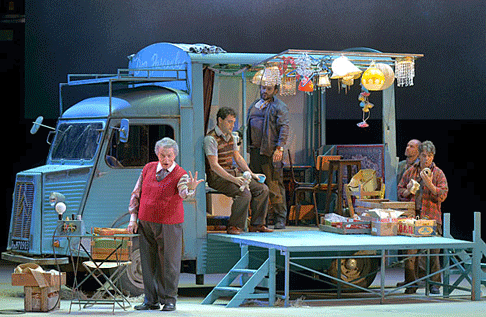
The director, Denis Podalydès, a regular at the Comédie-Française, here stages his second opera and the characters had carefully defined roles but he stuck with the traditional path of “opera buffa” with its broad gestures and overwrought emotions. The old man contracts to marry to smash the hopes of the nephew in his charge for an inheritance but the story has an old man emotionally swept away with the possibility of a new love in his life, from which he is brutally brought down. The young tenor Francesco Demuro, a name to note, is similarly wrought with passion for the young girl his disinheritance bars him from having. The flouncing free-spirited character of Norina rejects the contract of obeisance with a persistent broad brush. There is more detail to be mined in this story but new eyes watching this masterpiece of the genre for the first time will find the opera’s story clearly told with emphasis on fun and contrast.
Singing, in addition to the splendid Don, was at a high level. Italian tenor Francesco Demuro gets he first big aria, “Sogno soave e casto,” in the first minutes of the opera and there was a vague unease and occasional imprecise intonation we did not see later where his voice was rich in color and pleasing to the ear. With tonight’s performance, very likely, you will likely hear more assured and free delivery. Soprano Désirée Rancatore has recently developed into a serious star and, forced high notes excepted, gives a near-perfect reading of the self-assured girl, and, like her tenor lover, is young and appealing in the role. A very strong reading of Malatesta by Gabriele Viviani completes a exceptional vocal quartet.
The Orchestre National de France, one of France’s top orchestras, was in the pit and onstage was the excellent Radio France Choir. The dynamic conductor Enrique Mazzola, on opening night, did not have the orchestra’s undivided attention and attacks were imprecise. Later the orchestra seemed to warm up to their job and played with more care. The choir, wearing what Lacroix imagines locals were wearing at that time, had no trouble finding their volume or enthusiasm. The story, despite the reservations, was clearly told and the singing was generally engaging. After a dismal opera season so far in Paris even a modest success is more than welcome. If you have access to the internet distribution, it is recommended.
Frank Cadenhead
image=http://www.operatoday.com/Don-Pasquale_Paris_01.gif image_description=Photo by Vincent Pontet product=yes product_title=Don Pasquale at the Théâtre des Champs Elysées product_by=By Frank Cadenhead product_id=Photos by Vincent PontetThe Charterhouse of Parma in Marseille
These days at least three (Milhaud, Poulenc, Honegger) of the famous les six are still quite recognizable names. But in Paris during the musically vibrant 1920’s and 30‘s Henri Sauguet of les trois (a group that promoted les six, Eric Satie and themselves) was a quite well known name as well. Put all that musical baggage on top of an essentially Gounod sensibility and you have a good idea of the Sauguet poetic. At least operatically.
Both Stendhal and Sauguet claim to like simple art hidden in complex language. So Sauguet took on Stendhal’s difficult novel La Chartreuse de Parme to make it into a simple opera and just now the Opéra de Marseille resurrected this piece after 62 years of oblivion and made it a plausible candidate to enter the repertoire.
To a man the audience in Marseille will have read Stendhal’s novel, the story of a very complicated young man too much loved in too many ways by his very complicated aunt. He finally finds what he believes is love (though fortunately it is impossible love otherwise he would not have known what it was). The Church gets involved too.
It is a quite vivid work of fiction, thus every one of us at these Marseille performances intimately knew the cast of characters and voilà there they were! The real Fabrice in the person of tenor Sébastien Guèze and the equally real Duchess of Sanseverina in the person of mezzo Marie-Ange Todorovitch.
In the novel Fabrice has affairs with first an actress and then an opera singer (neither profession known for depth of personal character) before he finally succumbs to an infatuation with an adolescent girl, Clélia Conti, the only one of his lovers to make it into the opera. And there she was — soprano Nathalie Manfrino! Casting so perfect it was fiction itself.
Though baritone Nicolas Cavallier made a plausible Comte Mosca and baritone Jacques Calatatud made a good Barbone (the guard Fabrice beats up) the balance of the casting disappointed, particularly bass Jean-Phillippe Lafont as an uncomfortable, harsh, cruel General Conti rather than Stendhal’s very complicated courtier and caring father.
Neither Ludovic nor Theodolinde, tenor Eric Huchet and mezzo Sophie Pondjiclis had the physical or vocal edge to capture Stendhal’s vividly if minimally drawn characters that color Fabrice’s escapades in Bologna. Sauguet’s opera renders them as buffo relief rather than as Stendhal’s plot facilitators who just happen to be of impressive character.
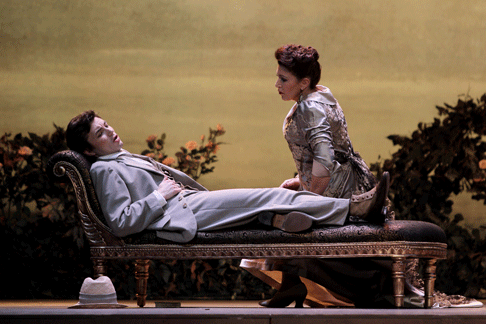
But that is the novel. It will have been a daunting task for Sauguet and his librettist Armand Lunel to reduce a famous six hundred page novel to a little (by comparison) theater piece, and to musically rather than narratively structure its scenes. They and the Opéra de Marseille actually succeeded fairly well in giving a taste, albeit a clumsy one, of Stendhal’s novel. There were the painful omissions, like the actress and the opera singer, and the far more painful reordering and recasting of Stendhal’s episodes to arrive at a convincing dramatic process.
But succeed they did. In Act I we had to come to grips with these plot changes, and accommodate an unfamiliar musical language. Very successful persuasion came from the pit, in the scope and sweep of big, very big and very sophisticated music that conductor Lawrence Foster drew out of his very willing orchestra. Mo. Foster has just been named music director of the Opéra de Marseille and has made a huge first impression negotiating this bit of post-Sentimentalism, not similar but so comparable to Cilea and Giordano in its over-the-top and distinctly over ripe Romanticism.
Marseille performed acts one and two as the first half of the performance, glossing over the crucial time lapse and change of place that transpires between the acts — a mistake because it kept us from digesting the dramatic and musical complexities that occur in a box at a La Scala performance. As it was the first half was dwarfed by the ball at the Sanseverina palace in Parma that was hugely long and complex, and musically handled so deftly by Sauguet that it resembled the best of Tchaikowsky’s ballets.
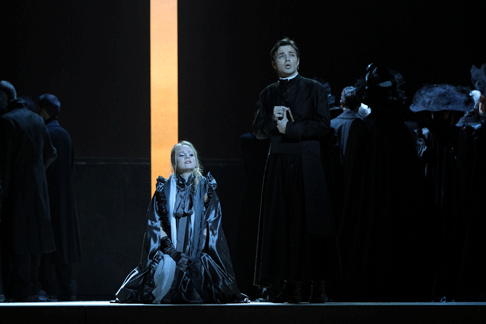
Acts three and four brought the lyric gifts of Sauguet to the fore. They are considerable. There was scene after scene of dizzying arias and duets for Fabrice and Clélia. Sauguet’s vocal lines are florid and elaborate, not with ornamentation but complex cantabile melodies that seem rarely to move stepwise, and often move in fifths, sixths, even octaves! These arias and scenes are quite extended (like Stendhal’s interminable accounts of the slightest movement of mind and soul of his protagonists), and in high tessatura.
Both young Sébastien Guèze and Nathalie Manfrino made it to the end. It was herculean. While Mlle. Manfrino did show some fatigue, she never faltered in a convincing delivery of Sauguet’s vocal line. Mr. Gueze has mastered a falsetto that he implemented from time to time, particularly at his death (without love Fabrice simply wasted away), when perhaps a full voice pianissimo would have been more effective. But after three hours at full forte, in fact a brilliant vocal and histrionic performance, this observation is purely gratuitous.
The opera was staged by Renée Auphan, the former general director of the Opéra de Marseille. To the great enrichment of operatic France she was the instigator of several equally interesting revivals during her reign. The production and staging was adequate at best. Though of period credibility the unfortunate costumes by Katia Duflot read as haute couture rather than as character completion. Sauguet’s opera could have profited from a more sophisticated production.
Michael Milenski
Click here for an English translation of the novel.
image=http://www.operatoday.com/IMG_4807-photo-Christian-DR.gif
image_description=Photo by Christian Dresse courtesy of Opéra de Marseille
product=yes
product_title=Henri Sauguet: La Chartreuse de Parme
product_by=Clélia Conti: Nathalie Manfrino; Duchesse de Sanseverina: Marie-AngeTodorovitch; Théodolinde: Sophie Pondjiclis; Une voix: Anaïs Constans; Fabrice del Dongo: Sebastien Guèze; Comte Mosca: Nicolas Cavallier; Général Fabio Conti: Jean-Philippe Lafont; Ludovic: Éric Huchet; Barbone: Jacques Calatayud; Le Maréchal des logis: Antoine Garcin; Un gendarme: Bruno Comparetti; Un geôlier: Frédéric Leroy. Opéra de Marseille. Chorus and Orchestra of the Opéra de Marseille. Conductor: Lawrence Foster. Mise en scène: Renée Auphan. Décors: Bruno de Lavenère. Costumes: Katia Duflot. Lumières: Laurent Castaingt. (February 12, 2012).
product_id=Photos by Christian Dresse courtesy of Opéra de Marseille
Verdi’s Aida at Lyric Opera, Chicago
Under the direction of conductor Renato Palumbo the Ethiopian slave Aida is sung by Sondra Radvanovsky, Amneris by Jill Grove, Radames by Marcello Giordani, Ramfis by Raymond Aceto, Amonasro by Gordon Hawkins, and the King by Evan Boyer. At the start of the overture Palumbo emphasized soft, legato playing among the strings with the cellos standing out in gradual contrast. In the middle segment of the overture familiar melodies associated later with specific characters and scenes were etched out with clarity and crisp playing. A return to piano delicacy rounded out the overture fittingly under Palumbo’s direction.
In Act One soon after the announcement by the priest Ramfis that direction will be given to the Egyptian army the first scene of divided loyalties features the officer Radames. Torn between his military ambitions and his love for the slave Aida, Radames gives vent to his emotions in the celebrated aria, “Celeste Aida.” Mr. Giordani sings here with an open, clarion approach, the top notes taken forte and with full confidence. In contrast, his final thoughts of the beloved are sung with an effective diminuendo. Mr. Giordani’s conception of the role and the complexities of character deepen as he proceeds into the following acts, so that softer modulations evident later appropriately enhance the initial impression given here. At the subsequent appearance of Amneris, daughter of the Egyptian king, Ms. Grove struck a challenging figure by infusing an Italianate sense of line with extremely effective low pitches. Her duet with Radames was occasionally overshadowed by the orchestra, yet Ms. Grove’s thrilling and secure top notes left her emotional ambitions for Radames clearly dominant.
At the entrance of Aida the musical scene develops into a trio in which Ms. Radvanovsky’s skillful piano singing suggested gradually oppositional relationships. Such a conflict is intensified in the following two scenes, first in the presence of the King and second in the temple of Vulcan. When the King, sung with well-controlled declamation by Mr. Boyer, announces Radames as the chosen leader to thwart the Ethiopian invasion, the soloists and chorus declare their enthusiasm. In response to the choral cries of “Ritorna vincitor!,” Aida sings her celebrated aria of the same line with intersecting thoughts on homeland and love. Here Radvanovsky’s middle range was especially well deployed with touching diminuendo and a beautifully produced final note on “soffrir.” In the final scene of this act located in the temple politics and religion focus again on the forthcoming battles and prayers for the victory of Radames and his troops. The choral exposition was here appropriately emphatic. As Ramfis the high priest invested Radames with the ceremonial sword, both Aceto and Giordani expressed their devotion with a noteworthy sense of legato.
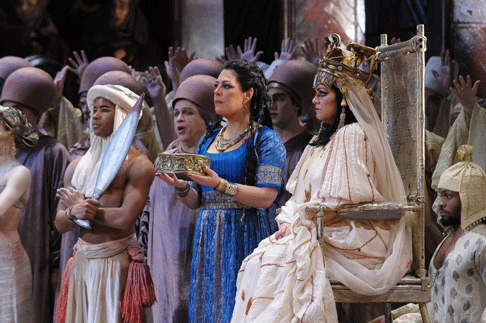 Sondra Radvanovsky as Aida and Jill Grove as Amneris
Sondra Radvanovsky as Aida and Jill Grove as Amneris
In the first scene of Act Two Amneris discovers indeed the secret of Aida’s love for Radames. In their duet Grove and Radvanovsky were dramatically convincing in their exciting duet “Fu la sorte.” Grove’s powerful notes on “Trema!” after confirming the truth expressed her determination to exact revenge. In response, Radvanovsky’s touching pleas on “Numi, pieta” drifted into the air but remained unheeded. As the outcome of the battles dominates the start of the next scene, Ethiopian prisoners are brought in after a parade led by the victorious Radames. A ballet conducted in honor of the King was especially well performed. The vocal ensemble with, on one side, Aida and her father Amonasro as an Ethiopian prisoner, on the other, Amneris, the King, and Radames was well staged and seamlessly conducted. The act ended with Grove’s triumphant declarations in response to the King giving her hand in marriage to Radames.
The single scene of Act Three of Aida on the banks of the Nile has often been emphasized for its dramatic and vocal significance. In this production the realistic atmosphere in the scene was introduced by a boat seeming to glide along the river. After Ramfis utters a prayer for Amneris and her marriage in the temple, Aida sings her romanza, “O patria mia,” surely a highlight of these performances. Radvanovsky assumes a bel canto line in her approach to the aria with exquisite high notes taken on “mai piu” and at its conclusion. In the following duet with her father Amonasro (“Ciel, mio padre”) both Radvanovsky and Hawkins show strong emotional commitment communicated through vocal line and use of rubato. During her impassioned exchange with Radames, Aida finally convinces her lover to flee (“Fuggiam”). The floating piano notes at the end of the duet belie the violent ending of the act when Radames is taken prisoner after the accusation of Amneris.
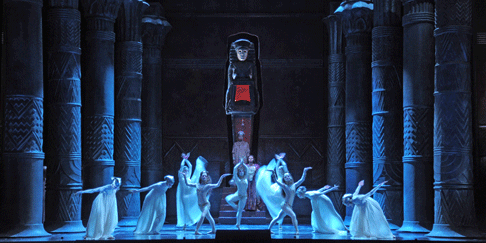 Scene from Aida
Scene from Aida
The final act of Aida places Radames in both scenes with the two women vying for his affections strategically divided. At first Amneris attempts to regain control by convincing Radames that she agrees to his defense before the judges. Grove’s transition from hushed notes to a dramatic top gives the impression of unhinged emotions. This heightened tension is enhanced during her duet with Radames. Once he refuses the intervention of Amneris, he also abandons himself to the tribunal. In response to his sentence of death Grove hurls a final dramatic curse at the judges with blood-chilling fury. In the final scene of Act Four Aida joins her beloved in the tomb to die at his side. Radvanovsky and Giordani sang their final duet, “O terra, addio,” with a renewed freshness as though their love formed a bridge to another world. As they sang their final notes in piano unison, Grove’s chants of “Pace” put a seal on their earthly life.
Salvatore Calomino
image=http://www.operatoday.com/Aida_Chicago_22.gif image_description=Sondra Radvanovsky as Aida and Marcello Giordani as Radames [Photo: Dan Rest/Lyric Opera of Chicago] product=yes product_title=Giuseppe Verdi: Aida product_by=Cick here for cast and other information product_id=Above: Sondra Radvanovsky as Aida and Marcello Giordani as RadamesPhotos: Dan Rest/Lyric Opera of Chicago
February 16, 2012
The Barber of Seville, Metropolitan Opera
As a young opera lover under the age of ten, my awe at the occasion requires no explanation. Needless to say, as I took my seat with the rest of my family in the Grand Tier, I felt like the ever-elusive “big kid” that young boys aspire to be. However, as soon as the conductor commenced the overture, to my consternation, I felt an overpowering urge to laugh. Therefore, what began as a potentially magical evening when a kid gets his first taste of adulthood was threatened by the possibility of immediately degenerating into a travesty. I was sure that if I had dared to laugh, some bejeweled grand dame would have given an inscrutable nod, leading directly to my removal from the auditorium.
My reason for laughing is quite simple: from the first bars of the overture, my brain immediately equated the music coming from the pit with the soundtrack of The Rabbit of Seville, the Looney Tunes cartoon starring Bugs Bunny and Elmer Fudd. Looking back on my first night at the Metropolitan Opera, I realize I must not be the only person that made that connection. Indeed, it is the very fact of the overture’s frenetic pacing, so characteristic of both Looney Tunes and Rossini, that allows the opera to speak so vividly to our modern times, just short of 200 years since the opera’s composition.
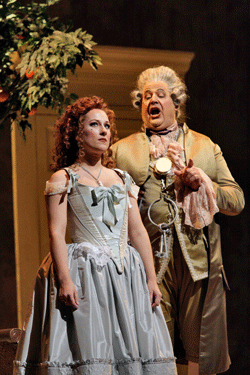 Diana Damrau as Rosina and John Del Carlo as Dr. Bartolo [Photo: Ken Howard/Metropolitan Opera]
Diana Damrau as Rosina and John Del Carlo as Dr. Bartolo [Photo: Ken Howard/Metropolitan Opera]
According to Benjamin Walton, author of the book Rossini in Restoration Paris, Rossini can be classified as a Romantic composer, not because he offers grand philosophical statements on human nature like Wagner does, but rather because his music inhabits a domain that is utterly sensuous. The sensuousness of his music combined with its ebullient pace makes the composer’s work the embodiment of rushed modernity. Walton’s book, however, only utilizes this framework to analyze musical political developments in 1820’s Paris. I believe, however, that in this light, Rossini’s sense of modernity is perennial. His indulgent musical language describes the hyperactive 21st century just as easily as it described a world trying to make sense of the French Revolution and its consequences.
With this in mind, it makes sense that Peter Gelb would contract acclaimed Broadway director Bartlett Sher, of The Light in the Piazza and South Pacific fame, to direct a new production of The Barber of Seville. This production, which was revived again earlier this season, was recently brought back for its Spring run. In the cast, Diana Damrau and John Del Carlo reprised their respective roles as Rosina and Dr. Bartolo. Figaro was played by Rodion Pogossov, while Colin Lee sang the Count. The team was led by acclaimed Rossini interpreter Maurizio Benini.
Mr. Benini has proven himself adept in Rossini operas. In recent years, he has conducted both Barber and La Cerentola. He has even led the company’s recent debut of Le Conte Ory. In every case, he has shown he is quite adept at Rossini’s fast-paced orchestration. Here, however, he also demonstrated his ability to match speed with lyricism. He aptly demonstrated the composer’s facility with creating instrumental blends. However, once or twice, most notably during Don Basilio’s “La Calunia” and the Count’s “Cessa di piu resistere,” he seemed to lose his stamina, but that in no way diminished his reading.
As the Count, Colin Lee was the definition of Bel Canto singing. He showcased a delightfully streamlined vibrato as well as stunning legato. It was a joy to experience a coloratura tenor who actually availed himself of every opportunity to demonstrate every facet of his vocal technique. He also depicted a sharper side of the traditionally lovestruck Count. This allowed the Count and not just Bartolo and Basilio to be the noble objects of satire in this opera buffa. He demonstrated this by plucking a guitar from the hands of one of the musicians accompanying him in his opening serenade to Rosina, as well as smacking Figaro with a guitar later on in Act I.
In the hands of Diana Damrau, Rosina is not another role, she is a phenomenon. As a critic, familiarizing oneself with various interpretations of the same role is part of the job description. However, when Damrau exploded onto the stage for “Una voce poco fa,” she managed to sprint out of the gates, leaving Maria Callas, Beverly Sills, Lily Pons, and Roberta Peters breathless in her wake. Opera fans are no doubt well acquainted with the text of “Voce.” In a section lauded for technical prowess, Rosina states that although she can be docile, loving, and obedient, if her affections should be abused, she can bite with the sting of a viper and before admitting defeat, she can play one hundred tricks.
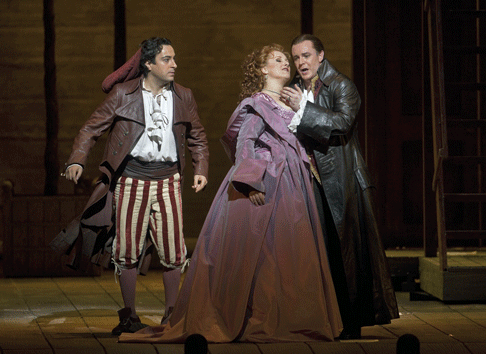 Rodion Pogossov as Figaro, Diana Damrau as Rosina, and Colin Lee as Almaviva [Photo: Cory Weaver/Metropolitan Opera]
Rodion Pogossov as Figaro, Diana Damrau as Rosina, and Colin Lee as Almaviva [Photo: Cory Weaver/Metropolitan Opera]
In the hands of any other soprano, these are just words, and no matter how well they are interpreted, they are confined to that one aria. In Damrau’s hands, she physically and vocally turned that text into a credo, something her Rosina didn’t state but rather lived for the entirety of the role. Her attention to text was breathtaking. She bounced onto the word “vipera” (viper). Her runs at the end of “Voce” had a slow build. This was a very audible demonstration that she could turn anyone, perhaps even the audience, into mincemeat. Additionally, her trills in “Dunque io son,” reflected a whole new light on the character.
In Damrau’s hands, these runs were less an expression of joy at requited love and more an affirmation of determination to win the day. It was plain to see that now that she knew her love was reciprocated, she would redouble her attacks on Bartolo. Despite her brilliance at portraying Rosina as a vindictive ward, the true mastery of her interpretation showed through in the character’s intrinsic humanity. There were moments, such as the recitative immediately following “Voce,” as well as the Act II aria “Contro un cor,” which illustrated that despite the tough veneer, she was perhaps an innocent girl who was seriously afraid of getting hurt by the men around her. During “Contro un cor,” her statements of “Darling, I’m begging you to save me” were true pleas for help.
John Del Carlo was an appropriately self-important Bartolo. His adroit Rossinian patter was a joy to hear. Ferruccio Furlanetto was a marvelously theatrical Don Basilio. As Figaro, Rodion Pogossov was a true team player in an opera predicated on ensembles. Unfortunately, while his amazing physicality was an asset in this bubbling comedy, his rendition of the famous “Largo al factotum” was a little weak. While other baritones such as Sherrill Milnes avail themselves of the musical comedy of this opera through such techniques as falsetto, Pogossov was a decidedly physical comedian. Despite his stentorian voice, the musical comedy of this aria went largely untouched.
Since The Barber of Seville, Bartlett Sher has come back to the Met to revive Les Contes d’Hoffman and to debut Le Conte Ory. Barber remains a decent harbinger of what was to come. The comedy of this production is largely predicated on elementary tricks of theater, which use their obvious nature to increase the comic effect. He also incorporated images from the text. The set is dominated by doors, representing Rosina’s trapped lifestyle. Also, from his very first appearance sleeping under a sheet in an armchair while the overture is still being played, Dr. Bartolo receives his full treatment as the satirized nobleman that is such a hallmark of opera buffa. However, this production has one major flaw: the lighting design, done by Christopher Akerlind, was a bit off. It was clear he was going for the look of a sun-drenched Andalusian atmosphere; however, most notably in the opening scene, the lights, consisting primarily of overpowering yellows and greens, were harsh and off the mark.
Despite a few blemishes, the Met’s Barber of Seville has demonstrated the staying power of this opera by disclosing certain aspects that have previously been hidden. When I left the opera house, I had new respect for the piece. I was reminded of why audiences return to this beloved opera again and again, while at the same time, I discovered new depth to the work. In short, I left with the respect for the work’s humanity, as well as its effervescent joy.
Greg Moomjy
image=http://www.operatoday.com/BARBIEREDamrauasRosina384a.gif image_description=Diana Damrau as Rosina [Photo Ken Howard/Metropolitan Opera] product=yes product_title=Gioachino Rossini: Il Barbiere di Siviglia product_by=Rosina: Diana Damrau; Count Almaviva: Colin Lee; Figaro: Rodion Pogossov; Dr. Bartolo: John Del Carlo; Don Basilio: Ferruccio Furlanetto. Production: Bartlett Sher. Set Designer: Michael Yeargan. Costume Designer: Catherine Zuber Lighting Designer: Christopher Akerlind. Conductor: Maurizio Benini. product_id=Above: Diana Damrau as Rosina [Photo: Ken Howard/Metropolitan Opera]Pountney directs Verdi’s Forza for Vienna
Instead of tears, titters can be produced if in the last act of Rigoletto, the soprano looks ridiculous dressed as a boy and the stage action makes it impossible to believe that she survived the stabbing by Sparafucile. The truth of Verdi’s music and fine singing can overcome that reaction, but a talented director can also help, by re-conceptualizing the scene. On an abstract set, in some other historical context or in contemporary dress, the action no longer feels cramped by expectations of theatrical naturalism. At least, that’s the idea…
Verdi and Piave’s La Forza del Destino can make Rigoletto’s story seem like something from Samuel Beckett. After an opening built around an errant gunshot that kills the enraged father of Leonora, who is about to elope with her lover Don Alvaro, the rest of the opera belabors coincidence amid tangentially related episodes (what does Preziosilla have to do with anything?) as Leonora’s brother seeks revenge on both his sister and her lover. No one who knows his work expects David Pountney to go the traditional route with this opera.
After viewing the 2008 production of Forza Pountney brought to the Vienna State Opera, however, the question is, what route did he choose? Working with set designer Richard Hudson, Pountney strips the opera of any geographical reality. The first half plays out on a white ramp with one end closed off in the shape of a wall. For the second half, with its battle scenes, some tower structures are added, with the platform remaining as a foundation. Costuming of the three leads tends to the drab and ordinary, with a decidedly contemporary look to the suits Hudson provides the men. Then Preziosilla dances on in a cowgirl costume, surrounded by Vegas showboys and showgirls in complementary outfits, and that fatal whiff of directorial condescension to the material creeps in. Instead of diverting a contemporary audience from the problematic nature of the Forza libretto, Pountney’s approach emphasizes the weaknesses.
The only strength Pountney brings to the show comes in his work with Nina Stemme, the Leonora. She is a tragic character almost from the start and as such risks tiring an audience with her constant pathetic appeal. Stemme adds a core of strength to the character, and though her voice lacks that warmth often called “Italianate,” her secure and smooth delivery are admirable. As her brother, Carlos Álvarez spends the entire show glowering, and though he has the right sound for the part — masculine, authoritative — he borders on comic villainy. The late Salvatore Licitra demonstrates why his once-promising career never quite fulfilled itself. He looks good, and at moments has exactly the heroic tenor sound one wants. Then he slips into lazy phrasing and passages where his intonation veers sadly off-course. Still, with so few singers able to take on these roles these days, his loss remains a very sad one.
Add to Pountney’s “ideas” having Alastair Miles sing both Leonora’s father and Padre Guardino. Miles handles both parts with impressive command, but if some point is being made, it barely seems worth considering. And do the tunics Miles and Licitra have to wear in the opening and closing scenes have some symbolic import? If not, they do serve the function of being unattractive.
Zubin Mehta also conducted a Forza released on DVD a few years ago. He knows his Verdi, and the singers never lack for dramatic support. The Unitel set has a thin booklet and no other special features. The credit sequence, with its animated sequence of a gun firing a bullet superimposed over rehearsal footage is a bad mixture of possibly good individual ideas. Even worse is when the gun imagery returns during the opera proper. Karina Fibich, credited as video director, should have rethought that one (perhaps it was Pountney’s idea).
So, for Forza on DVD, the best choice remains that old black and white version with Tebaldi and Corelli, on sets so flimsy they wrinkle when touched. It is doubtful even those singers could save, however, Pountney’s misguided approach.
Chris Mullins
image=http://www.operatoday.com/CMaj_708204.gif
image_description=C Major 708204 (Blu-Ray)
product=yes
product_title=Giuseppe Verdi: La Forza Del Destino
product_by=Il Marchese di Calatrava: Alastair Miles; Donna Leonora: Nina Stemme; Don Carlo di Vargas: Carlos Álvarez; Don Alvaro: Salvatore Licitra; Padre Guardiano: Alastair Miles; Preziosilla: Nadia Krasteva; Fra Melitone: Tiziano Bracci; Curra: Elisabeta Marin; Un alcalde: Dan Paul Dumitrescu; Mastro Trabuco: Michael Roider; Un chirurgo: Clemens Unterreiner. Vienna State Ballet. Vienna State Opera Chorus and Orchestra (chorus master: Thomas Lang). Zubin Mehta, conductor. David Pountney, stage director. Richard Hudson, set and costume designer. Fabrice Kebour, lighting designer. Beate Vollack, choreographer. Recorded live at the Vienna State Opera, 2008.
product_id=C Major 708204 (Blu-Ray) | 708108 (2DVDs)
price=$39.99 (Blu-Ray)
product_url=http://www.arkivmusic.com/classical/album.jsp?album_id=652019
February 15, 2012
Le nozze di Figaro, Royal Opera
2008, and 2010, now returns as part of the Royal Opera House’s ‘Da Ponte cycle’. I cannot help wishing that funds had stretched to commissioning three new productions, preferably from the same director, with a sense of how the works might actually cohere as a ‘cycle’. Nevertheless, and despite a good number of reservations I continue to entertain, McVicar’s production remains preferable to Jonathan Miller’s vulgar Così fan tutte, and, assuming it not to have been overhauled beyond recognition, Francesca Zambello’s vacuous Don Giovanni.
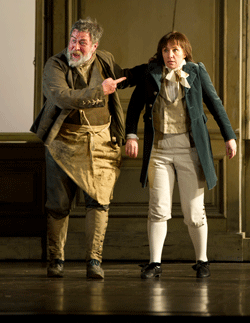 Anna Bonitatibus as Cherubino and Jeremy White as Antonio
Anna Bonitatibus as Cherubino and Jeremy White as Antonio
Moving the action to the 1820s does no Restoration period, but the motivation remains obscure. If the point be to highlight Talleyrand’s observation concerning the restored Bourbons, that they had learned nothing and forgotten nothing, then it needs to be made, not assumed. The Count’s droit de seigneur is a gross exaggeration in the eighteenth century; in the nineteenth, it merely seems incredible. ‘Absolutism’ was of course a nineteenth-century way of understanding the ancien régime, painting a complex society in the bold, often crude colours of monarchs such as Charles X. A good deal of sophistication would be needed to make the shift coherent, yet here the political seems notable for the most part by its absence. We have neither a society of orders nor an emergent class-based society, merely a house with hyperactive servants in attractive costumes. The result, whatever the intention, seems to be pandering to devotees of mindless ‘costume dramas’. It all nevertheless looks good, and certain moments are very well handled, especially the magical falling of dusk between the third and fourth acts. (Incidentally, when audience members are relentlessly intent upon disrupting the action with mid-act applause, why do they then fall silent at the end of an act? Mystifying!) The servants’ running about during the Overture remains an unnecessary irritant — can anyone really think that Mozart’s music deserves to be drowned out by footsteps? — and Leah Hausman’s revival direction, sadly, tends towards the Carry On school, only encouraging a vocal, puerile section of the audience, about which more anon.
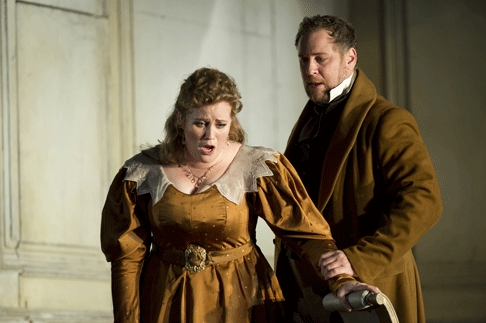 Lucas Meachem as Count Almaviva and Rachel Willis-Sorensen as Countess Almaviva
Lucas Meachem as Count Almaviva and Rachel Willis-Sorensen as Countess Almaviva
The greatest surprise of the evening was perhaps Sir Antonio Pappano’s conducting. There were problems: too often, he seems to view Mozart as aspiring towards Rossini, and the consequent motor rhythms have no place whatsoever in Mozart’s music. Certain aspects of phrasing also suffered in that respect, perhaps most glaringly in the Overture; articulation, where desperately needed, came there none. The use of natural horns was at best questionable; their rasping at the conclusion of Figaro’s fourth act aria was unpleasant in the extreme. That said, and with the notable exception of the end of the second act, Pappano did not harry the score; indeed, there were moments when he clearly communicated his delight in its subtleties. Woodwind might not have ravished in the way they did for Sir Colin Davis in 2010, but they seduced nevertheless. Tempi convinced for the most part, and there was little of the tendency towards mere ‘accompaniment’ that has often held back this conductor’s work previously. I seem to be the only person who regrets the ‘traditional’ cuts in the fourth act, but regret them I do.
Casting Figaro successfully seems trickier than one would expect. Even in 2010, a simply astounding male team of Erwin Schrott (Figaro) and Marius Kwiecien (the Count) had to endure sub-par contributions from their Susanna and Countess. Here the undoubted star was Aleksandra Kursak’s Susanna, ever musical, ever lively, and above all ever alert to the twists and turns Da Ponte and Mozart lovingly throw her way. One could not, for the duration of the performance, imagine it being done better any other way. Phrasing was telling but unobtrusive, likewise her sideways glances.
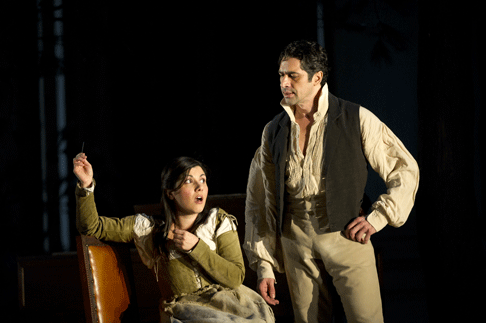 Ildebrando D’Arcangelo as Figaro and Susana Gaspar as Barbarina
Ildebrando D’Arcangelo as Figaro and Susana Gaspar as Barbarina
Ildebrando d’Arcangelo has never lacked stage presence, and his voice at its dark-chocolate best remains as attractive as his handsome visage and figure. There were, however, a good few moments, especially earlier on, when his delivery lacked focus. Lucas Meachem’s Count suffered similarly, though he also lacked his valet’s presence — a serious drawback, alas. Rachel Willis-Sørensen’s Countess was a serious disappointment: I have never heard ‘Porgi, amor’ so ill-tuned, nor so squally. She improved as time went on, but throughout lacked grace and, straightforwardly, character. The Cherubino of Anna Bonatatibus also disappointed: ill-focused and short-breathed. Even the Marcellina of a stalwart such as Ann Murray, an artist I admire greatly, sometimes sounded out of sorts. And would directors please cease their fixation with turning Don Basilio into a camp monstrosity? It is entirely unwarranted in either libretto or score, and has simply become a tedious cliché.
Finally, alas, a character that was all too present on this occasion: the audience, or at least a considerable section thereof. I had been tempted to open with the words, ‘more in sorrow than in anger,’ but that would have misled, for both emotions ran to the surface dealing with so disruptive a crowd. All manner of disruption was present, unremittingly so. Barely a bar went by without a cough or two. Objects were dropped left, right, and centre — and I am not referring to the stage business. A watch alarm made a charming accompaniment to ‘Porgi, amor’, though we had to wait a little longer for telephones to make their first appearance. Worst of all was the incessant, moronic laughter, perhaps to a certain extent elicited by more dubious aspects of the production; but really, if one finds someone walking onstage with a dog intrinsically hilarious, then one may need to seek treatment.
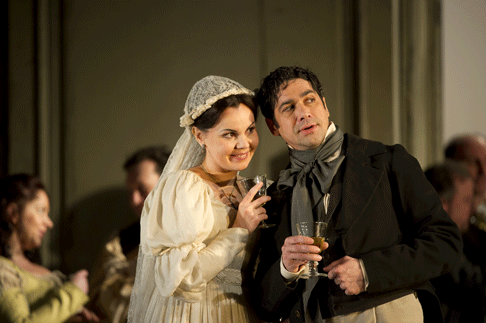 Alexandra Kurzak as Susanna and Ildebrando D’Arcangelo as Figaro
Alexandra Kurzak as Susanna and Ildebrando D’Arcangelo as Figaro
The slightest reference — via the surtitles, be it noted — to anything sexual was met with all the maturity of a convention for non-recovering Benny Hill Show addicts. I should say that those people needed to get out more, except I should much rather they stayed at home. Most unforgivable was the laughter that greeted those words: ‘Contessa, perdono’. McVicar’s production brings a true sense of revelation at that point, the show-stopping appearance of the Countess, ravishing and in more than one sense graceful, fully in tune with Mozart’s approaching benediction. What is even remotely hilarious about seeking a forgiveness that goes beyond even the humanity of the Countess to the Almighty Himself, that ‘peace … which passeth all understanding’? Even if somehow one were to find that hysterically amusing — presumably one would then guffaw through King Lear or the Missa Solemnis — one might have some regard for fellow members of the audience, those who might have come to hear Mozart’s score. As the gentleman seated next to me commented during the curtain calls, it made one long to be Ludwig II, alone with one’s art. None of this is, of course, in any sense the fault of the Royal Opera House, but perhaps an announcement requesting silence during performance and the occasional summary execution, pour encourager les autres, might be in order.
Mark Berry
image=http://www.operatoday.com/FIGARO-BC20120208275.gif image_description=Alexandra Kurzak as Susanna [Photo © ROH 2012 / Bill Cooper] product=yes product_title=W. A. Mozart: Le nozze di Figaro, ossia la folle giornata (KV 492) product_by=Figaro: Ildebrando d’Arcangelo; Susanna: Aleksandra Kurzak; Bartolo: Carlo Lepore; Marcellina: Ann Murray; Cherubino: Anna Bonitatibus; Count Almaviva: Lucas Meacham; Don Basilio: Bonaventura Bottone; Countess Almaviva: Rachel Willis-Sørensen; Antonio: Jeremy White; Don Curzio: Harry Nicoll; Barbarina: Susanna Gaspar; Bridesmaids: Melissa Alder, Louise Armit. Director: David McVicar; Movement, Revival Director: Leah Hausman; Designs: Tanya McCallin; Lighting: Paule Constable; Royal Opera Chorus (chorus master: Renato Balsadonna); Orchestra of the Royal Opera House/Sir Antonio Pappano (conductor). Royal Opera House, Covent Garden, London, Tuesday 14 February 2012. product_id=Above: Alexandra Kurzak as SusannaPhotos © ROH 2012 / Bill Cooper
Carmela Remigio as Donna Anna and Donna Elvira
MB: What are the greatest challenges and the greatest delights for you as an artist in singing the part of Donna Anna?
CR: My greatest challenge is to give Donna Anna a complex and faceted character. To let the audience feel how ambiguous and enigmatic she is. Passion and control at the same time. Musically, she is acrobatics every time she sings. A lot of high notes — maybe 35 natural A’s in just “Or sai chi l’onore”. A deep emotional strength is needed to play such a violent aria, so full of resentment, and a firm vocal control of all sounds as well. When I can reach this point, I am happy.
MB: Like Sena Jurinac, for instance, you have played both Donna Anna and Donna Elvira. Do you find that singing one role helps you understand the other? How would you characterise the differences between the roles, temperamentally and musically?
CR: Playing both roles has certainly helped me to better understand many aspects — how to interact with the other characters, what happens while I am off stage. Among the three women, Elvira is the most simple and clear. She is the one who had the wedding promise from Don Giovanni. They have had a three-day long passion, which is a lot for Don Giovanni …but he shirks, and she goes mad for being deserted, she runs after the fire but gets burnt and is devastated, until she decides she will not love any one any longer, and wants to enter a convent.
Anna is different. I like to imagine her meeting Giovanni at a masked ball. The two have an immediate feeling, maybe also an intellectual one. Mozart and Da Ponte do not describe Anna as a transparent woman. The words, the music are full of misunderstandings, agilities I see as emotional weaknesses, unexpressed uneasiness in the attitude she has to play, as a noble woman, towards a fiancé who does exist, and whom she probably loved a lot until she met Don Giovanni. But Giovanni is the passion, the woman’s mental perversion — which is what a fiancé will never represent.
MB: Donna Anna is the character who stands closest to the apparently ‘eighteenth-century’ world of opera seria, yet she also appealed strongly to the Romantics — ETA Hoffmann, for example. Do you see her as a character looking both backward and forward? Or do you think the balance lies more in one direction?
CR: I absolutely believe Anna is already the nineteenth century. Mozart is a genius. What he writes for Donna Anna is unique. “Non mi dir” reminds me of “Casta Diva”, and when singing it I must use the same legato and the same drama in the agilities.
MB: What desire, if any, do you think Donna Anna feels towards Don Giovanni? Is she just better at hiding her desire than Donna Elvira?
CR: Donna Anna lies. She does know her lover, and thus the one who killed her father, but…she has to lie. She has a fiancé, she cannot confess she betrayed him with her father’s killer. How many times in life you happen to lie to the man you love! I believe many women know this feeling of love and contempt for someone they long for and will never have. And they do not dare to tell their fiancé — who is actually loved as well — he is not the first in their hearts. This turmoil of thoughts is what places Anna higher than other Mozart women, and maybe the closest one to Don Giovanni for her emotional complexity.
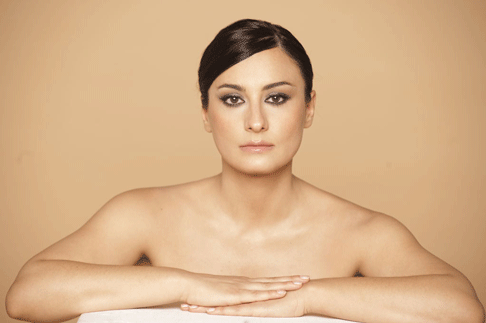
MB: Donna Anna also has a very strong relationship with her father. Do you have any thoughts about the nature of that relationship and its implications for her actions?
CR: I have never thought Donna Anna’s problem being her father. Mourning suddenly comes and upsets her mind, but I do not see any particular relation with her father as crucial for her emotional balance.
MB: Do you feel pity for Don Ottavio? His role is so often described as ‘thankless’, and one might say that that characterisation has much to do with the way Donna Anna treats him.
CR: I feel tenderness and also love for Don Ottavio. What makes Anna suffer is her awareness to betray someone she loves. How can you detest a man who says “Dalla sua pace la mia dipende” (my peace depends on hers)?
MB: Do you think she has anything in common with other Mozart characters? Elettra and Vitellia, for instance, both of which seria parts you have sung?
CR: Mozart female characters can have something in common. They are all interesting women, but different one from the other. Mozart shows he knows women’s sensitivity, weaknesses and strengths very well. Feeling and reason must live together in the purity of their cantos.
MB: To take another of your Mozart roles, Susanna, does that require an entirely different approach, both in terms of acting and vocal characterisation?
CR: Difficult Susanna…always on stage, with everybody, always singing…and at the end of the opera you have sore feet! Joking aside, Susanna kicks her legs up along the whole opera. Then the universe becomes still…and she sings “Deh vieni non tardar”…The aria is charged with high sensuality, a unique example of musical mastery. It is a very beautiful role, but she is very transparent as a woman.
MB: Mozart is generally praised for his sympathy towards female characters; that sympathy is what helps make them so believable, so human. Is that your experience, in this and other Mozart operas?
CR: I am just in love with Mozart. I wish I was his wife to know which folly these masterpieces would come out!
MB: Are there any other Mozart roles you are keen to play, whether now or in the future? Perhaps something from one of his earlier works?
CR: I would love to continue playing all the Mozart roles I have interpreted up to know.
MB: The male singers with whom you are working on this particular production — Erwin Schrott, Alex Esposito, and Pavol Breslik — are all artists whom I have admired greatly in other productions I have seen of Don Giovanni. How much does it help your own performance to be working with such fine actor-singers, and to interact with them on stage?
CR: It may seem an obvious reply, and it is open-hearted instead. I am really happy to play with this team. We work hard during rehearsals, but always with the right mix of play, fun and laugh. This helps the artistic outcome in a very positive way. With them it is possible to explore the infinite nuances of interpretation — which rises from the common wish to well accomplish a work we love and try to make it interesting. With Breslik, my partner on stage, I have a special musical and theatrical feeling.
MB: You have played Donna Anna in a production conducted by Claudio Abbado and directed by Peter Brook. What did you learn from collaborating with such distinguished artists? And how did you find their approach to Mozart, and to Don Giovanni in particular?
CR: I learnt a lot from my collaboration with Brook and Abbado. I was young enough, 23 years old, and could absorb all that an artist has to learn after studying the vocal technique for years searching for perfection. From Abbado I learnt the interpretative musical rigour, the Mozart style that must be impeccable and cogent, but also rich in musical nuances and thousand of colours. And then the use of the word and the consonant in the recitative. From Brook I learnt a very important thing he would always repeat us during a whole year of Don Giovanni on tour performance: “Forget you are an opera singer”. I cried at this at the beginning, then I understood that by detaching from myself I would let the right space for the character to seize me, and the voice would come out more freely. Still now, when I am on stage, I am Donna Anna for three hours. I cry, I love, give way to despair as she would do. Finally…I come back to Carmela only in my dressing room. He taught me that Freedom is Truth on Stage. And this has to go through minimalism and simplicity.
Carmela Remigio’s great love is for Mozart, but she also sings lyric soprano roles in baroque bel canto and Verdi. For more details, please see her website.
image=http://www.operatoday.com/carmela_remigio.gif image_description=Carmela Remigio [Photo Copyright Marco Rossi] product=yes product_title=Carmela Remigio as Donna Anna and Donna Elvira product_by=Interviewed by Mark Berry product_id=Above: Carmela Remigio [Photo © Marco Rossi]February 13, 2012
Ernani, Metropolitan Opera
Verdi introduces his guests, his fantastical characters, one by one, each with an aria-and-cabaletta construct, each on his or her entrance: “This is Ernani, the delinquent hothead in love; this is Elvira, who loves him back but is being forced to marry her uncle; this is the king, Don Carlo, a youthful roué”—but these warbles do not show them at their best. For one thing, none of them are comfortable on stage yet. They’ve only just arrived; it is cruel to expect flawless vocal feats the instant they appear, and these entrances, however well known, were nobody’s best music-making on the present occasion. Nor do these arias show Verdi at his best—as with any good host, he thrives on interaction, confrontation, agreement and disagreement among the proper mix of company. Only when the “guests” have begun to mill around the story, sample the hors d’oeuvres and reveal their souls (however slight those turn out to be) do we get the duets and trios and ensembles, the friction, the conflict, the harmony of a great occasion. Verdi would learn, in time, to present his characters without bringing them forward, to let us learn who they are in the course of an act or two, to let them surprise us.
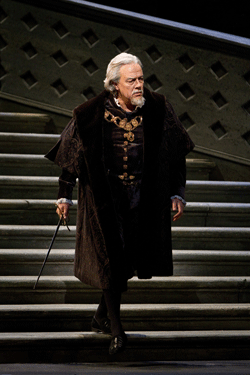 Ferruccio Furlanetto as de Silva
Ferruccio Furlanetto as de Silva
Verdi was a discriminating reader of plays, with an eye for “situations” and thrilling dramatic complexities, stories to which music would add a layer of thrill, pieces that were “musicable” (musicabile). This is a lesson American composers who attempt to make operas of untheatrical novels (Great Gatsby, American Tragedy) have foolishly ignored. Ernani, Verdi’s fifth opera and third great success is based on Victor Hugo’s hyperromantic assault on French classicism, which was right down the composer’s street, a breath of tuneful fresh air at gale force after the inane Solera poems he had been obliged to rescue hitherto (Nabucco, Lombardi). With Ernani, which was also his first collaboration with the librettist Piave who would give him Rigoletto and Traviata, Verdi had a stage-story whose every erratic twist and turn takes place right before our eyes. Hugo’s Hernani may seem ludicrous today, but its ludicrous actions are governed by logic; they build from their premises to a foredestined course, and the prime movers are the four principal characters, not ancient legends, hidden documents or offstage side plots. As Gabriele Baldini remarked, in his quirky study of Verdi’s operas, Ernani is a mating dance about three males each trying to chase off their rivals to get the girl to themselves. You can see walrus perform this sort of thing in the Arctic every year, with somewhat less bel canto line in their wails.
There is a grandeur even to what is farcical here, as there is in so much stage murder for honor and revenge. The codes of Passion, Honor and Vendetta were no longer fashionable in the urban circles of Italy, but their aroma lingers in the Mediterranean heart (and other regions then chic, such as Scott’s Scotland or, later, our Wild West); these feelings are too basic to us, howevermuch deplored—most law codes and ethical religions deplore Vendetta, and most believers pay lip service to that condemnation, if little more. The audience for Ernani when it was new, in 1844, could deplore the egotism of the characters but they were viscerally stirred by Hugo’s doomed love quadrangle. Like Wagner’s Tristan und Isolde, these people love more intensely than any real, sane people could in the mundane world where there are taxes to pay and housework to get done. Their love is beyond such quotidian matters. They love so much that they cannot live.
To perform Ernani correctly, all you need, as Caruso said of Trovatore, is the four best singers in the world—though the singers this time are not S-A-T-B but S-T-Bt-Bs. As in Trovatore, they should know how to sing Italian music properly (a given in Caruso’s day, not in ours), and be willing to howl it as if nothing in their lives was more important than reaching that top note and holding it forever without (apparently) taking a breath. Such matters can no longer be taken for granted. The current Metropolitan Opera revival rates a solid B for effort and achievement. Certainly acting and staging recalled the pre-modern age. Would you want to see a “Regie-theater,” Catalan or Germanic, quasi-pornographic Ernani? What on earth would it look like? As hideous as the Met’s last four Trovatores, probably. The opulent Samaritani sets for Ernani, with their miles of fine fabric and grand staircases dashing about in all directions, recall the luxe of castles in sixteenth-century Spain or opera houses a hundred years ago.
So did the Met have the best singers in the world on this post-Caruso, post-Ponselle, post-Siepi occasion? And did they sing as though their lives depended on it? I cannot say they were, or that they did. A solid B, which nowadays may be the best anyone can expect for blood-and-thunder Verdi.
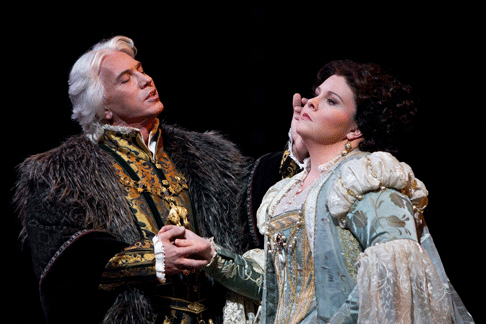 Dmitri Hvorostovsky as Don Carlo and Angela Meade as Elvira
Dmitri Hvorostovsky as Don Carlo and Angela Meade as Elvira
Roberto Di Biasio, a young tenor from Catania, Bellini’s home town, has a lithe, attractive voice, flexible and gracious, and he sings with passion when passion is called for—a major factor in Ernani. He does not have—or on this occasion was too nervous to attempt—the high C’s that can bring an opera house to its feet. He gave great pleasure without arousing enthusiasm. He is a slim, stalwart stage figure and struck whatever poses were called for from him.
Elvira was written for Sofia Loewe, later Verdi’s first Odabella in Attila and his original choice for Lady Macbeth; she must have been one hell of a singer, with extraordinary range and technique. Angela Meade made her stage debut in this role, replacing an indisposed Sondra Radvanovsky. On that occasion the debutante was naturally tentative, and she is not a born actress, but by the conclusion of that first performance it was clear she had chosen the right profession. Since that time she has commendably devoted herself to improving on her weaknesses. Today, she is a local favorite beginning to be more widely known, and she has Norma and Semiramide and Virginia under her belt—not to mention three Anna Bolenas at the Met last fall. She has had time to rethink Elvira, to recalculate the role’s tempo.
Her rich chest voice though not precisely certain of pitch in “Ernani, involami,” rose to that feature of her sound that her fans most admire, the detached head voice for personalized ornamentation, here expressing (perhaps) ethereal daydreams of true love. This lightness above the staff, this softness where so many sopranos are strident, is indeed delightful and Meade is wise enough not to overdo it, but it’s only fair to add that in the bel canto era, perfect evenness from top to bottom rather than separate voices was the ideal. Those sweet, pure notes ravish us and Meade has found ways to make them dramatically effective, but it has always seemed to me that her chest voice, the necessary base of a true Verdi soprano, is potentially her greatest resource. How long has it been since an Aida sang her duets with passion and could float high C’s? Meade may evolve into such a singer, a genuine spinto, and if she does the Verdi repertory will be hers to command. Just sayin’.
Don Carlo, Spain’s and America’s Charles the First, Rome and Germany’s Charles the Fifth (and Burgundy’s Charles the Second, lest we forget), should be a baritone of regal elegance and adolescent fervor as well as, at the last (Act III—he’s de trop for the finale), imperial force. Such baritones once abounded, and those were golden ages for Verdi’s operas; they may not exist today. Dmitri Hvorostovsky has the elegance and the dignity, and his voice is very lovely, but one thing they didn’t teach him in Siberia was how to sing an Italian line. He can sing many, but he cannot get from one phrase to another without a painfully audible gasping for breath, and this has always undercut the pleasure of his singing for me. He does not seem to encounter this problem in smaller opera houses (Houston, for example) or in the Russian repertory (Queen of Spades, War and Peace), but at the Met he is not a Verdi baritone to rank with Merrill, Warren, Bastianini, MacNeil or Milnes. (You see? We did have them once.) He made many gorgeous sounds on the present occasion, and many huffs and puffs between them.
Ferruccio Furlanetto, who has been singing everything from Mefistofele to Mephistophélès to Boris Godunov lately, took on the role of Silva, the honorable foe of young love. This can be a rewarding role for singers in easy command of the extremes of a basso cantante; Silva postures nobly and Verdi subscribes to his noble postures. Basses with self-knowledge or a belief in anything outside themselves lay in Verdi’s future, but Sparafucile, the first of those, was still seven years away. Furlanetto gave much pleasure but he is beginning to gasp between lines in a manner learned, perhaps, from Hvorostovsky.
Once the four characters have been introduced, we get down to business with the confrontational duets, trios and rousing ensembles that are Verdi’s natural element. All our singers were palpably delighted at the change, and all of them sang better than they had on first entrance. The evening rollicked along, staircase following staircase in the mazy sets. The acting remained stiff, but … it’s early Verdi; no one expects naturalism. “The trio,” Verdi told librettist, Piave, “should be the greatest number in the opera,” and so it is, as well as the last one. And while the coronation scene made a superb climax to Act III, that Act IV trio with Meade, Di Biasio and Furlanetto swept memory aside and could have gone on all night. The Ernani engine must be cranked like a tin Lizzie, but when it takes off, it’s a Lamborghini. The singers took the curves on two wheels and crossed the flags like winners.
One annoying bêtise of the Met production when it was new has been corrected. The double aria, “Odi il voto, il grande Iddio,” was inserted into the conclusion of Act II six months after Ernani’s premiere for the Russian tenor Ivanoff, at Rossini’s personal request. It intrudes on Hugo’s plot for no reason at all and muddles Verdi’s beloved dramatic momentum. The aria belongs in recitals (and on recital disks) when a tenor wants so show off in isolation, but the Met inserted it for this production because Luciano Pavarotti was the focal point around which the staging was created, and Pavarotti was an excellent motive so do so: For one thing, he could sing it, even after a previous double aria and any number of duets and ensembles. When the Met last brought this production back, either the conductor was too lazy to delete the piece or Marcello Giordani insisted on having as large a helping of the green stuff (Verdi, I mean) as the Pav had had: Anyway, sing it Giordani did, and badly he sang it. I am delighted that wiser heads have prevailed, and Verdi’s Act II is now given in its proper form, the last words belonging to tenor and bass, united for once—after all, the baritone has run off with their soprano.
John Yohalem
image=http://www.operatoday.com/ERNANI2448s.gif image_description=Angela Meade as Elvira and Roberto De Biasio as Ernani [Photo by Marty Sohl courtesy of The Metropolitan Opera] product=yes product_title=Giuseppe Verdi: Ernani product_by=Elvira: Angela Meade; Ernani: Roberto De Biasio; Don Carlo: Dmitri Hvorostovsky; Silva: Ferruccio Furlanetto. Metropolitan Opera chorus and orchestra conducted by Marco Armiliato. Performance of February 10. product_id=Above: Angela Meade as Elvira and Roberto De Biasio as Ernani [Photo by Marty Sohl courtesy of The Metropolitan Opera]A Set Malfunction in Darmstadt
By Frank Cadenhead [Opera Today, 13 February 2012]
It might have reminded some in the audience of the finale of Wagner’s “Götterdämmerung.” Saturday evening, during the finale of that same composer’s “Das Rheingold” at the Staatstheater in the German city of Darmstadt when a large section of the scene fell and shattered on stage.
Added Drama for Wagner
It was a piece of pressboard about 25 feet high and three feet wide and, on impact, a piece fell into the orchestra pit. No cast members were hurt but a member of the orchestra was hit in the head. She was taken to the hospital but was only slightly injured and was released later that night.
The Staatstheater management cancelled the remaining minutes of the sold-out opera. The police and the Office for Worker’s Safety have already begun an investigation.
Frank Cadenhead
image=http://www.operatoday.com/Darmstadt_Staatstheater.gif image_description=Staatstheater Darmstadt [Photo © Barbara Aumüller] product=yes product_title=Added Drama for Wagner product_by=Frank Cadenhead product_id=Above: Staatstheater Darmstadt [Photo © Barbara Aumüller]February 11, 2012
The Tales of Hoffmann, ENO
An opéra fantastique, with which Offenbach at the end of his career wished to show the world that he was not a mere purveyor of enjoyable froth, certainly offers plenty of opportunity for the surreally-inclined. (Jones’s controversial 1990s Ring for the Royal Opera House garnered plaudits and brickbats on that basis. Sadly, if not entirely unpredictably, it proved not to be Bernard Haitink’s idea of a Ring at all.) The pipe emblazoned upon the stage curtain and the pipes being smoked by Hoffmann and the students seem to hold the key to the director’s conception. Whatever it is that is being smoked would appear to lie behind the visions. Fair enough, but there is perhaps a little too much of the surface psychedelic, especially during the second (here, first) act, and not enough truly Romantic, Gothic darkness. We are dealing with Offenbach rather than Hoffmann himself, of course, but it would be beneficial to see, if not to hear, a little more of the hero, a still grossly underappreciated figure in the English-speaking world. (One really needs German.) Some of what we see resembles a little too closely Jones’s Covent Garden productions of Gianni Schicchi and The Gambler. Difficult though it may be to feel sympathy for the 1950s, a decade of closed-mindedness if every there were one, is it always necessary to send them up so garishly as in the Olympia act? (At least I assume that was what was being attempted.) Why a gorilla was wandering around the stage before and during the fourth (here, third) act, I simply have no idea. Its inclusion seemed to add nothing beyond reminding us of the ménagerie in that splendid production of The Gambler. The appearance of Dr Miracle as Antonia opens her music is very nicely handled, though, likewise the appearance of her mother’s voice through a gramophone trumpet. It is, then, an enjoyable production; costumes, movement, and lighting are all well handled in the production’s own terms. The same basic set is varied imaginatively between acts, providing a finer sense of overall framing than the production as a whole. I just could not help but think that Offenbach’s desire to be taken seriously might have been taken a little more seriously.
From the singers, there was much to enjoy. Barry Banks sang a decent enough English-language Hoffmann, though his style was more Italianate, occasionally jarringly so, than Gallic. If there was not an especially strong sense of Hoffmann as artist, especially at the end, then that was at least as much down to production as performance. Christine Rice, however, made a fine Nicklausse. (She also appeared as Hoffmann’s Muse, that doubling respecting Offenbach’s original intention.) Again, one could not help but wish that the words were in French, but Rice’s palpable sincerity won through time and time again, ‘Vois sous l'archet frémissant’ – I cannot recall what the English was – a particular, soaring highlight. Georgia Jarman, making her ENO debut, truly impressed by taking on all four of Hoffmann’s lovers: Stella, Olympia, Antonia, and Giulietta. Her characterisation varied, bringing something quite new to each of them. Antonia’s fate was rendered as moving as the production – and the music – would allow; Giulietta proved properly seductive; and save for a few slight intonational problems at the very beginning, Olympia’s mechanical coloratura was despatched with great aplomb. Catherine Young’s off-stage turn as the Mother’s Voice (a ghost, traditionally) was beautifully performed. Mention must also be made of Simon Butteriss, kept busy with four different roles: Andrès, Cochenille, Frantz, and Pitichinaccio. Clearly at home in drag as Cochenille, he also provided a wickedly camp turn as the servant Frantz.
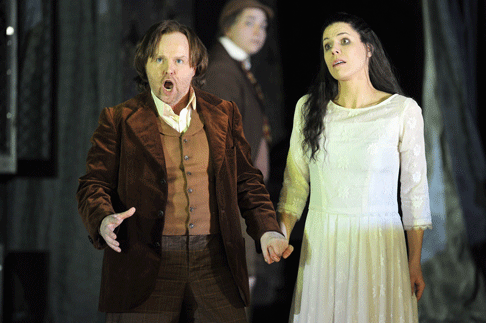 Barry Banks and Georgia Jarman
Barry Banks and Georgia Jarman
The ENO orchestra once again proved to be on fine form, though Antony Walker’s direction was less sure-footed. Here, at least, one might have hoped for a little more Gallic suavity; there were times when his approach veered a little close to thinned-down Tchaikovsky (less a point of view, it seemed, than a lack of idiomatic command). Given that the work was performed in English, spoken dialogue might have been a better bet than recitative. Amplification of the chorus at the end was surely both unnecessary and oddly sentimentalising, as if we had come to the end of a Hollywood ‘Romantic comedy’. Again, Offenbach’s desire to be taken seriously might have been taken more seriously. The production is worth seeing, and the cast certainly makes it worth hearing, but one would struggle to discern a message, let alone a Konzept.
Mark Berry
image=http://www.operatoday.com/Georgia_Jarman3.gif image_description=Georgia Jarman [Photo by Chris Christodoulou courtresy of English National Opera] product=yes product_title=Jacques Offenbach: The Tales of Hoffmann product_by=Hoffmann: Barry Banks; Stella, Olympia, Antonia, Giulietta: Georgia Jarman; Muse, Nicklausse: Christine Rice; Counsellor Lindorf, Coppélius, Dr Miracle, Captain Dapertutto: Clive Bayley; Spalanzani: Iain Paton; Crespel, Luther: Graeme Danby; Andrès, Cochenille, Frantz, Pitchinaccio: Simon Butteriss; Voice of Antonia’s mother: Catherine Young; Schlémil: Tom Fackrell; Students: Richard Gerard Jones, Luke Owens, Sebastian Sykes. Director: Richard Jones; Set Designer: Giles Cadle; Costumes: Buki Schiff; Lighting: Mimi Jordan Sherin; Movement: Lucy Burge. Chorus of the English National Opera (chorus master: Francine Merry); Orchestra of the English National Opera/ Antony Walker (conductor). Coliseum, London, Friday 10 February 2012. product_id=Above: Georgia JarmanPhotos by Chris Christodoulou courtesy of English National Opera
February 10, 2012
Dido and Aeneas, Manitoba
This co-production by the Manitoba Chamber Orchestra and Manitoba Opera brought 17th century English baroque composer Henry Purcell’s Dido and Aeneas to the stage, along with a selection of his other solo works and with works by Tallis and Handel.
The 50-minute Dido and Aeneas is heralded by many as the very first English language opera and, despite the lack of costumes or sets, it leapt to life before our eyes. This matchless ensemble was a joy from beginning to end. It was incredible to discover that while each splendid soloist was truly unique, possessing a timbre, expression and tone all their own, they combined as a chorus into a superbly blended unit. Taylor moved seamlessly from conductor to countertenor soloist (in the role of the evil Sorceress.) He led an accomplished seven-piece baroque orchestra (including lute) with a subtle touch, resulting in an impressively authentic rendition.
Soprano Noemi Kiss as Dido, Queen of Carthage, was in fine voice, sculpting deep feeling into her phrases, with the lightest of vibrato — suited to the era. We truly believed her when she sang of her predicament, her growing love for Aeneas. The famous aria/lament, “When I am laid in earth” was positively heart-wrenching as “remember me” hung in the air hauntingly, ensuring that we would.
Grace Davidson as Belinda, in whom Dido confides, brought a refreshing innocence to her role, with a lovely clarity of voice only curiously tinged with a somewhat lisping “s,” most noticeable in “Thanks to these lonesome vales …”
Aeneas was fittingly tall, dark and handsome with British-Canadian baritone Alexander Dobson truly living the part. Moving with dramatic conviction, he wooed Dido with his impressive range — a delightfully rich low register and surprisingly sweet ease up top as well. His flawless enunciation made the lyrics jump off the stage.
Taylor transformed himself from conductor to Sorceress by unleashing his mop of wavy hair and adopting a wild-eyed facial expression. With deliberation and intense audacity, he put forth his distinctive voice in a spotless soprano range, with timbre and texture that are purely Taylor. His divinely voiced cohorts, witches Meara Conway, soprano and Meg Bragle, mezzo were deliciously conniving, chuckling over their conspiracy.
Agnes Zsigovics as the Second Woman brought the same ringing tone she employed in her earlier solo, “Pilgrim’s Home” from Handel’s Theodora. Her clean, assertive style sets her apart.
Tenor Benjamin Butterfield had but a cameo role as the sailor in the production, but how he milked it! With true nautical spirit, he urged his colleagues on with smiling singing and plenty of hand rubbing. Fortunately, we had another opportunity to hear this peerless artist in “Total Eclipse” from Handel’s Samson in the first half of the program. We were immediately struck by the ease and passion of his delivery and the dazzling tone purity.
The epitome of control, the chorus ended this mesmerizing performance with a gossamer sadness that left the audience silent — until they erupted into a much-deserved standing ovation.
Gwenda Nemerofsky
image=http://www.operatoday.com/Henry_Purcell_by_John_Closterman.png image_description=Henry Purcell by John Closterman product=yes product_title=Henry Purcell: Dido Aeneas product_by=Theatre of Early Music and Manitoba Opera/Manitoba Chamber Orchestra, Westminster United Church, Winnipeg, February 7-8 product_id=Above: Henry Purcell by John ClostermanIl nuovo Teatro dell’Opera di Firenze
By Frank Cadenhead [Opera Today, 10 February 2012]
February 10, 2012. Who says Italian opera is in the doldrums? Contrary to all the recent budget bad news from the country that invented the form, the dramatic new 150 million Euro ($200 million) opera house in Florence projects another view. The house was far enough along for a celebratory opening concert December 21st with Zubin Mehta conducting.
Opera in Florence Has a New Home
The house was far enough along for a celebratory opening concert December 21st with Zubin Mehta conducting.
Mehta, the music director of the Florence’s opera theater, exclaimed “How the new theater is at the top of the glorious history of the Maggio Musicale and Florence; It is both my wish and my engagement.”
The new Teatro dell’Opera di Firenze, designed by the firm of architects ABDR, has a 1800-seat opera house. A smaller hall, seating 1100, will be mainly for concerts and recitals. Also part of the complex is an 2000 seat open air facility. The Italian government provided half of the funds with the city and regional governments both equally responsible for the other half.
The opera’s historic home, the Teatro Comunale, will continue to host the current season while finishing touches are added to the new building’s back stage and other work areas. The official opening of the season in the new house will be on November 24 with Mehta conducting a performance of Puccini’s “Turandot.” On the schedule too is a Ring Cycle, originally seen in Valencia, by Carus Padrissa and La Fura dels Baus — something not possible to stage in the old house.
Frank Cadenhead
Click here for a photo spread of the new facility.
Click here for a short video introduction.
image=http://www.operatoday.com/Opera_Firenze.gif
image_description=Il nuovo Teatro dell'Opera di Firenze, Maggio Musicale Fiorentino [Photo by Massimo Sestini]
product=yes
product_title=Opera in Florence Has a New Home
product_by=By Frank Cadenhead
product_id=Above: Il nuovo Teatro dell’Opera di Firenze, Maggio Musicale Fiorentino [Photo by Massimo Sestini]
February 9, 2012
Alagna Changing Fach?
By Frank Cadenhead [Opera Today, 9 February 2012]
February 9, 2012. In today's edition of the Viennese newspaper, "Die Presse" a reviewer gushes over Robert Alagna's recital yesterday evening at the Vienna State Opera.
Another Tenor Drops Down?
What will surprise many of his fans is the report that, at the very end of his recital, Alagna sung the Serenade from Mozart’s “Don Giovanni,” likely the first time that any audience has heard Alagna sing baritone. The critic raves: “such refined phrasing, it has not sounded so well on this stage since Cesare Siepi.”
In an interview published on the day of the recital, Alagna also talks about Woody Allen wanting him for a film to be made in Rome. Stay tuned…
Frank Cadenhead
image=http://www.operatoday.com/Roberto_Alagna.gif
image_description=Roberto Alagna
product=yes
product_title=Another Tenor Drops Down?
product_by=By Frank Cadenhead
product_id=Above: Roberto Alagna
February 8, 2012
Gustav Mahler: Das Lied von der Erde
Wunderlich is not unknown with this piece, since the Mahler discography includes a masterful studio recording of Das Lied with Christa Ludwig, alto, and Ottol Klemperer, conductor (an EMI recording with the Philharmonia Orchestra). While that EMI release offers the customary version of Das Lied with tenor and also, the Krips recording presents the work in the other scoring Mahler sanctioned, the one for baritone and tenor. While convention tends to favor the tenor and alto pairing, the tenor and baritone version is also effective, especially when it involves such talented performers as Wunderlich and Fischer-Dieskau, who were particularly moving in this 1964 recording.
As the culmination of Das Lied, the final song, “Der Abschied,” requires attention to the details of line and orchestration in conveying the symphonic expression of orchestral song. In this recording Fischer-Dieskau offers a moving performance, which is sensitive to the poetic and musical line. Dynamic levels and timbre are impressive in this recording, which gives a sense of leave-taking, but not resignation. The final section of “Der Abschied” merits attention for the manner in which the baritone resolves the dramatic climax of the music line in the iterations of the work “ewig” (“forever”) with which the piece concludes. While Fischer-Dieskau’s later recordings of Das Lied with Murray Dicke (conducted by Paul Kletzki) and with James King (conducted by Leonard Bernstein) have been available for years, this performance by Krips preserves the Fischer-Dieskau at an earlier point in his career. The orchestral playing is laudable in an interpretation that suggests accompanied song, without the emphasis on symphonic elements which emerges in other performances.
In addition, the close miking in “Der Einsame im Herbst” gives a sense of the precision Fischer-Dieskau brought to the concert, with well-articulated consonants, extended vowels, where necessary, and elegant phrasing. While the recording contains some stage or audience sounds, they never detract from the overall impression of this moving performance. In “Von der Schönheit” Fischer-Dieskau evinces the delicacy the piece requires, especially when the scoring involves the lower timbre of a baritone. In this song, Krips offers nice contrast in the middle section, with the fast tempo never challenging Fischer-Dieskau’s ability to enunciate the text precisely, with the accompaniment valiantly matching the vocalizing.
In the tenor songs, Wunderlich is as impressive as he is on the studio recording. The opening song “Das Trinklied von Jammer der Erde” is a tour de force. The urgent tempo with which Krips starts the piece affords Wunderlich the chance to demonstrate his facility with the musical line and the exquisite diction in rendering the text. Based on a radio broadcast, the sound is clear, but sometimes dry and less textured than found in later, stereo recordings. It is nevertheless possible apprehend Krips’ command of the orchestra, and his persuasive interpretation of the score. In “Von der Jugend,” Wunderlich is also impressive, with his phrasing of the text fitting well into Mahler’s musical line. Here the timbre is evidence of Wunderlich’s command of this piece, as he meets the demands of the song consummately. The third of Wunderlich’s pieces, “Der Trunkene im Frühling” complements the other two performances, with the interpretation giving a sense of the song without some of the overstatement which some performers bring to the sense of inebriation implicit in the text.
This release makes a famous performance of Das Lied from 1964 available in a modern release. As part of the Wiener Festwochen, the recording is evidence of the presence of Mahler’s music around the time that the general public rediscovered Mahler’s music. The solid interpretation Krips brought to the score shows the conductor’s solid grasp of the score and his solid sense of Mahler’s style. Mahlerians should appreciate this release for the contribution it offers to the composer's discography.
Jim Zychowicz
image=http://www.operatoday.com/DG_4778988.gif
image_description=Deutsche Grammophon 0289 477 8988 8 [CD]
product=yes
product_title=Gustav Mahler: Das Lied von der Erde (The Song of the Earth)
product_by=Fritz Wunderlich, tenor; Dietrich Fischer-Dieskau, baritone. Vienna Symphony Orchestra. Josef Krips, conductor. [Int’l Release 12 April 2011]
product_id=Deutsche Grammophon 0289 477 8988 8 [CD]
price=$18.99
product_url=http://www.arkivmusic.com/classical/album.jsp?album_id=468867
Il trittico in Lyon
So here is the Trittico he gave the Lyonnais (note that this difficult Puccini work is three little horror stories, very loosely and ironically structured as hell, heaven and purgatory):
Mr. Pountney’s point of departure was to relate the three stories each to the next. Michele’s murder of Luigi seemed to be among the presumed serial murders of young dock workers seduced by Giorgetta, ritual killings that somehow purged their horror at the death of their young son. Sister Angelica consumes the body and blood (bread and wine) of the son of God in a sort of sacrificial black mass that excites a vision of her dead son during her final moments of life. And, well, Frugula and Talpa from Tabarro reincarnate themselves in Gianni Schicchi as Gherardo and a pregnant Nella with a baby in a carriage and an annoying seven year-old son on roller skates.
Maybe you prefer Puccini’s shock and awe versions of the same stories.
The mise en scène fortified the thematic unification. In Tabarro there was a box that was supposed to be a ship container, in Suor Angelica the same box became a tabernacle and in Gianni Schicchi it was a coffin though it had multiplied itself into many more boxes that were safes filled with boxes of spaghetti and cans of tomato sauce. Colors too brought things together conceptually. The Tabarro container was within a huge stage box of small shiny black bricks (hell). The Suor Angelica box was in a stage box cloister of small shiny white bricks, thousands of them (heaven). In Gianni Schicchi the little bricks of the visible side walls seemed the color of pasta al pomodoro.
Of the three operas Il Tabarro was the most successful for a number of reasons, the first of which was that the top of the ship container box had cables and a hook that suggested it would disappear after that act. At first there seemed no reason to think that this little théâtre guignol piece was not being taken at face value, and even Mr. Pountney’s little twist at the end seemed fun. All the nuns in Suor Angelica disappeared under identical massive white habits so they all looked exactly alike. Therefore Sister Angelica seemed to have no personality whatsoever but that did not really matter once we understood that the opera was not about her but about a play on the Catholic mass.
Things fell apart in Gianni Schicchi where Mr. Pountney displayed his sense of fun in runaway character expositions that dwarfed Puccini’s own idea of his comedy. Specifically the campy antics of a very fey Marco (son of Simone), not to mention the fellatio and cunilingus enacted by Rinuccio and Lauretta. Then there were the witnesses to the writing of the new will who upstaged the whole scene by busily and noisily eating, yes, spaghetti al pomodoro.
Even a stellar cast could not have saved this production. As it was the Opéra de Lyon assembled a number of promising young singers and a few (but not enough) seasoned performers who mostly held things together on the stage. Of particular notice was the Brazilian born, Italian nurtured tenor Thiago Arancam who allowed Luigi’s passions to burst forth with tenorial flair and dramatic reality. Hungarian soprano Csilla Boross sang securely and acted Giorgetta with conviction but did not find the ultimate rapture of Sister Angelica, victim of the production. Bass-baritone Werner Van Mechelen is an accomplished artist who made both Michele and Gianni Schicchi into vocally and dramatically vivid characters. Wynne Evans and Paolo Battaglia were appropriately cast as Tinca and Talpa, and carried age and experience to Gherardo and Simone in Gianni Schicchi.
Of notice as well was Austrian born, Israeli nurtured mezzo soprano Natasha Petrinsky who is not yet an accomplished enough artist to bring Frugola alive, nor old enough and complicated enough to impersonate Suor Angelica’s evil aunt, and not grand enough to make Zita a comic force. She is a very promising artist. Neither tenor Benjamin Bernheim nor soprano Ivana Rusko, both house singers at Zurich Opera, are sufficiently finished artists to have been asked to take on the roles of Rinuccio and Lauretta in Gianni Schicchi.
Young Sicilian conductor Gaetano d’Espinosa made natural and convincing verismo in the pit, aided by the naturally harsh sound of the Opéra Nouvel and its fine orchestra. Il Tabarro was his best effort, perhaps motivated by the splendid vocal force of the principals (Mlle. Boross, messieurs Arancam and Van Mechelen). Suor Angelica too seemed driven with sensitivity and understanding though he missed reaching its emotional heights. His choice of tempi (sometimes unusually slow) in Gianni Schicchi was beyond the capabilities of his some of his young, inexperienced artists.
Michael Milenski
image=http://www.operatoday.com/Schicchi_Lyon.gif
image_description=Scene from Gianni Schicchi [Photo by Stofleth courtesy of Opéra de Lyon]
product=yes
product_title=Giacomo Puccini: Il trittico
product_by=Il tabarro — Michele: Werner Van Mechelen; Giorgetta: Csilla Boross; Luigi: Thiago Arancam; La Frugola: Natascha Petrinsky; Il Tinca: Wynne Evans; Il Talpa: Paolo Battaglia.
Suor Angelica — Sister Angelica: Csilla Boross; La Tante Princesse: Natascha Petrinsky; L'Abbesse: Anna Destraël; La Soeur zélatrice: Françoise Delplanque; La Maîtresse des Novices: Wilkinson; Soeur Geneviève: Ivana Rusko; La Soeur infirmière: Elizaveta Soina; Soeur quêteuses: Ivi Karnezi and Jessie Nguenang.
Gianni Schicchi — Gianni Schicchi: Werner Van Mechelen; Lauretta: Ivana Rusko; Rinuccio: Benjamin Bernheim; Zita: Natascha Petrinsky; Gherardo: Wayne Evans; Nella: Agnes Selma Weiland; Betto: Lynton Black; Simone: Paolo Battaglia; Marco: Wolfgang Newerla; La Ciesca: Kathleen Wilkinson; Le notaire: Maxim Kuzmin-Karavaev.
Opéra Nouvel. Chorus, Orchestra and Soloists of the Studio de l'Opéra de Lyon. Conductor: Gaetano d’Espinosa; Mise en scène: David Pountney. Scenery: Johan Engels. Costumes: Marie-Jeanne Lecca. Lighting: Fabrice Kebour. February 3, 2012.
product_id=Above: Scene from Gianni Schicchi [Photo by Stofleth courtesy of Opéra de Lyon]
Dvořák’s The Jacobin, London
While not really “rare” (a friend has seen 5 productions, including Prague). The Jacobin isn’t standard fare outside Czechoslovakia, but hearing it enhances Dvořák’s other works. This performance conducted by Jiři Bělohlávek was exceptionally vivid, almost eclipsing Jiři Pinkas’s acclaimed recording. When this gets broadcast and released on CD, it will set a new benchmark.
Right from the prelude, it was clear that Bělohlávek’s vision of the work is passionately inspired. Angular rhythms sharply defined, reflecting the pungent, sharp consonants of the Czech language. More significantly he doesn’t soften the wayward crosscurrents, but understands why they’re fundamental to the meaning of the opera. Its subject is radical — the overthrow of oppressive regimes. Even Pinkas had to be careful in 1970’s when his recording was made, under the communist regime. Now Bělohlávek can reveal The Jacobin in its true colours.
The opera is set in a Bohemian village where the local ruler controls all aspects of the peasants’ lives. Dvořák makes much of church and children’s choirs, for they represent the population, subservient to authority, acting as a group without independent thought. But it’s almost 1789, and far away in France, revolution is simmering. So the Jacobin is a threat to the cozy, paternalistic system, especially because he’s an outsider from far away. Or so the locals think. But he isn’t. The dangerous stranger is the son of Count Vilém, but the Count’s mind has been poisoned by Adolf, the usurper. Dvořák was writing at a time when Austria ruled Czechoslovakia, and nationalist sentiments were running high. So The Jacobin is inflammatory, with its suggestion that the natural order has been encroached upon. Under the Nazi occupation of Czechoslovakia, “Adolf’s” name had to changed, but the same principle applied in Habsburg times. Bohuš, the Count’s only son, the maligned “Jacobin” is the next legitimate ruler.
Dvořák writes gloriously folkloristic colour in order to emphasize Bohemian identity. Indeed, it’s so vivid that the opera might easily be dismissed as bucolic fantasy. But Bělohlávek’s approach shows how much more there is to this music than quaintness. This is Dvořák, the composer who engaged with the New World, who connected to what was happening around him. Beneath the picturesque surface, life could be savage. the authorities acted arbitrarily. The Burgrave Filip threatens to have Jiři, his rival in love, conscripted. That wasn’t an empty threat as local authorities exercised that kind of power, which often meant death. Later, the Stranger (Bohuš in disguise) gets arrested and could easily have been disappeared forever. So the dark edge to Bělohlávek’s interpretation is absolutely perceptive, the dissonances and countermelodies expressing the turbulent upheaval essential to meaning.
Yet the energy Bělohlávek gets from his orchestra and singers also reflects the subversive humour in the opera. The subplot revolves around Benda, the music teacher, who is a failed composer, much more obsessed by getting his performances off the ground than in what’s really going on round him. He stops the Burgrave from conscripting Jiři, not because it’s a cruel abuse of authority but because he needs a tenor for his music! Wry self mockery on Dvořák’s part? This opera isn’t about the power of music as such, but how that power is used. Benda’s daughter Terinka is in love with young Jiři, so they have to hide their love by pretending to sing a duet. But when Benda looks at the sheet music, it’s clear they aren’t following the script. The Jacobin’s wife, Julie, uses music even more proactively. Her husband is in prison and could be killed at any time, so she sneaks into the castle and plays the harp and melts the Count’s heart. Bohuš isn’t a Jacobin, she says, but a Girondist on the run. That’s OK then, says the count, and father and son reunite. Adolf is ousted and the succession will go to Julie’s children “who have never known their native land”. Fabulous rousing finale!
The female roles in The Jacobin are crucial, for it’s the women who are proactive, not the men. We don’t know why Julie was such a threat that she was the reason the Count kicked out his son in the first place, but she’s the one who has saved Bohuš in exile and now saves him again, by pluckily hiding in the old Countess’s room (“where nothing has changed”) and plays the harp melody which melts the Count’s heart. Dana Burešová is a principal of the National Theatre in Prague, where Bělohlávek regularly works. She’s now familiar in London, because Bělohlávek has made it his mission to bring Czech repertoire to this country, and Burešová shows how much better it is when sung idiomatically, in its own language.
Indeed, Dvořák emphasized the female presence by adding the aria “In autumn’s hazel shrubs, love no longer gives glory”. It expands Terinka’s role in the plot immeasurably because it’s so beautiful, and lovingly sung by Lucie Fišer Silkenová. Even the old wet nurse, Lotinka (Lynette Alcantara) is pivotal, though she hasn’t much to sing.
Svatopluk Sem created a darkly brooding, assertive Bohuš. He, too, is a leading figure in Prague. Jaroslav Březina isn’t Benno Blachut, but then, no-one is, and Březina’s extensive experience created a Benda with real depth of character, very impressive. Jan Martinik’s Count Vilém covered a wide range, emotionally and musically, and Aleš Voráček’s Jiři was fresh and pert. Jiři Hájek’s Adolf was creepily sinister, not an exaggerated stage villain but a man of sly menace, true to the role. Jozef Benci’s Burgrave Filip was very good. Filip is ponderous, stupid and slime, but Benci shows he’s not fundamentally evil, just blinded by vanity and power, as so many apparatchiks are.
How fortunate we are in London to at last have a proper connection to Czech repertoire through Bělohlávek His role in promoting Janácek, Martinu, Smetana, Suk, and Dvořák is inestimable, because his approach is so idiomatic, non-anglicized and extremely perceptive. We’re into a whole new era of appreciating Czech music. The impact of this electrifying performance was enhanced by discreet semi-staging (Kenneth Richardson) who has worked closely with Bělohlávek many times before. The focus is thus on the music, not the “folklore”. In the finale, the choruses, very nearly fooled into denouncing the Jacobin, now praise him, waving Czech flags. “Slava! Slava!” they have been singing to the powers that be. This time, at last, Svoboda!
Anne Ozorio
image=http://www.operatoday.com/Dvorak_colour_portrait.jpg image_description=Antonin Dvořák product=yes product_title=Antonin Dvořák: The Jacobin product_by=Bohuš: Svatopluk Sem, Julie: Dana Burešová, Burgrave Filip: Jozef Benci, Benda: Jaroslav Březina, Terinka: Lucie Fišer Silkenová, Jiři: Aleš Voráček, Adolf: Jiři Hájek, Count Vilém: Jan Martinik, Lotinka: Lynette Alcantara. BBC Singers, Andrew Griffiths, concertmaster, Trinity Boys Choir, David Swinson, concertmaster, Old Palace Chamber Choir, Gareth Hemmings, concertmaster. Conductor: Jiři Bělohlávek, BBC Symphony Orchsdtra, Stage Director: Kenneth Richardson. Barbican Hall, London, 4th February 2012. product_id=Above: Antonin DvořákGustav Mahler: Symphony No. 4
The scoring encompasses a range of timbres and dynamic levels, which make it sometimes hard to capture live. Such is not the case with Valery Gergiev’s recent recording of the work, which is based on performances on 11 and 12 January 2008 at the Barbican, London. Like another outstanding live recording, the late Giuseppe Sinopoli’s release on Hänssler Classics, Gergiev’s conveys the intensity that is sometimes easier to achieve in a studio than in a concert tall.
Gergiev’s approach to the first movement is laudable for the conductor’s keen sense of the piece and the interrelationships between phrases, themes, and sections as take shape as the structure of the piece unfolds. With a score that the composer revised several time in his career, the scorings are sufficiently precise when allowed to sound as intended, a quality that is apparent from the start. The climax of the development is built on a pedal point that allows the sound mass to grow as the ideas accumulate, with the resulting crescendo emerging from the thematic ideas overlapping, rather than some artifice on the part of the conductor. This movement is also notable for the way the LSO’s ensemble works as a unit to allow the orchestration to support the structure. The entrances of the different instruments that are part of the scoring the primary theme of the movement allow the audience to perceive the result as a single gesture.
A similar affinity with the scoring is apparent in the second movement, where the scordatura solo violin is supported by a tight and sensitive ensemble. For example, the low-range pitches of the horns emerge discreetly at the opening of the movement, with the instrument achieving a brassy quality only later in the movement, when the thematic material shifts to them. The trumpet is likewise suited well to the timbre of the movement, as its color shades the structure. The portamento indications are played tastefully, with the slides fitting nicely into the phrasing. The sometimes detached rhythmic figures that Mahler used are played clearly, just as the pizzicato passages are cleanly articulated.
With the third movement, Mahler’s set of double variations, the atmospheric opening suggestion Beethoven’s quartet “Mir ist so wunderbar” from the first act of Fidelio, albeit with a metric shift. The chamber-music sounds resonate warmly, as the movement takes shape palpably. This is a spacious performance that merits attention because of the intensity Gergiev creates in it. Here the characteristics of the variations emerge in each section of this carefully structured performance. The phrasing merits attention, because it is possible to hear in this recording connections to various elements of the Song-Finale, a details that is confirmed in the final track, when Gergiev’s performance of “Das himmlische Leben” caps the structure. Even before that point, the slow movement is also persuasive for the ways its symphonic dimensions unfold naturally. The concluding variation leads convincingly into the Coda, which explodes with a full sound that tapers as the sonority dissolves into the individual ideas with which this passage concludes.
The final sonorities of the Coda lead almost imperceptibly to the Song-Finale, “Das himmlische Leben,” which Laura Claycomb performs convincingly. Gergiev’s tempos allow Claycomb to enunciate the text clearly, while always blending the words effectively with the musical thoughts. She seems to perform the song effortlessly. It sits well for her voice, and the plain, clear sound adheres to the composer’s instructions in the score. The balances between the orchestra and singer are captured well in a performance that stands well alongside the classic ones in the Mahler discography. This recording has much to offer as a faithful yet impassioned interpretation of this familiar work.
The audio quality of the recording is spacious and nuanced, with the wide range of dynamics and textures presented well. In addition, details like audience sounds are minimal, with the entire effort seeming like a studio recording, even though the dynamism of the performance is present throughout it. The banding convention is to present the work in four movements. Yet with such as detailed interpretation, the recording would benefit from banding that would allow listeners to access various parts of the individual movements, since listeners will, no doubt, want to return to it.
Jim Zychowicz
image=http://www.operatoday.com/gergmahler4.gif
image_description=LSO Live LSO0662 [SACD]
product=yes
product_title=Gustav Mahler: Symphony No. 4
product_by=Laura Clayclomb, soprano, London Symphony Orchestra, Valery Gergiev, conductor.
product_id=LSO Live LSO0662 [SACD]
price=$13.99
product_url=http://www.arkivmusic.com/classical/Drilldown?name_id1=7537&name_role1=1&comp_id=1802&genre=66&bcorder=195&label_id=39
Der Rosenkavalier, ENO
Director David McVicar’s self-designed staging perfectly balances detail and spaciousness — an accomplished feat and a productive one; although the score is complex and infinitely nuanced, McVicar has been able to identify which details to foreground visually and which to allow to reside in the musical foundations. So, there is finely judged attention to detail but the resulting drama is not fussy or cluttered.
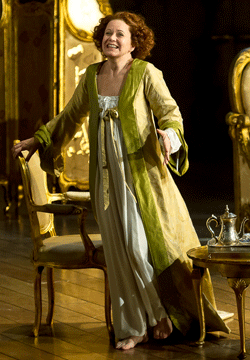 Amanda Roocroft as The Feldmarschallin
Amanda Roocroft as The Feldmarschallin
A single backdrop suffices: a curving Regency interior, slightly past its prime but still offering elegant evidence of the stylish sophistications of yesteryear — much like the Marschallin herself. Gilt and bronze drapes, curling creepers and cobwebbed chandeliers create a fairy-tale otherworldliness, and this is enhanced by Paule Constable’s clever lighting which, evoking subdued candlelight — the front of stage decked with row of crumbling candles (which Valzacchi snappily switches on at the start of the Mariendal scene) — establishes an ethereal distance. And, in the fading light of Act 1, a deepening, looming shadow of the Marschallin provides a visual echo of the ‘former’ self whose passing she laments.
McVicar’s direction judiciously mixes dense and intricate movements — as during the spooking of Ochs in the inn scene, when tumblers and goblins cavort and cartwheel wildly across the stage — with gentler gestures which flow as organically as Strauss’s score, particularly in the closing moments. The extremes of the wide stage are deployed to depict the emotional distance between characters; and at the close to emphasise the Marschallin’s isolation from the young lovers.
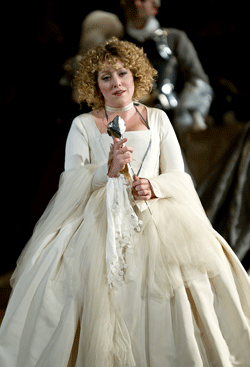 Sophie Bevan as Sophie
Sophie Bevan as Sophie
John Tomlinson’s Baron Ochs of Lerchenau is a Falstaffian scally-wag, with all the bluff, swagger and ultimately forgivable self-interest of his Shakespearean predecessor. We may cringe at his hapless fumbling after any helpless female within arm’s reach; find his empty boasts and groundless vanity infuriating and his class-obsessed condescension distasteful. But, his candid self-knowledge and readiness to greet defeat with big-hearted generosity win our tolerance, tenderness and even, in the end, our pity. This is a comic turn par excellence, one which fortunately does not lapse into caricature; and, the humour is never achieved at the expense of musical control or accuracy. A master of crisp diction, Tomlinson’s every syllable is crystal clear. Weighty but flexible, his bright, gleaming tone is a joy, and it loses none of its gloss as he descends to the depths of his register. It may be a little over-strained at the top, but who cares? This Ochs relishes the amorous games even if they end in a rout; and Tomlinson’s complete delight in the theatrical and musical world which encompasses him is equally apparent.
As the elegant Marschallin, Amanda Roocroft is regal of bearing and radiant of voice; if she doesn’t quite have the velvety roundness of the ideal Straussian heroine, she uses light and shade to movingly reveal the Marschallin’s insecurities, the piano reflections of her Act 1 monologue wistfully conveying muted resignation.
The lustrous spin of Sophie Bevan’s response to the bestowal of the silver rose would melt the shining breastplate of even the most cold-blooded Rosenkavalier. Bevan captures both the tempestuousness of the feisty adolescent and the nascent serenity of the mature woman within. This Sophie is no slight soubrette; and in the Act 3 trio the Marschallin clearly recognises her rival’s powerful charm and determined will.
Sarah Connolly inhabits the eponymous envoy’s breeches with total authority, utterly convincing as the excitable young romancer who learns that the path of true love never quite runs smooth. By turns ebullient and grave, bullish and wistful, Connolly has unostentatiously mastered every nuance of character, even adopting a convincing rural brogue for the Act 3 deception of Ochs. Particularly resounding in her upper register, Connolly’s doubtful hesitation when forced to choose between past and future loves is painfully touching.
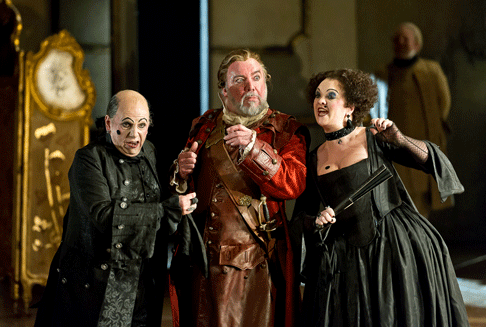 Adrian Thompson as Valzacchi, Sir John Tomlinson as Baron Ochs and Madeleine Shaw as Annina
Adrian Thompson as Valzacchi, Sir John Tomlinson as Baron Ochs and Madeleine Shaw as Annina
A master of comic timing, Andrew Shore is typically impressive as the exasperated Herr von Faninal; Shore alone matched Tomlinson in his use of the text, though as his partner-in crime, Annina, Madeleine Shaw is confident and vocally arresting. And, there are many fine performances from those taking the smaller character roles, including Jennifer Rhys-Davis as Sophie’s chaperone — her urgent proddings with her fan keep her young charge firmly in line during her conversation with the rose bearer — and Gwyn Hughes Jones who produces a stunning Italianate glean as he entertains the Marschallin in Act 1 (and whose petulant flounce and pout indicates his irritation when his star turn is prematurely halted!). Ericson Mitchell is rather older than the prepubescent boys who are usually cast to play Mohammed, the Marschallin’s page, and I’m not sure his crafty retrieval of Sophie’s handkerchief and bold final bow to the audience really captures the cheeky breeziness of the closing bars of the score; but his presence does add an edgy touch of adolescent knowingness to the goings-on in the Marschallin’s boudoir.
Edward Gardner's reading of Strauss’s wonderfully evocative score is expansive and luscious. He creates an opulent but airy bed of sound through which a multitude of minutiae effortlessly reveal themselves: sinuous, seductive clarinet coils; impassioned horn commentaries; rising celli climaxes. Tempi are at times quite idiosyncratic — the final trio is slow, and Och’s waltzes wistfully elongated — but this complements, rather than negates, the dramatic flow. This is superb orchestral playing with scarcely a note out-of-place or ill-judged; the precision of chamber music within a vast orchestral canvas.
Claire Seymour
image=http://www.operatoday.com/Rosenkavalier_ENO_2012_3.gif image_description=Sarah Connolly as Octavian [Photo by Clive Barda courtesy of English National Opera] product=yes product_title=Richard Strauss: Der Rosenkavalier product_by=The Feldmarschallin: Amanda Roocroft; Octavian: Sarah Connolly; Baron Ochs: John Tomlinson; Valzacchi: Adrian Thompson; Annina: Madeleine Shaw; Sophie: Sophie Bevan; Herr von Faninal: Andrew Shore. Conductor: Edward Gardner. Director/Set Designer: David McVicar. Costume Designer: Tanya McCallin. Lighting Designer: Paule Constable. English National Opera, London, Wednesday, 1st February 2012. product_id=Above: Sarah Connolly as OctavianPhotos by Clive Barda courtesy of English National Opera
Weill: Die sieben Todsünden
The performances certainly extended beyond typical concert length, not helped by a ten-minute delay in beginning, and more to the point, the programme rather felt as if there were one too many piece. How, then, fared what for many was presumably the main attraction, Anne Sofie von Otter in The Seven Deadly Sins? Patchily, I am afraid. There were several problems, but most of all von Otter herself, whose performance seemed quite misconceived. From the opening of the Prologue, her reading lacked edge, seeming far too well-mannered. There is not a single way to perform this repertoire, and not everyone is Lotte Lenya – indeed, of course, no one else is – but, despite the microphone, von Otter sounded either ill at ease or merely pleasant (as in the second of the sins, ‘Stolz’). The performance seemed more an example of that most dubious of enterprises, ‘classical crossover’, than social critique. Oddly, on the occasional instances when she ditched her microphone, vocal production sounded more idiomatic. As for the would-be cool foot-tapping in ‘Zorn’, let us not dwell upon it. The gentlemen of Synergy Vocals were on far better form, though I am not sure that the nature of the amplification helped them. Theirs at least added an edge quite lacking elsewhere, rendering the Family’s hypocritical bourgeois morality all the more repellent. Perhaps surprisingly, Michael Tilson Thomas’s conducting of the London Symphony Orchestra was also rather tame, at least for a good two-thirds of the work. ‘Faulheit’ at least brought something of a wind band sonority, but for much of the performance, the pleasantness of Anna – whether I or II – had apparently proved contagious. In ‘Habsucht’ and ‘Neid’ there was at last some splendid orchestral playing, the LSO properly given its head, the results redolent of Mahagonny, even if Weill is here perhaps a little too obviously imitating his former self. The encore, ‘Speak low’ was preferable in every respect: everyone seemed more relaxed, and there was a far surer grasp of idiom.
At the beginning of the concert, Danse sacrée et profane had mysteriously replaced the advertised Last Pieces, Debussy as orchestrated by Oliver Knussen. LSO principal, Bryn Lewis, gave a good account of the harp part, though Tilson Thomas alternated between the deliberate and the subdued, especially in the first dance. The second showed its kinship to Ravel, but was perhaps overly moulded by the conductor. Holloway’s 2002 orchestration of En blanc et noir, by contrast, proved a revelation. The opening movement brings a glittering edge, at first not especially Debussyan – though it does not seem that Holloway is trying to be so – but perhaps more school of scintillating Dukas. As time went on, flashes and more than flashes, of Debussyan orchestral sonority manifest themselves: informing, but not controlling. This is certainly no attempt at pastiche. The second movement is, unsurprisingly, darker in hue, though not without metallic, militaristic glitter. A poignant trumpet solo lingers in the memory. Likewise the vivid realisation of the confrontation between Ein’ feste Burg and the Marseillaise: almost Ivesian, but better orchestrated. In the final movement, I fancied that I heard, albeit briefly, creepy shades of Bartók, supplanted by Ravel – and that is praise indeed for any orchestration.
La mer, which concluded the programme, opened promisingly, with a fine sense of ‘emerging’, all sections of the LSO on excellent form. ‘De l’aube à midi sur la mer’ flowed well, apparently on the swift side, but not to its detriment. However, by the time we reached the brass fanfares – included, doubtless to the chagrin of some, though I have no problem with them – doubts had begun to set in. So much was a little, and sometimes more than a little, too brash, and I do not think it was just a matter of the Barbican acoustic. Similarly, the glitter of ‘Jeux de vagues’, at first stimulating, soon seemed a little de trop. La mer was veering dangerously close to mere orchestral showpiece, as would be confirmed by the final movement, in which the conductor had it approximate to a decent film score. Direction was present, throughout, to be sure: there was no meandering. And there were some ravishing woodwind solos. But Debussy is so much more interesting, so much less straightforward, than he sounded here. Let us hope that Tilson Thomas does not resolve to tackle Pelléas.
Mark Berry
image=http://www.operatoday.com/Von_Otter.gif image_description=Anne Sofie von Otter [Photo by Carl Bengtsson / DG] product=yes product_title=Kurt Weill: Die sieben Todsünden; Claude Debussy: Danse sacrée et profane; En blanc et noir (orchestrated by Robin Holloway); La mer. product_by=Anne Sofie von Otter (mezzo-soprano), Bryn Lewis (harp), Synergy Vocals (Paul Badley, Gerard O’Beirne (tenors), Michael Dore, Paul Charrier (basses)), London Symphony Orchestra, Michael Tilson Thomas (conductor). Barbican Hall, London, Thursday 2 February 2012. product_id=Above: Anne Sofie von Otter [Photo by Carl Bengtsson / DG]Orchestre Philharmonique de Marseille Taps Foster
By Frank Cadenhead [Opera Today, 8 February 2012]
Los Angeles born conductor Lawrence Foster, the music director of the orchestra and the Opéra National in the French city of Montpellier from September 2009 to the end of this season, has signed on for a similar post with the Orchestre Philharmonique de Marseille starting September 1 of this year.
Lawrence Foster Named Music Director of Orchestre Philharmonique de Marseille
Foster’s contract, for four years, comes just in time for Marseilles as it will be a “European Cultural Capitol” for the year 2013 and the cultural institutions will be in the international spotlight. He is scheduled for fifteen weeks in the Mediterranean port city originally founded by the Phoenicians and will conduct, along with concerts, two productions at the Opéra. He is currently at the Opéra in Marseilles conducting a new production of Henri Sauguet’s “La Chatreuse de Parme” which opens tonight.
Marseilles is either the second or third largest city in France, depending on whether you ask someone from Lyon or Marseilles. Foster will conduct the January concert inaugurating the 2013 festivities in Marseilles with violinist Laurent Korcia. Along with the appointment of Foster, the city also named Italian conductor Fabrizio Maria Carminati as the principal guest conductor.
Foster, 69, continues as the musical director of the Foundation Gulbenkian Orchestra in Lisbon. He has been conductor of the Barcelona Symphony Orchestra, the Aspen Festival, the Monte-Carlo Philharmonic the Lausanne Chamber Orchestra and the symphony orchestras of Jerusalem and Houston.
Frank Cadenhead
image=http://www.operatoday.com/Lawrence_Foster.gif image_description=Lawrence Foster [Photo by Marc Ginot] product=yes product_title=Lawrence Foster Named Music Director of Orchestre Philharmonique de Marseille product_by=By Frank Cadenhead product_id=Above: Lawrence Foster [Photo by Marc Ginot]February 7, 2012
Teatro di San Carlo Appoints Luisotti
By Frank Cadenhead [Opera Today, 7 February 2012]
February 7, 2012. Italian conductor Nicola Luisotti, the popular music director of the San Francisco Opera, has been appointed to the same position at the historic Teatro di San Carlo in Naples.
Nicola Luisotti Named Music Director of Teatro di San Carlo
Luisotti, 50, who also is the principal guest conductor of the Tokyo Philharmonic, succeeds English conductor Jeffrey Tate with immediate effect.
The Tuscan-born conductor will take over the historic San Carlo Theater, one of the oldest opera houses in Europe. The theater itself underwent a complete restoration in 2010.
The appointment of a widely-respected conductor like Luisotti is another indication of the general renaissance of Italian opera houses after the success, over the past five years, of Milan’s La Scala in raising the artistic level and expanding the season in the face of dramatic reductions in government subsidies.
A press conference on March 7th will announce details of the appointment. He will be in Naples to conduct Verdi’s “I Masnadieri”
Frank Cadenhead
image=http://www.operatoday.com/F.-Nicola-Luisotti.gif image_description=Nicola Luisotti [Photo by Terrence McCarthy] product=yes product_title=Nicola Luisotti Named Music Director of Teatro di San Carlo product_by=By Frank Cadenhead product_id=Above: Nicola Luisotti [Photo by Terrence McCarthy]February 6, 2012
L’Enfant et les Sortilèges and La Navarraise in Monte-Carlo
Even without this automotive hardware Monaco may still have been magical eighty-seven years ago when Maurice Ravel and Colette conjured a strange little comédie musicale, L’Enfant et les Sortileges for this very opera house. These days Colette’s singing cats, clocks, teakettles, etc., only sometimes recapture the magic that is said have surprised, puzzled and perturbed the monégasques (those rich enough to sojourn in Monaco) back in 1925.
Happily all of L’Enfant’s reputed magic was again present in the Salle Garnier, brought alive by Monaco’s fine Orchestre Philharmonique responding to the remarkable precision of narrative detail and intonation imposed by conductor Patrick Davin. Ravel’s score shone as the masterpiece of orchestral colors and musical wit that has won it huge respect and exposure in musical circles.
If you are among those who find people impersonating animals, objects or elements (there is a big piece for a soprano named “fire”) amusing this fine new production by the Opéra de Monte-Carlo’s general director Jean-Louis Grinda might have disappointed you. As it was we were not required to suspend disbelief for a second. It was the household staff of Mamam (the quite imposing Béatrice Uria-Monzon in full Coco Chanel regalia) who went to a great deal of trouble to terrorize Mamam’s little darling while Mamam went out for the evening.
This alone made the entertainment adult and saved us from having to rediscover the-child-that-is-in-all-of-us. In fact it was a pleasure to get back at the naughty little brat (convincingly portrayed by Swiss mezzo Carine Séchaye) by dreaming up mean and clever tricks. Cats were made by shadow puppetry and sung by their puppeteers, three household staff (very fine dancers) executed nifty slimy choreography (by Eugénie Andrin) that kept the torture relentless. The household maitre d’ actually appeared in the clock and the governess climbed atop the armoire to sing the Princess’ lament.
This realistic staging revealed the charm of this little story by the famously unconventional Colette and let us hear Ravel’s brilliant score with the eyes and ears of adults of presumed intelligence and wit. These attributes are in fact the magic of Colette and Ravel’s amusing trifle, not its fantastical characters. These were forty-five riveting minutes.
The French speaking audience (where were the Italians and the Russians?), obviously mature and certainly well-healed paid 15 euros per flûte de champagne at intermission where they were far more animated than at the perfunctory applause awarded the entertainment.
L’Enfant et les Sortileges is a chamber work of childish sentiment detailed by a very large orchestra. It is of ideal proportion to the Salle Garnier. Its companion piece, Massenet’s La Navarraise is an emotional blockbuster that was sonically stuffed into this intimate theater where it suffered a dismal production.
This brief piece attempts to impose the emotional force of Italian verismo onto French sentiments familiar to us through Alexander Dumas fils’ La Dame aux Camélias and Mérimée’s Carmen. The big blow, that hallmark of pristine verismo, was the gypsy girl’s suicide over the corpse of her lover. This final moment was very noisily presaged in the opening battle scene and by the challenge of her lover’s father that she match his dowry. She was then accused of treason, the tenor sang a great big aria and there was an even bigger battle scene.
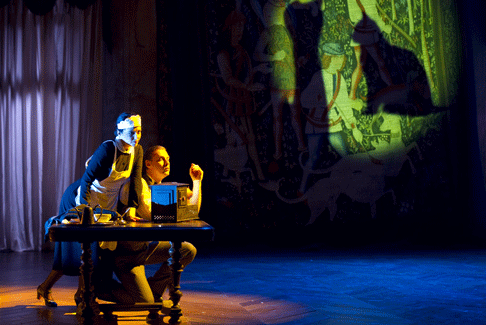 Scene from L’Enfant et les Sortilèges
Scene from L’Enfant et les Sortilèges
It would be hard for anyone to remain aloof from all this violence and maestro Davin certainly was not. He urged his orchestra to sing out full voice, and encouraged his singers to give everything they had. And they all did. We understood why this piece was once popular and no longer is. It is too loud and too short, a blatant and naive imitation of Cavalleria Rusticana by a capable composer who knew what the London public wanted back in 1895.
The Opéra de Monte-Carlo did Masennet’s little escapade full justice with French mezzo Béatrice Uria-Monzon, a famous Carmen who has essayed Tosca as well, as the Navarraise — a more ideal singer for this heroine of a verismo manqué cannot be imagined. Spanish tenor Enrique Ferrer was Araquil, her lover, negotiating the role’s high tessitura at continuous forte levels with apparent ease, adding the easy swashbuckle that cost him his life. Canadian baritone Jean-Françoise Lapointe was a dynamic lieutenant of beautiful voice, however baritone Marcel Vanaud as the father Remigio did not rise to sufficient vocal or histrionic stature to have motivated such a tragedy. Earlier in the evening Mr. Vanaud had portrayed a fine chair and a successful tree.
Michael Milenski
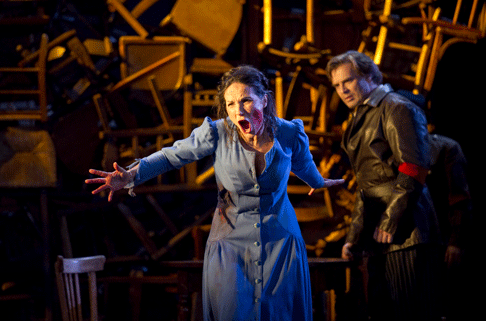 Scene from La Navarraise
Scene from La Navarraise
Anita (la navarraise) — Anita (la navarraise): Béatrice Uria-Monzon; Araquil: Enrique Ferrer; Garrido: Jean-François Lapointe; Remigio: Marcel Vanaud; Ramon: Guy Gabelle; Bustamante: Philippe Ermelier.
Salle Garnier. Chorus of the Opéra de Monte-Carlo; Orchestre Philharmonique de Monte-Carlo. Conductor: Patrick Davin. Mise en scène: Jean-Louis Grinda. Scenery: Rudy Sabounghi. Costumes: David Belugou. Lighting: Laurent Castaingt. (January 25, 2012). product_id=Above: L’Enfant et les Sortilèges
Photos © Opéra de Monte-Carlo
February 4, 2012
Chad Shelton Comes to the Rescue
Bryan Hymel, a native of New Orleans, stepped in to save the day. He could, however, only sing the first two performances because he had a catch a plane to sing the Prince in Dvorak’s “Rusalka” at London’s Royal Opera.
Texas-born tenor Chad Shelton, who started in Houston with the opera’s Young Artist Program and has since sung on major stages in America and in Europe, sang the role last Wednesday night and will, hopefully, complete the run which ends February 12 at the Wortham Theater Center.
Frank Cadenhead
image=http://www.operatoday.com/Chad_Shelton.gif image_description=Chad Shelton [Photo by Jill Hunter] product=yes product_title=Houston Here: Lend Me a Tenor product_by=By Frank Cadenhead product_id=Above: Chad Shelton [Photo by Jill Hunter]Houston Here: Lend Me a Tenor
By Frank Cadenhead [Opera Today, 4 February 2012]
February 4, 2012. A few days before the opening of the production of Verdi’s “La Traviata” at the Houston Grand Opera, tenor David Lomeli, playing Alfredo, took ill. Bryan Hymel, a native of New Orleans, stepped in to save the day. He could, however, only sing the first two performances because he had a catch a plane to sing the Prince in Dvorak’s “Rusalka” at London’s Royal Opera.
SFO Faces Deficit
By Frank Cadenhead [Opera Today, 4 February 2012]
February 4, 2012. With a budget of $71 million dollars, the San Francisco Opera announced a deficit for the FY 2011 year. But the numbers, in the Opera’s press release, contain some good news to offset the negative bottom line. The deficit, some $1.8 million, according to the annual audit, was largely the result of increases in operating costs of over 9%. The opera’s general manager, David Gockley, declared that “steps will continue to be taken between 2013-2016 to reduce expenses, increase annual contributions and augment the endowment.”
San Francisco Opera — Bad News Tempered by Good
The deficit, some $1.8 million, according to the annual audit, was largely the result of increases in operating costs of over 9%. The opera’s general manager, David Gockley, declared that “steps will continue to be taken between 2013-2016 to reduce expenses, increase annual contributions and augment the endowment.”
The 10-opera season under question is one with a heavy load: the summer saw their production of Wagner’s “Ring Cycle” — always a costly project — and the economy remains “tough and turbulent.” But glimmers of good news provided some hope. Operating revenue grew from $27 million to almost $36 million and ticket sales increased 32%. Also, over 11,000 donors contributed some $33.3 million to the operating costs.
The board of directors endorsed the management of Mr. Gockley and noted that the opera’s endowment as of July 31 of last year, $138.4 million is almost double what it was when he arrived six years ago. Said George Hume, the board president, “San Francisco Opera faces serious long-term challenges to its business model, as many classical music organizations do nationwide. At the end of the day, the board firmly believes that having an internationally renowned opera company in San Francisco is part of what makes the Bay Area one of the most special places in the world.”
Frank Cadenhead
image=http://www.operatoday.com/david-gockley.gif image_description=David Gockley product=yes product_title=San Francisco Opera — Bad News Tempered by Good product_by=By Frank Cadenhead product_id=Above: David GockleyFebruary 3, 2012
Werner Güra Sings Schubert, Wigmore Hall
There always will be more opera fans than Lieder fans, and operatic performance is easier to relate to than the more introverted values of art song. So perhaps in a few years the true art of Lieder will be obliterated. But Lieder and opera are different genres, with different values. Lieder is a Germanic tradition which has its roots not in entertainment so much as in the communication of ideas closer to philosophy and spirituality. Significantly, many great Lieder singers come from a background in Bach. Lieder is an inward art of contemplation, where the action isn’t in a role or external plot but takes place in the soul.
Werner Güra first appeared at the Wigmore Hall many years ago, when William Lyne discovered him through Peter Schreier, Güra’s mentor. Superlative recommendations. I remember that concert, when young Güra was so overawed by the formidable reputation of the Wigmore Hall that he tried too hard to please, and didn’t put enough of himself into his performance, though one could hear why Schreier and Lyne were so impressed. Lieder is not about pleasing anyone. It’s about emotional integrity and finding a way into each song that’s uncompromisingly from within. Years later, Güra’s vigorous shock of hair has turned grey, but reflects how he has matured as an artist. Güra and Vignoles chose popular Schubert songs but presented them with intelligence.
Schubert writes so lyrically that’s it’s easy to miss the depths of irony in his music. The lilting melody in Alinde (D904, 1827) is deceptive. Utter sweetness of tone, which Güra sang with exquisite grace. Schubert respects the poet’s device, where the protagonist asks the same question of people he meets, lulling the listener into thinking this is no more than strophic convention. But each answer is evasive. The answer only comes when the protagonist confronts himself: “Von allen Lebend’gen irr ich allein, bang und beklommen”. Vignoles’s playing captured the idea of piano as lute, but this song is no serenade. Güra doesn’t need to exaggerate the twist in the song, other than by shading his voice at the critical word “Da” in the last verse.
In the early Der Fischer (D225, 1815, Goethe) Schubert’s rippling notes describe the sparkling surface of the waters by which the fisherman sits, waiting for a catch. Then a watersprite emerges, scolding him for not respecting her realm. When the rippling melody begins again, Güra lowers his voice so you can “hear” the fisherman, willingly being drawn into the waters and what they symbolize. Again and again, this is a theme in Romantic poetry, which Schubert understands so well — waters as metaphor for the unconscious, for creative renewal beneath surface glitter.
Goethe was Schubert’s favourite poet but he set almost as many poems by Johann Mayrhofer. Schubert’s strange, difficult friend’s text of Der Schiffer (D536, 1817(?)) shows another aspect of Mayrhofer’s style. This time, the boatman is sailing through a storm, but he’s defiant, though soaked to the bone, alert to the dangers of whirlpool and reef. Vignoles evokes the waves vividly, so Güra’s voice rises confidently above the tumult. “Ich hasse ein Leben behaglich entrollt”, he sings (I hate a snuggly enfolding life) and later sings with firm resolve, “Dem Sturme zu trotzen mit männlicher brust” (to brave the storm with a manly heart).
Der Wanderer (D493,1816, Georg Schmidt von Lübeck) is one of the most iconic Lieder of all. The wanderer is an existential loner. “Ich bin ein Fremdling überall”. Psychic emptiness evoked in the dark opening chords, then searching, straining legato. “Wo bist du, wo bist du, mein geliebtes Land?” Güra sang the changing moods with heartfelt sincerity. That floating “immer wo”! There are many superlative performances of this song, but this ranked with the best, for Güra expressed the devastating inner landscape so well. “Dort, wo du nicht bist, dort ist das Glück!”. (there, where you are not, is happiness). Nothing theatrical, but tinged with the dignified pain of experience.
Schubert was one of the first composers to discover Heinrich Heine, and Heine’s ironies inspired some of his finest work. Güra and Vignoles surpassed themselves in the six Heine Lieder from Schwanengesang (D957, 1828). Heine’s Fischermädchen turns the fisherman/nature spirit concept upside down. Perhaps this time the fisherwoman is discovering sensual delights. The charm of the song lies in its purity which Güra sang with genial warmth. Die Stadt was luminously beautiful, yet chilling, for the vision the poet sees is surreal. What waters are those he’s sailing? Where is he heading? Schubert’s setting is nebulous, as if sea and horizon are blurred, as is memory. Güra and Vignoles captured the emotional heart of this song, so nebulous and ambiguous it could almost have been written today.
Big, dramatic songs like Der Atlas and Der Doppelgänger lend themselves to overstatement, and heavy voices need exaggeration to kick them into life, but that doesn’t mean it’s idiomatic. The true horror in these songs, which lies in their psychological truth. The Doppelgänger isn’t a character, he’s a vampire only in spirit. “Still ist die Nacht” sang Güra, sibilants sharply sinister, consonants cutting. Stillness is fundamental to this song, whose interpretation depends on sensitive observation. Güra’s voice curls menacingly, to emphasize the protagonist’s psychic dislocation. Güra shapes the climaxes so they feel like stifled cries of agony, too awful to face. Hence the fragmenting personality, and the significance of the pauses between notes, which Vignoles brought out so well. Schubert’s insight is amazing. Only the shallow hear shallow in Schubert. Güra spits out the words “Du, Doppelgänger!” as if confronting the apparition, “du bleicher Geselle!”. But it’s the final line that really counts, whispered almost sotto voce, “so manche Nacht, in alter Zeit”. With subtle tenderness, Güra reminds us that the protagonist once had a human past, so its annihilation is all the more terrifying.
Anne Ozorio
image=http://www.operatoday.com/Werner_Gura.gif image_description=Werner Güra product=yes product_title=Werner Güra Sings Schubert product_by=Werner Güra, tenor; Roger Vignoles, piano. Wigmore Hall, London, 31st January 2012. product_id=Above: Werner Güra
An Aria of Lincoln Center — The Metropolitan Opera
The building’s first production was Faust in 1883 and the last performance was La Bohème on April 16, 1966. Akin in style to the prominent opera houses of Europe, many were understandingly upset about the destruction of this “landmark” building, in which Enrico Caruso, Ezio Pinza and many other great artists performed.
The “new” Met was dissimilar from the original. Architectural plans were drawn in 1956, and groundbreaking began in 1961. Architect Wallace K. Harrison, recognized for high-rise office buildings, was assigned to the project. It needed to blend in with the surrounding structures slated to be a world-class performing arts hub, designated as Lincoln Center.
Harrison opted for modernism in a low-rise complex totaling 97,700 sq. It would contain an auditorium, a small hall, extensive lobby, private offices, as well as a restaurant and gift shop.
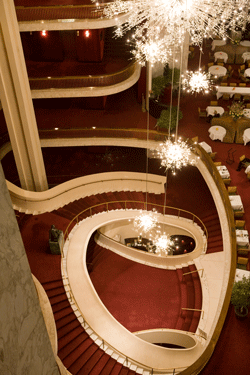 The lobby of the Metropolitan Opera House in New York City. [Photo: Marty Sohl/Metropolitan Opera]
The lobby of the Metropolitan Opera House in New York City. [Photo: Marty Sohl/Metropolitan Opera]
Much of the facade was composed of concrete and masonry work. The focal point remains as five majestic arches resting on six “rectilinear” concrete columns. Reaching 96 feet in height and 35 feet in width within pre-cast shells, the striking curves in glass enhance the building’s front exterior and inner lobby.
Two murals by Marc Chagall, The Triumph of Music and The Sources of Music were commissioned for the Met to fill the immense open space of the lobby. They are visible not only from within the premises, but can be admired from the outside, near Lincoln Center’s fountain in the courtyard.
An abundance of gleaming white marble, gold leafing and cascading crystal chandeliers that illuminate a grand marble staircase in the foyer completed its inner decor.
Rumor has it that the architect, Harrison, handed the crystal chandelier designer, Hans Harald Rath, a book on the “Big Bang,” and requested he should use it as inspiration for their design.
The stage is highly mechanized and the auditorium holds a total capacity of 3,995 (3800 seating, plus 195 standing room).
The final cost for the project was $46 million. The glittering results became the perfect New York symbol for a night at the opera.
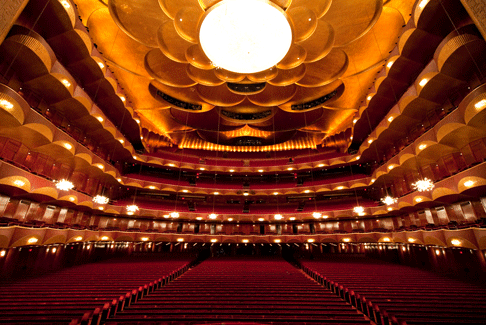 The auditorium of the Metropolitan Opera House in New York City. [Photo: Jonathan Tichler/Metropolitan Opera]
The auditorium of the Metropolitan Opera House in New York City. [Photo: Jonathan Tichler/Metropolitan Opera]
September 16, 1966 was the opening night gala with Antony and Cleopatra by composer Samuel Barber. Although reviewers found fault with the production and appearance of the structure, one thing excelled that couldn’t be ignored — the acoustics. Every note the orchestra played and the stars produce was heard with clarity, no matter where seated.
Opera greats, such as Plácido Domingo, Joan Sutherland, Marilyn Horne, and more recently, Elīna Garanča and Vittorio Grigolo have graced audiences clamoring “Bravo.”
Under the direction of James Levine, the 2012 season offers that much desired Met repertoire favorites including Madam Butterfly, Faust, Tosca, La Traviata and others. Lesser known compositions, such as The Makropulos Case and The Enchanted Island complete a blend of a well-rounded season, running until May 12.
Afterwards, the celebrated opera company goes on hiatus. However, the Metropolitan Opera House doesn’t remain dark. The American Ballet Theatre takes center stage, followed by various touring ballet companies before a new opera season begins.
Tours are accessible all-year-round to explore the behind-the-scenes. “Meet-the-Artist” is an innovative concept in which singers and musicians answer questions from visitors.
Planning a Visit:
The Metropolitan Opera House box office is situated in the lobby and tickets can be purchased Monday–Saturday 10am–8pm, Sunday noon–6pm
The venue can easily be reached via public transportation.
By Subway: Take the number1 (7th Ave local train) to 66th Street/Lincoln Center Station.
By Bus: The M5, M7, M10, M11, M66 and M104 bus lines all stop on 66th Street and Broadway (one block away).
Find accommodations near the Met by visiting NewYorkHotels.org. Securing a hotel near Central Park (on the West Side) will be within walking distance to Lincoln Center.
Veronica Shine
The Metropolitan Opera is not responsible for the content of this article.
image=http://www.operatoday.com/METOPERAHouse.gif image_description=An exterior view of the Metropolitan Opera House in New York City [Photo: Marty Sohl/Metropolitan Opera] product=yes product_title=An Aria of Lincoln Center — The Metropolitan Opera House product_by=By Veronica Shine product_id=Above: An exterior view of the Metropolitan Opera House in New York City [Photo: Marty Sohl/Metropolitan Opera]February 2, 2012
Salome, San Diego
There’s purity and Godliness too — all overlapping and jammed together so intensely into your eyes and ears, that when the curtain comes down you can be left gasping.
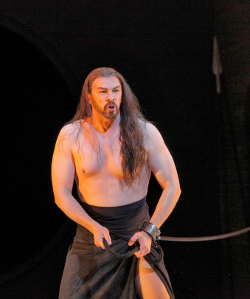 Greer Grimsley as Jochanaan (John the Baptist)
Greer Grimsley as Jochanaan (John the Baptist)
Salome is a spoiled young Princess, the daughter of Herodias and step-daughter of Herod. Upon hearing the voice of the imprisoned John the Baptist (here called Jochanaan), she tempts Narraboth, a young soldier who loves her, to release him. Obsessed with Jochanaan, she is furious when he refuses to look at her, unmoved when Narraboth kills himself. As her reward for dancing for Herod she insists on having Jochanaan’s head. The extraordinary concluding scene of the opera begins as Salome waits fretfully for the prophet’s head to be brought to her, and ends in an insane frenzy when she kisses the prophet’s mouth, and Herod screams to his soldiers, “Kill that woman.”
Gustave Flaubert created an equally John-obsessed Salome in his story Herodias which formed the basis for Jules Massenet’s opera Herodiade. There’s no doubt Wilde knew Flaubert’s story. He wrote Salome in French in 1891 while living in Paris. An English translation (which Wilde disliked) was prepared by Lord Alfred Douglas, Wilde’s 20-year old lover, in the hope of staging the play in London with Sarah Bernhardt. Alas, British censors forbade the presentation of biblical characters on stage. Germany, however, was not so strait-laced. The play in a German translation by Hedwig Lachman so transfixed Richard Strauss that he began working on it immediately.
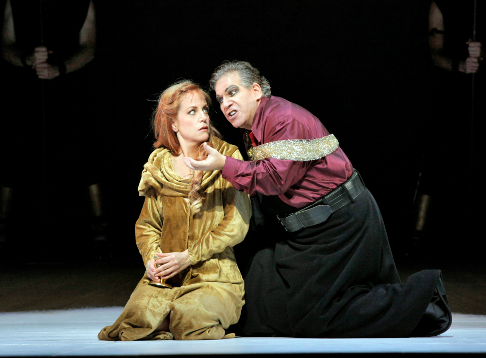 Lise Lindstrom as Salome and Allan Glassman as Herod
Lise Lindstrom as Salome and Allan Glassman as Herod
The opera’s first performance took place in Dresden, Germany in December 1905. Austria took more time. The Viennese court opera refused to produce the work, but the directors of the small opera house in Graz, assured that this “ultra-dissonant biblical spectacle, based on a play by a British degenerate whose name was not mentioned in polite company,” would produce a succès de scandale, agreed to the presentation. Its performance on May 16, 1906 proved a huge social and musical occasion. Strauss conducted. Giacomo Puccini, Gustav and Anna Mahler, Arnold Schoenberg, Alexander Zemlinsky and Alban Berg were among the composers present. The work was an instant success.
San Diego Opera’s production of Salome began life as a joint venture of Opera Theatre of Saint Louis, San Francisco Opera and L’Opéra de Montréal. First performed in 2009, it was created and directed by choreographer Seán Curran with lighting and costumes by Bruno Schwengl.
The success of this difficult work depends largely on the talent and stamina of a soprano who looks like a teen age virgin, and who can sing over a huge brass-heavy orchestra as easily as that other operatic virgin, Brunhilde. Strauss’ original orchestra called for a hundred and twelve musicians and included the newly invented Heckelphone, plus a harmonium and organ (both off stage). He eventually reduced the orchestra size. Even so, San Diego squeezed seventy musicians into its pit. Happily, its all star vocal cast met the challenges of their roles.
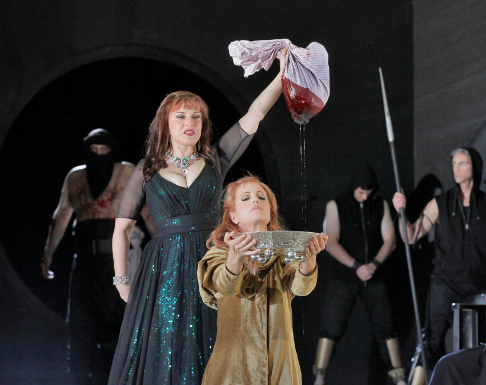 Irina Mishura as Herodias and Lise Lindstrom as Salome
Irina Mishura as Herodias and Lise Lindstrom as Salome
Lise Lindstrom’s soprano with its tender vibrato in middle voice, blossoms to silvery at the top with an edge that at once youthful and strong enough to ride the orchestral waves. Fiddling with her long hair and biting her nails, she gave a convincing portrayal of a spoiled young princess, was admirably feline in her pursuit of Jochanaan, and graceful in the not very voluptuous dance created by Curran. Bass-baritone Greer Grimsely was a resounding Jochanaan, clearly tempted by the young girl, and convincing as he tried vainly to move her to compassion. Mezzo soprano Irina Mishura’s Herodias, though well sung, was not a commanding presence. Someone should have told her not to wave her wrists around like a hapless housewife. Neither she, nor Allan Glassman, who sang gloriously as Herod, seemed like people capable of running an empire. I can only assume it was the direction that turned them into a pair of restless, ditzy characters. Tenor Sean Panikkar was compelling as the enraptured Narraboth.
Despite the excellent voices, sadly I was not as out breath as I would like to have been when the curtain descended. Part, I think can be attributed to the staging of the last moment of the opera in which Salome is on her feet, as though considering her deed, rather than being fully immersed in the horrid act that Herod is seeing and that the orchestra is describing. Steuart Bedford’s conducting too, often lost focus on the emotions that this hideous tale should evoke. The simplest example perhaps relates to the moments during which Salome is waiting for Jochanaan’s head — waiting to hear his scream, waiting for his body to fall. The only music Strauss gives us at first are B flats ticking unevenly in the bass.
The notes and intermittent silences, followed by the subsequent undulating comments of the woodwinds should have been chilling enough to make my skin crawl. They weren’t. Even at its screeching heights the orchestra often lacked tension and energy.
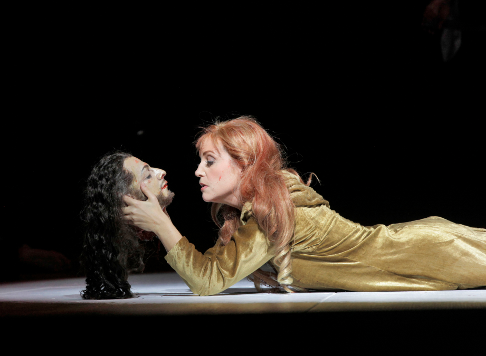 Lise Lindstrom as Salome
Lise Lindstrom as Salome
I am never happy to see a Salome without a moon. Wilde told Bernhardt that the moon had a leading part in the play. Directors who ignore the moon, ignore the poetry and imagery of the play. There are thirty-two mentions of “moon” in Wilde’s play, fifteen of “mond” in the libretto. A page described the moon the moment the curtain rises. “How strange the moon seems. She is like a woman rising from a tomb.” To which Narraboth responds, “a little princess who wears a yellow veil, and whose feet are of silver.” The moon’s appearances and disappearances move in relation to Salome’s actions. But there’s another reason I particularly missed the moon. The first musical note Strauss made on his copy of the Salome libretto was to set Salome’s key as C# minor, the key of the Moonlight Sonata. (Please don’t write to me, I know Beethoven didn’t give the sonata that name. But it had that name in Strauss’ time).
Finally, I’m also unhappy with Salomes in which only the five Jews are dressed in 21st century clothes with specifically identifiable Jewish religious accouterments. It’s both a stereotype and a cliché. A director who can do without a moon in Salome, can surely do without business suit and prayer shawls.
Estelle Gilson
image=http://www.operatoday.com/MG0322.png image_description=Lise Lindstrom as Salome [Photo by Ken Howard courtesy of San Diego Opera] product=yes product_title=Richard Strauss: Salome product_by=Salome: Lise Lindstrom; Jochanaan: Greer Grimsley; Herod: Allan Glassman; Herodias: Irina Mishura; Narraboth: Sean Pannikar. San Diego Symphony Orchestra. Conductor: Steuart Bedford; Director: Seán Curran: Scenic Designer: Bruno Schwengl; Costume Designer: Bruno Schwengl; Lighting Designer: Christopher Maravich; Choreographer: Seán Curran. product_id=Above: Lise Lindstrom as SalomePhotos by Ken Howard courtesy of San Diego Opera
Mahler: Das Lied von der Erde
The reasons for the lag in the release are not explicitly stated, but the timing coincides with the centenary of the composer’s death. That aside, the recording captures the sense of a live performance in reproducing some spirited moments of the performance along with some unfortunate weaknesses. As much as the score is well known since its premiere almost a century ago, Das Lied von der Erde remains a difficult work to execute for various reasons, including balances between the orchestra and soloists, dynamic extremes, and phrasing. It is not so much a problem with Mahler’s scoring, as it is the demands that exist in the music itself, which requires an intensity that is sometimes best achieved in the studio.
In this recording, Jadwiga Rappé offers a romantic approach to the songs for lower voice, and in interpreting the work has a dark sound often colored with vibrato. The result is quite personal-sounding, an effect accentuated by the close miking that sometimes allows Rappé to overbalance the orchestra, which in the recording sounds artificial. Rappe’s coloring detracts, at times, from the aesthetic distance which some performers use in the second of the alto’s songs, “Von der Schlönheit” (“Of Beauty”), opening and closing with melismas which set the tone for the text and contrast the extroverted music in the center of this piece. The middle section here is spirited enough, with the orchestra sometimes so involved that cohesiveness seems challenged.
This is not the situation with the orchestra in the opening song for the tenor, “Das Trinklied von Jammer der Erde” (“Drinking Song of the Earth’s Sorrow”). In this piece, the orchestral accompaniment sometimes impinges on Kusiewicz’s solo lines. Kusiewicz’s tenor voice is somewhat darker and lower than some other singers who have recorded the part. At times Kusiewicz offers a more declamatory approach to the music, especially in the penultimate song “Der Trunkene im Frühling” (“The Drunkard in Spring”). As much as the interpretation underscores the text in its expression of purposeful drunkenness, it is occasionally at the expense of the implicit lyricism.
The final song, “Der Abschied” (“Farewell”), which occupies as much time as the other five pieces, is a tour de force for alto, and here Rappé makes a valiant effort in conveying the complexities that result from Mahler’s motivic approach to the vocal line and the transcendent text he chose to set. Zilm’s interpretation of the piece is sometimes understated, with the opening gesture quieter and less percussive than some choose. The performance sometimes seems at times more atmospheric than accurate, with the whole giving a sense of performers who are nevertheless captivated by the music in their efforts to express it.
James Zychowicz
image=http://www.operatoday.com/Mahler_lied_erde_Dux0810.png
image_description=Dux 0810
product=yes
product_title=Gustav Mahler: Das Lied von der Erde
product_by=Jadwiga Rappé, alto; Pietr Kusiewicz, tenor. Polish National Radio Symphony Orchestra Katowicz, Michael Zilm, conductor.
product_id=Dux 0810 [CD]
price=$15.65
product_url=http://astore.amazon.com/operatoday-20/detail/B004VO7SQK
Mozart’s Die Zauberflöte at Lyric Opera of Chicago
Tamino and Pamina, the pair who must undergo separately tests of purification, were sung by Charles Castronovo (debut) and Nicole Cabell. The Queen of the Night, mother of Pamina, featured Audrey Luna (debut) and Evan Boyer assumed the role of Sarastro, since Günter Groissböck was announced as indisposed for the performance reviewed. Stéphane Degout (debut) and Jennifer Jakob were a musical and dramatic delight as Papageno and Papagena. Sir Andrew Davis conducted with attention to nuance while maintaining always a sense of the whole. During the overture Davis encouraged a terse interplay among the strings with a measured drive forward. Pauses were effective at transitional moments just as shifting tempos were integrated to give significant shaping to the overture.
The three ladies of the Queen of the Night acted and sang as a splendid trio. Once Tamino’s calls for help prompt their arrival and slaughter of the serpent pursuing him, the ladies moved in unison yet each doted individually over the unconscious hero. Elisabeth Meister as the First Lady led the ensemble with her focused soprano binding the vocal line as she encouraged a report to the Queen of the Night. Cecelia Hall and Katherine Lerner were equally entertaining in their attempts to remain vocally and physically in the presence of Tamino. When the latter awakens, he is met of course by Papageno who accepts credit for having delivered the hero from danger. In his introductory aria, “Der Vogelfänger bin ich ja” [“I am indeed the birdcatcher”], and ensuing dialogue Stéphane Degout combined a lyrical confidence with delightful swagger in acknowledging the unfounded recognition. As his discussion with Tamino is interrupted and punished, when the three ladies returned, Degout’s Papageno displayed his protests with convincing pantomime. In control of the stage once again, the three ladies present Tamino with a portrait of Pamina. In reacting to the portrait Castronovo’s performance of “Dies Bildnis ist bezaubernd schön” [“This portrait is magically beautiful”] displays lyrical heft and beauty of tone while some of the louder pitches could be rounded or softened to express the magical attraction. The entrance of the Queen of the Night and her first bravura aria provided Ms. Luna with opportunities to show her vocal facility [“O zittre nicht, mein lieber Sohn” (“O do not tremble, my dear son!”)]. Luna’s dramatic high notes on “Ach helft!” [“Oh help!”] were especially effective, these being followed by practiced runs in the famous coloratura passages. After Tamino and Papageno receive their magical instruments, flute and glockenspiel, from the ladies, they are instructed to follow the lead of the three Knaben [“youths”] to find the path to Pamina and rescue her from the palace of Sarastro.
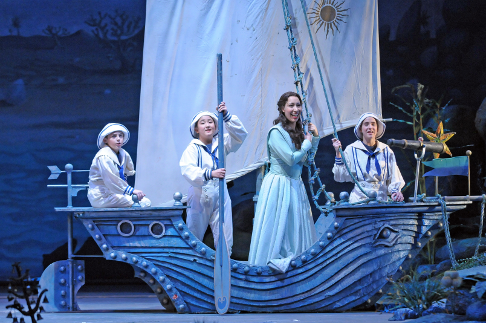 Nicole Cabell as Pamina
Nicole Cabell as Pamina
At the first appearance of Pamina under the guard of Monostratos, Nicole Cabell projected a noble demeanor on lines such as “Der Tod macht mich nicht beben” [“Death does not make me quake”]. In the ensuing duet with Papageno, “Bei Männern welche Liebe fühlen” [“For men who truly sense love”], Ms. Cabell sang expressive, arching lines while Degout truly came into his own with a superbly resonant tone and appropriate legato. In the following scene Tamino searches for the entrance to Sarastro’s palace, in order to confront the alleged captor, just as Papageno leads Pamina in search of the flute’s response. Ms. Cabell’s encouragement to speak only the truth (“die Wahrheit”) rang out in pure high tones in preparation for the entrance of Sarastro. Mr. Boyer’s assumption of this role communicates the requisite weight of authority, and his distinctive and well developed low register contributes to a seamless vocal technique. His dramatic approach might be enhanced at this point in the action in order to signal the gravity of the forthcoming initiation.
Preparatory ceremony and eighteenth-century dress are emphasized in this production at the start of Act Two as both Pamina and Tamino are given instruction toward their trials of purification. Mr. Boyer’s Sarastro and the chorus assumed here solemn tones in keeping with the following ritual scenes. The interplay of power between the Queen and Sarastro focuses now on Pamina. Ms. Luna projected accelerating coloratura intensity in her aria “Der Hölle Rache” [“The wrath of Hell”] as she encouraged her daughter to kill Sarastro. Mr. Boyer’s subsequent rendition of “In diesen heil’gen Hallen” [“In these hallowed halls”] displayed excellent breath control with rounded bass emphasis fully audible. The final two highlights of this act belonged indeed to Ms. Cabell and Mr. Degout. Pamina’s “Ach, ich fühl’s” [“O, I feel it”] in response to Tamino’s enforced silence was performed with emotional commitment, skillful diminuendo, and further vocal decorations emphasizing the heroine’s plight. In Papageno’s “Ein Mädchen oder Weibchen” [“A maiden or a wife”] Degout acted and sang with genuine ardor, while he climbed onto the stage following his search through the aisles of the audience. In this scene Degout captured the essence of both the character and the music as he embellished his yearning lines with tasteful appoggiatura. In keeping with this performance Papagena was a fitting reward.
Salvatore Calomino
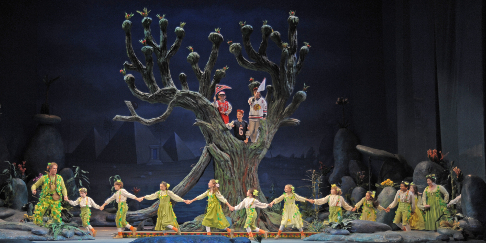 Scene from The Magic Flute
Scene from The Magic Flute
Photos by Dan Rest/Lyric Opera of Chicago
Jonathan Harvey’s Wagner Dream
How satisfying to see such a full Barbican Hall for the UK premiere of Jonathan Harvey’s opera Wagner Dream. The premise of the opera is at once simple but devastatingly effective: a group of actors play Wagner and the people who surround him in his final hours, and they play out their parts on the uppermost level of the stage; as Wagner dies after a row between himself and Cosima about Carrie Pringle, an ex-Flower Maiden and ex-lover, he sees the events we see on the middle level, the opera Die Sieger (“The Victor”) that Wagner had planned. This is the Buddhist story of Prakriti, her love for the monk Ananda and the consequences of that thwarted love (Tristan, anyone?). The Buddha is able to explain Prakriti’s actions via references to her previous lives, but there is dissent when it is suggested that Prakriti join the previously male-only Buddhist order, mainly from the Old Brahmin. The Buddha accepts her; the action shifts back to Wagner’s time; the worlds collide though when it is Vairachana that guides him towards the next life (the dying Wagner himself had been seeing the characters throughout — none of the people around him, Cosima, the Doctor and so on, could).
Harvey’s grasp of drama is impeccable. The work lasts one and three quarter hours (there is no interval) and thanks to Harvey’s pacing, there is no sense of longeur. There is a sense, however, of underlying timelessness. Staging is sparse, but effective: the Wagners and their floral interloper have an austere table and chairs. The conception of austerity chimes perhaps with the overall feeling of ritual, underlined by pillars of smoke that emanated from both sides of the stage as the audience entered. The players of the BBCSO processed on stage as if about to begin a holy act (and perhaps they were). Surtitles were used, but only after the onset of the Buddhist story.
The vast stretch of Harvey’s available compositional resources was impeccably utilised. Tonal sections made great effect (a lullaby, for example) and yet did not jar in the slightest, instead appearing as just one element in the composer’s palette. The music shares with Wagner’s an ability to take the listener out of temporal time into the composer’s expanded time, and, as with Wagner, the time spent experiencing this piece seemed somehow telescoped, as one became intimately involved with the events and their musical realisation. One one level it felt as if we had been there years; on another, it was a mere moment.
Harvey’s use of electronics is by now ingrained into his mode of discourse, and the electronics emerged as the logical extension of the sound of the orchestra, taking their sounds and manipulating them not only timbrally, but in space as well. The inclusion of a choral concert the previous evening meant we were able to hear the ensemble passages linking back to that, a stylistic equivalence underlined by the programming of the weekend. Yet it was the moments of almost unbelievable beauty that Harvey was able to conjure up from his forces that will linger long in the memory, perhaps most notably his setting of Prakriti’s significant words “Love is strength, Love is beauty”.
While the acting was excellent, it was the singing that truly impressed. As the all-important Prakriti, the experienced Clare Booth excelled, her voice miraculously pure. As seductress, one has to ask if she is a Harvey equivalent to Kundry. Interactions with the creamy-voiced Hilary Summers (Mother) were a joy, and Harvey’s disjunct lines posed no problems to the vocalists. Only Andrew Staples’ tenor was, initially, disappointing — rather on the nasal side. Yet he seemed to relax into the role. Matching Booth for top accolades was Roderick Williams as the Buddha. Williams has a voice of gold. His declamation and presence were simply stunning.
Bass Richard Angas has lost none of his authority, and he projected the Old Brahmin, so stuck in the old ways’ rules, with real strength and conviction, while bass-baritone Simon Bailey made a fine fist of Vairochana. Martyn Brabbins’ conducting was beautifully confident, and the BBCSO responded by reminding us all why they are without parallel in demanding contemporary music. Alas, illness prevented the composer himself from attending. But there is no doubting that this weekend confirmed Harvey’s status at the head of British music, and similarly there is no doubting that this performance of Wagner Dream was the highlight of this mini-festival.
Colin Clarke
image=http://www.operatoday.com/Jonathan-Harvey.png image_description=Jonathan Harvey product=yes product_title=Jonathan Harvey: Wagner Dream product_by=Claire Booth: Prakriti; Roderick Williams: Buddha; Hilary Summers: Mother; Simon Bailey: Vairochana; Andrew Staples: Ananda; Richard Angas: Old Brahmin; Actors: Nicholas Le Provost: Wagner; Ruth Lass: Cosima Wagner; Julia Innocento: Carrie Pringle; Richard Jackson: Dr Keppler; Sally Brooks: Betty/Vajrayogini. BBC Symphony Orchestra/Martyn Brabbins. Director: Orpha Phelan. IRCAM Computer Music Designer: Gilbert Nuono. IRCAM Sound Engineer: Franck Rossi. Designer: Charlie Cridlan. Barbican Hall, London, 29th Jabuary 2012. product_id=Above: Jonathan HarveyLiceo Opera in Financial Crisis
By Frank Cadenhead [Opera Today, 2 February 2012]
Confronting a financial shortfall, the Gran Theatro del Liceo in Barcelona has announced a reduction in performances this season with two scheduled operas cancelled.
Barcelona’s Liceo Opera in Financial Crisis
A double-bill of Zemlinsky’s A Florentine Tragedy and The Dwarf plus performances of Debussy’s Pélleas et Méllisande have been scratched as well as ballet evenings, concerts and a recital by soprano Nina Stemme.
The theater has suffered from a cut in government subsidies of 15% both this year and last along with sagging sponsorship income. In an effort to cut 3.7 million Euros from this year’s budget, the theater will close from March 20 through April 10 and again from July 5 through August 8 for a total of 56 days. Salaried employees will be on unpaid leave for those periods. The box office will offer refunds, exchanges and donation opportunities for tickets to cancelled events. These reductions are likely to create some problems with business sponsors since tickets to upcoming performances are a usual benefit for donors.
Ticket sales have remained fairly steady, reports general manager Joan Francesc Marco but the cuts in government support came at the same time as business sponsorship has been in decline. Opera workers and others have blamed Marco for bad management and the drop in sponsorship.
Frank Cadenhead
image=http://www.operatoday.com/Liceo.png image_description=Gran Teatro del Liceo product=yes product_title=Barcelona’s Liceo Opera in Financial Crisis product_by=By Frank Cadenhead product_id=Above: Gran Teatro del LiceoBayreuth Festspielhaus
The building is showing its age, having been completed originally in 1872, and problems include a leaky roof and the crumbling red brick facade.
The festival sponsors will fund a master renovation plan which should be available in March. A figure of 20 million Euros was an earlier estimate of needed repairs. The original wooden interior of the stage and auditorium area has been replaced by concrete and steel in the 1960s.
Frank Cadenhead
image=http://www.operatoday.com/Wagner-Festspielhaus_Bayreuth1995.png
imade_description=Wagner-Festspielhaus in Bayreuth
product=yes
product_title=Bayreuth’s Festspielhaus Needs Repairs
product_by=By Frank Cadenhead
Bayreuth’s Festspielhaus Needs Repairs
By Frank Cadenhead [Opera Today, 2 February 2012]
In an interview, Katharina Wagner, 33, granddaughter of the composer and co-director of the Richard Wagner Bayreuth Festival, spoke of the declining state of the legendary Festival House on the “Green Hill” at Bayreuth. The building is showing its age, having been completed originally in 1872, and problems include a leaky roof and the crumbling red brick facade.
February 1, 2012
Emmerich Smola Prize Awarded
By Frank Cadenhead [Opera Today, 1 February 2012]
A Swiss soprano and an Australian baritone shared the 20,000 Euro Emmerich Smola Prize awarded on Monday. The Swiss soprano Chiara Skerath, 23, was born in Belgium and trained at the National Conservatory in Paris and the University of Music and Dramatic Arts with Claudia Visca. Baritone Derek Welton, born in Melbourne in 1982, studied at the University of Melbourne and received musical training at the Guildhall School in London.
The Smola Prize
The Swiss soprano Chiara Skerath, 23, was born in Belgium and trained at the National Conservatory in Paris and the University of Music and Dramatic Arts with Claudia Visca. Baritone Derek Welton, born in Melbourne in 1982, studied at the University of Melbourne and received musical training at the Guildhall School in London.
The prize, since 2004 recognizing promising talent, is named in honor of the long-term director of the SWR Radio Orchestra of Kaiserslautern. The competition was held in the town of Landau with the German Radio Philharmonic of Saarbrücken Kaiserslautern conducted by Guillermo Garcia Calvo.
image=http://www.operatoday.com/Smola.png
image_description=Emmerich Smola
product=yes
product_title=Emmerich Smola Prize Awarded
product_by=Frank Cadenhead
product_id=Above: Emmerich Smola